3 Module 2: Histories of East Asia
📍Make sure to check the Additional Media Playlist at the end of the Module. Many videos or articles will enhance your understanding of the written text and offer new insights on East Asian Humanities.
INTRODUCTION
This unit presents a historical overview of events in the history and cultural development of East Asia from the perspective of each area: China, Korea, and Japan. Each section begins with a discussion of basic themes in the history of the cultural area then outlines and details important events and cultural developments throughout history. The goal of this module is to present a more thorough portrait of each area, highlighting trends, events, historical figures, and timeframes that are useful in understanding each culture independently, and how each culture contributes to the idea of East Asia as a whole.
CHINESE HISTORY
PART 1: OVERVIEW
Chinese history is long and complex—with records dating to around 1600 BCE. Although the histories of Egypt and the Middle East are considerably older, cultural threads, exemplified in written language, architecture and other aspects of material culture, beliefs, and custom clearly link contemporary China to a distant past—more so than most contemporary cultures today. That cultural legacy has been at times a burden, but more often serves as a valued pool of philosophical, material, and spiritual traditions.
PART 2: THEMES IN CHINESE HISTORY
Among the important themes that characterize Chinese history are the pattern of dynastic rise and fall, intermittent aggression from northern peoples beyond the borders, varying degrees of openness to outside cultural influences, and the dynamics of stability and social harmony. All these themes still bear on China’s stance and position in the world today. Being aware of China’s history and traditional culture will enable us to better understand events presently unfolding in the country.

Dynastic Rise and Fall
The Chinese record their own history as a succession of ruling dynasties that begins with the legendary Xia dynasty (2100-1600 BCE), and ends in 1911-12 CE with the formation of the Republic of China—which was soon followed by the establishment of the People’s Republic of China in 1949. A dynasty is a succession of kings or emperors of the same family line. Although by the Qin dynasty (221-207 BCE) officials were appointed—eventually by participation in an examination system—the role of emperor was hereditary, passed down in a succession that, according to Chinese ideals, was from father to son. In many cases, however, after an emperor died or abdicated other relatives, and, on a few occasions, even non-blood relatives occupied the throne. Although Chinese history is regarded as a succession of dynasties, during certain parts of Chinese history the land area we call China today was under the control of several different kingdoms. After the fall of the great Han dynasty around 220 CE, for example, China fell apart into many smaller kingdoms and was not reunited until over three hundred years later by the short, but powerful Sui dynasty (580-618 CE). During the Song dynasty (960-1279 CE), invading northern peoples set up the Jin and Liao kingdoms in northeast China, and a large kingdom of Tibetan-related peoples called Xixia existed in western China. Therefore, when thinking about Chinese history, it is important to imagine it as a complex picture of unity and disunity over an exceedingly long time span.
In a general sense, there was a pattern of dynastic rise and fall, often reflected in historical accounts, poetry, and other literature of China. According to the pattern, a dynasty follows 5 stages: 1) it is founded by force during a period of disorder; 2) vigorous rulers create a stable, prosperous state that secures or extends the borders; 3) after a period of success and stability (which often entails population growth), leadership declines, wealth concentrates into fewer hands, and the population outstrips resources; 4) the dynasty collapses due to internal uprisings—sometimes coupled with foreign invasions; 5) after a period of weakness and disunion, the cycle starts again with dynamic leadership (sometimes foreign, as in the case of the Mongols and Manchus), often in a climate of lowered population and redistributed wealth.
This theme of dynastic rise and fall resonates especially strongly in the Han, Tang, Song, Ming, and Qing dynasties. Many poets used allusions to patterns and events in past dynasties to comment on situations in their own times. Even today modern Chinese look back on their history as they attempt to make sense of their emerging nation.
Aggression from Northern Peoples and Other Non-Han States
Relations, often antagonistic, between nomadic Turkic and Mongol peoples of the northern steppes and forests and the settled agriculturalists of the North China Plain go back far into antiquity. Among the northern invaders were the Xiongnu and Xianbei, who were followed in later centuries by the Qidan (Khitan), Jurched, Mongol, Turk, and Manchu (Manju/Manzu) peoples. During periods of division, small states appeared and disappeared in northern China on the borders with the steppes. This was especially so between the Han and Tang dynasties. During this time many such states had mixed “Creole-cultures” that combined both steppe and sedentary cultures and lifestyles. Among these peoples was a group known as the Toba, whose descendants were among the founders of the great Tang dynasty.
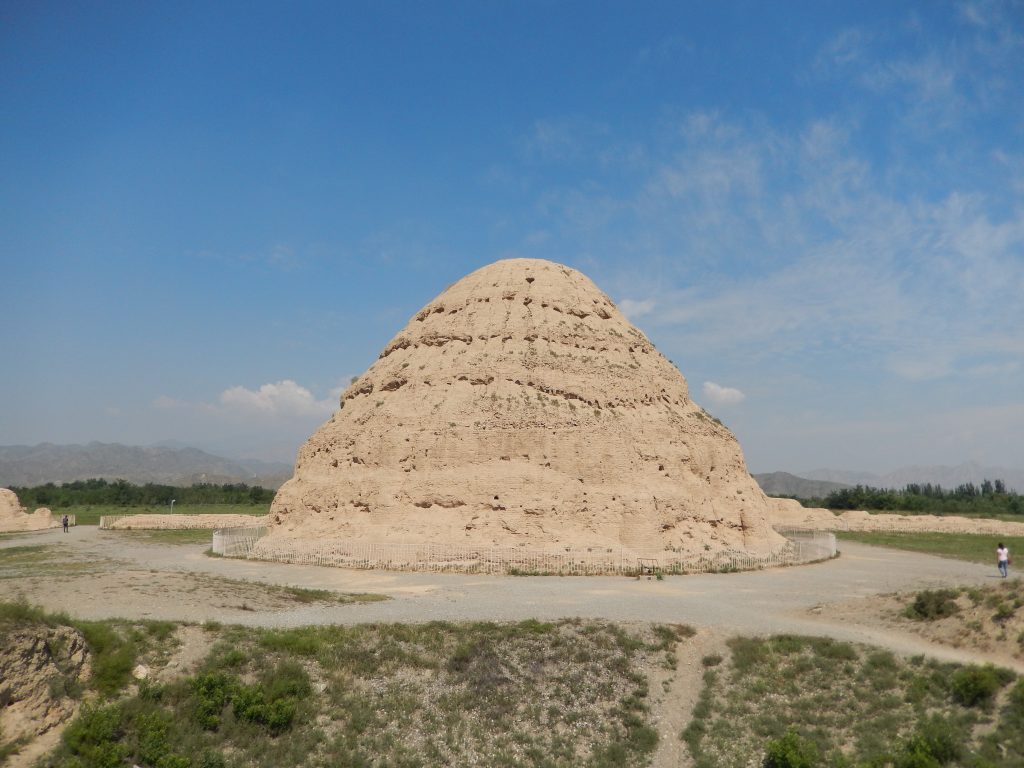
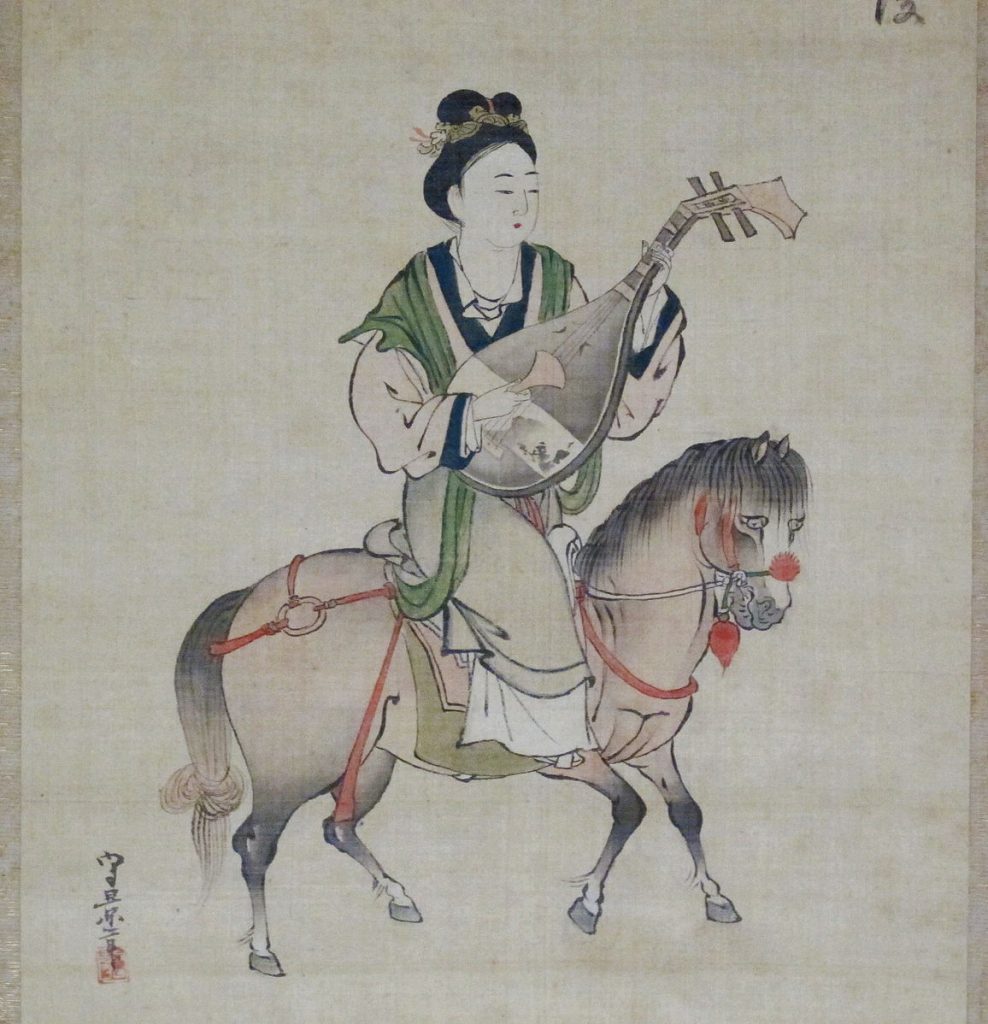
Besides the northern steppes and northeastern forests, alien states existed at times in other border areas. Among these were the Tibetan empire in the west, the Nanzhao in the southwest, the Tangut (Xixia) empire of the northwest (in present-day Ningxia), and the Uygur kingdom farther to the northwest in Xinjiang. Many smaller kingdoms existed as well, including the little-known Balhae kingdom located in parts of present-day northeast China and North Korea.
Nomads on the northern steppe depended on trade with the agriculturalists for grain, cloth, metal tools, ceramics, and other items. In turn, the agricultural peoples desired promises of peace from raiding parties and demanded tribute in the form of horses, furs, gems, and other rarities from the steppe and forest nomads. In the course of diplomatic negotiations, Chinese states sometimes sent beautiful women from aristocratic or even from the imperial family as brides to far-off “barbarian” rulers on the steppe. One of the most famous was Wang Zhaojun of the Han dynasty, who lived many years among the Xiongnu. Her tomb mound lies near the city of Hohhot, Inner Mongolia.
In some cases, Chinese rulers attempted to play rival groups of “barbarians” against each other; at other times, the border peoples created alliances to attack China. When the Mongols invaded China they had to defeat the Jin, who had already conquered the northern part of the Song dynasty, as well as the Xixia kingdom in the northwest.

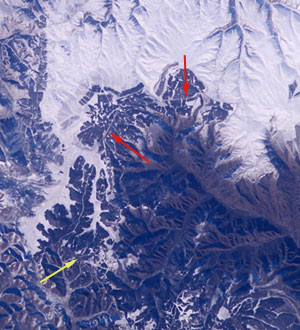
At certain moments the nomadic peoples feared the strong Chinese armies, at other times the steppe people offered great enough challenges to the Chinese to stimulate the building of walls on the northern frontiers—culminating in one of the greatest military projects of antiquity: the Great Wall. The wall, actually a series of smaller walls, reached its most advanced state during the Ming dynasty after the Mongols were driven from China.
Degree of Openness to the Outside
Due to its geographical location, China could limit contact with the outside world. Aside from the northern nomads (who were not a cultural threat to the Chinese), the deserts and mountains of the west and the oceans of the east allowed the Central Kingdom relative (and often peaceful) insulation from entities such as the Roman Empire, which was at its height during the Han dynasty. The Silk Road was a narrow thread across the northwest barrens that allowed a limited but steady flow of goods and ideas back and forth across Central Asia between the high cultures of the Mediterranean, the Middle East, India, and China. During the Tang period, China was at its most open stance in antiquity. Elements from the cultures of the West, particularly India, were welcomed and took root within China’s borders.
After the Mongol invasions of the 13th and 14th centuries CE, China was for the first time under complete foreign control. When the Mongols were finally driven out in the mid-14th century, the Han Chinese rulers of the new Ming dynasty were, not surprisingly, warier of foreign influences than emperors in the Tang period had been. By the mid-15th century, the Chinese had made voyages to the coast of Africa, but in an inward turn the Chinese ships of exploration were ordered burned by the emperor and the Great Wall was refurbished.
As China began to lose ground technologically to the West, the Manchus (a people from the northeast) invaded in 1644. Less than a century later, the British were warring with China to force the country open to its trade in opium, with rights to peddle the drug within China. By the turn of the 19th century, China was in danger of being cut to pieces by Western and Japanese imperialists. Over the centuries, ambivalence towards foreign contact developed. By the late 19th and early 20th centuries, the principle of “taking what is best” from the outside was developed in an effort to import positive things from the West while at the same time keeping out foreign influences thought to weaken or humiliate China and the Chinese people.
The most recent expression of this ambivalent open/shut dynamic was the near-total closure of mainland China to much of the outside world between 1949 and the late 1970s. Feelings derived from negative experiences with foreign contact still linger under the surface in China today.
Concerns of Government Stability

As is explained in more detail in Module 3, social harmony was a key component of the ideas of Confucian statecraft. According to this belief, if rulers and subjects alike acted in proper accord with their inherited positions and prescribed familial roles, all would be well with the realm. It was up to the ruler to set an example by behaving properly in order to preserve the supernatural permission—or right to rule—that had been granted to the dynasty. This was known as the Mandate of Heaven. If a ruler was out of sync with the heavens, then society was sure to follow suit. What was feared most in this ideal system was instability and chaos. Instability was the result of any number of factors, including famine, invasion, unfair conscription of laborers and troops, over-taxation, and incompetent, corrupt, or malicious rulers. When conditions become unstable, popular uprisings can result, which may prove difficult or impossible to quell.
According to legend, the empire of China’s first emperor, Qin Shi Huangdi, was brought down by a popular rebellion ignited by a group of workers on the Great Wall. Delayed because of a rainstorm, they were sentenced to death—but chose rebellion instead. In the first half of the 20th century, popular uprisings lead by Sun Yat-sen’s Nationalist Party brought down the Manchu government. Not long after, other popular forces, led by the Communists, took advantage of chaos within China caused by a weak central government, local warlords, and foreign invasion, to bring their movement to power over most of the territory in 1949. During the rule of Chairman Mao Zedong, particularly from 1966 to 1976, young minds and emotions were whipped into widespread chaos that endangered the stability of the country. Today, with an eye to the past, Chinese leaders must consider the effects of their policies in terms of state stability.
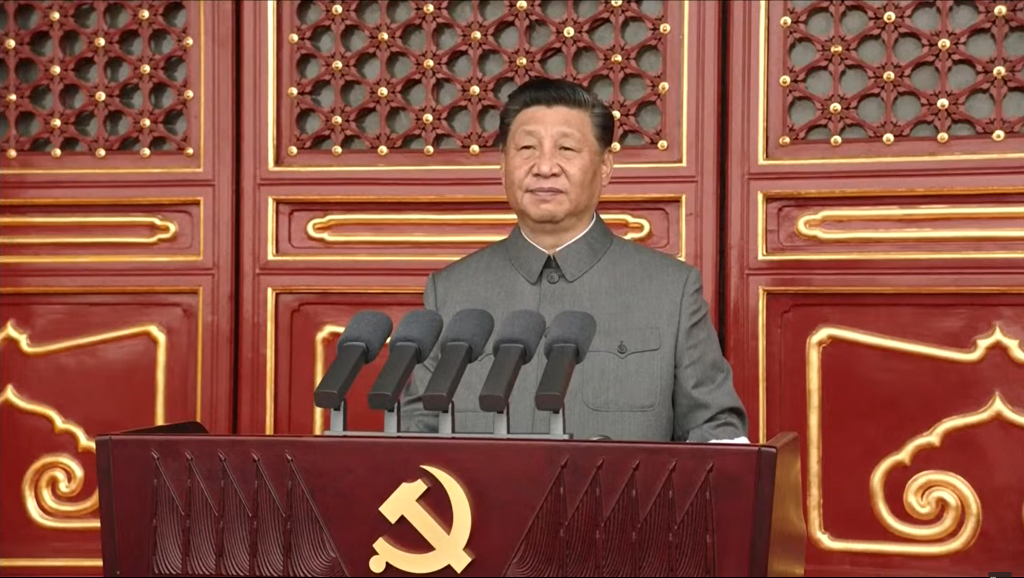
PART 3: PREHISTORIC ERA
Prehistory
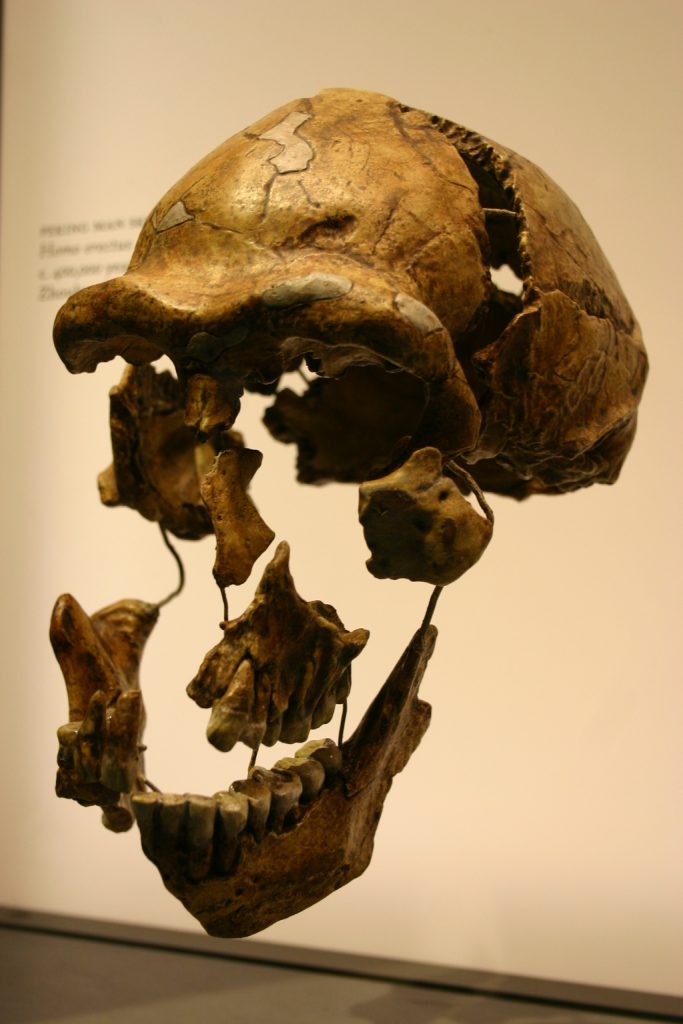 |
 |
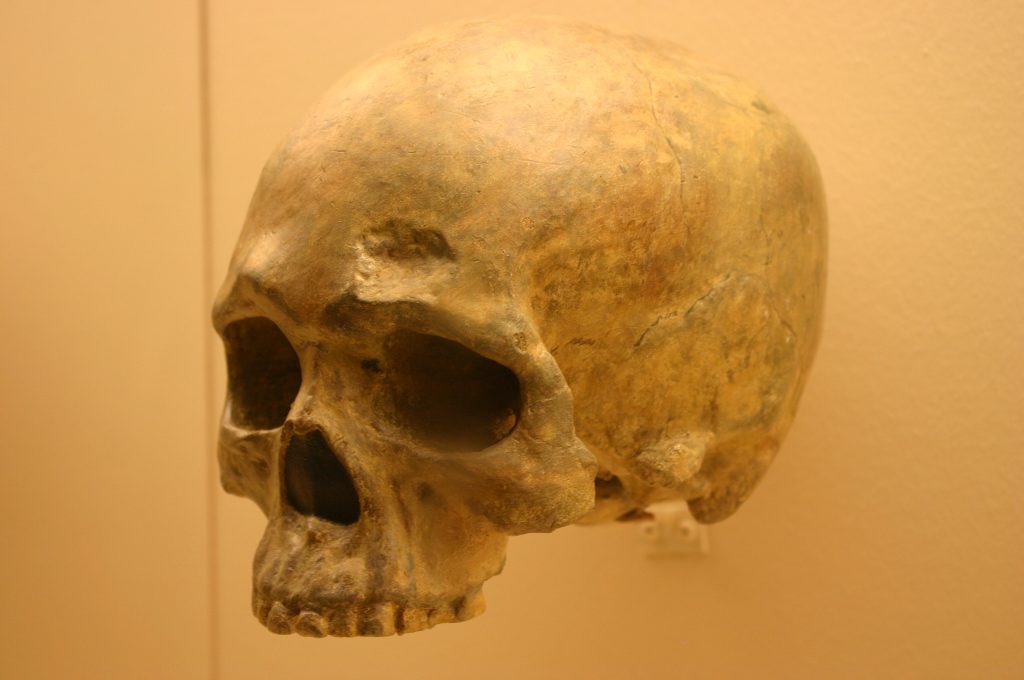 |
(Left) Bone fragments from a Peking Man skull. (Right) Liujiang Man’s fossil skull, found in Liuzhou, Guangxi. (Center) Artist rendering of “Dragon Man,” based on a huge skull found in northeast China near Harbin. |
||
Evidence of early hominids has been found at several archaeological sites in northern and southern China. The most famous of these is the so-called “Peking man” (once labeled Sinanthropus pekinensis), who seems to be a variation of Homo erectus, a widespread hominid who lived between one million and 250,000 years ago. Besides Peking Man (now called “Beijing Man”), similar fossils were found near Lantian in Shaanxi and near the city of Liuzhou, in the mountains of Guangxi. A number of sites with stone tools from early Homo sapiens have also been discovered in northern China, though the exact relation between these early modern humans and the Chinese people is still being examined. In 2021 a possible new human species, called “Dragon Man” (Homo longji) based on a large skull dating between 150,000 and 300,000 years ago, was made public by Chinese archeologist Ji Qiang. Some scientists have speculated the skull is that of the mysterious Denisovan human (an Asian contemporary of Neanderthals and early modern humans), though DNA testing may prove it to be a new species,
Neolithic, or “New Stone Age,” cultures featuring early forms of agriculture, weaving, advanced stone tool technology, village organization, and ceramics date to at least 6,000 BCE in China.
The best-known Neolithic sites are in northern China in the Yellow River drainage and include the famous “Banpo Village” site near the ancient city of Chang’an (modern Xi’an). The village was surrounded by a protective ditch that enclosed a number of round-shaped earthen pit dwellings and a pottery-making center.
Banpo village was a part of a larger agrarian culture called “Yangshao” that existed in the North China Plain and is characterized by unglazed yellow and red-colored pottery. Farther to the east, around the Shandong peninsula and farther south along the coast, was another early culture known as “Longshan.” Longshan culture was in many ways similar to Yangshao, though it is identified with a style of black pottery. Both the Yangshao and Longshan potteries are important examples of the earliest Chinese pottery.
 |
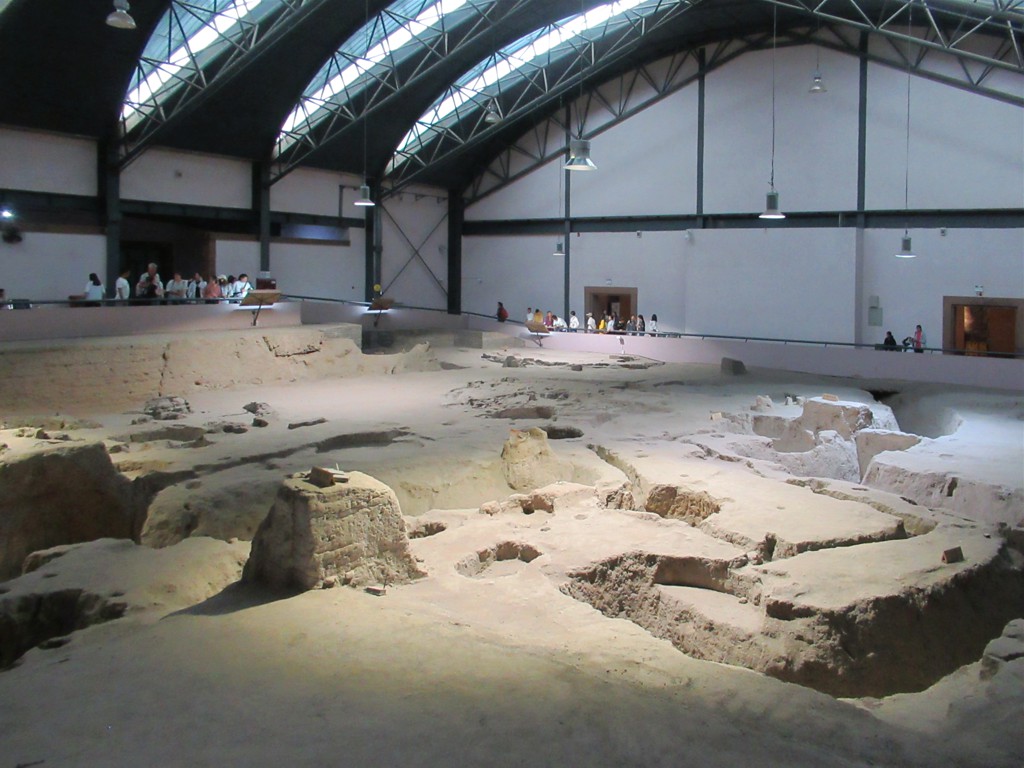 |
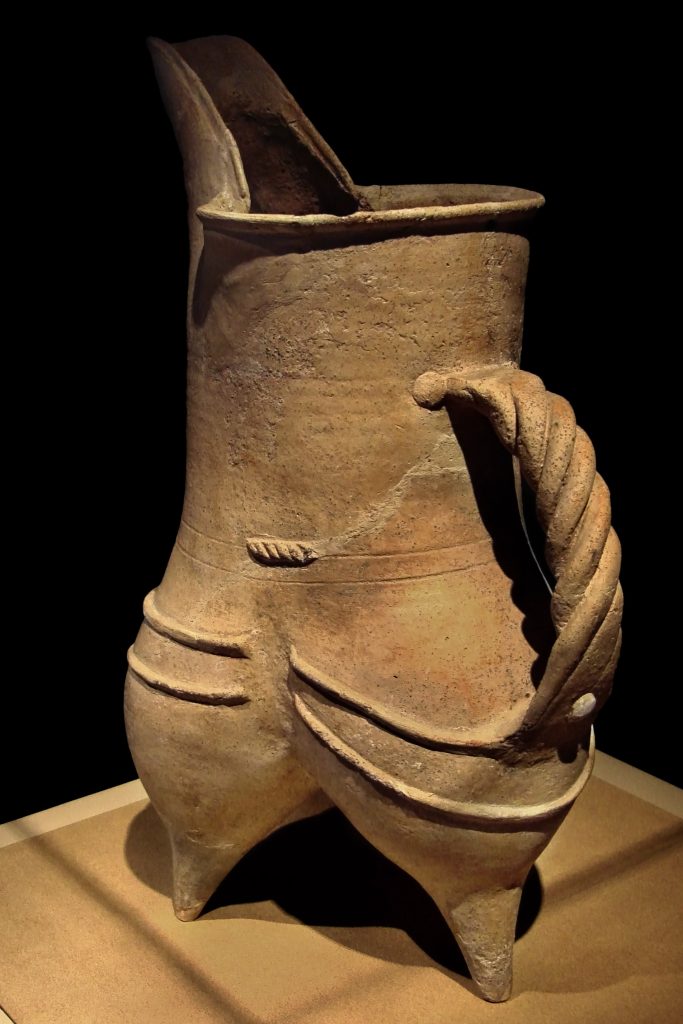 |
(Left) Yangshao pottery. (Center) Banpo Village Neolithic site in North China. (Right) Longshan pottery. |
||
Myth and Legend

Each cultural area in East Asia has mythical accounts of the creation of heaven and earth, human beings, and civilization. Records of Chinese creation myths date to the Han dynasty (though certain elements may be much earlier). According to the accounts, in the earliest times there was undifferentiated murkiness. As things progressed, the light-weight substances rose and the heavy settled, resulting in the heavens and earth. The body of an early being, Pan Gu, metamorphosed into a myriad of things, and thus the earth gained geographical features and was populated with plants and animals.
Among the early beings were the male Fuxi and the female Nuwa. Nuwa is credited with creating the first humans out of clay and Fuxi is said to be an early ruler. Other early rulers followed, including Shen Nong, who invented the plow and agriculture and the Yellow Emperor, who invented pottery and the civilizing technology of writing.
The early rulers Yao and Shun were regarded as model emperors because of their dedication to proper principles of succession and governing—with an emphasis on good leadership. Their successor was Yu, who is said to be the founder of the legendary Xia dynasty, supposedly founded in 2205 BCE. Both records from the Shang dynasty and archeological evidence suggest that Xia may have actually existed on the North China Plain, although teams of archaeologists have been searching for its remains for decades. No conclusive findings have been made, though Xia and Shang may have both been related to earlier Yangshao and Longshan cultures.
 |
||
 |
 |
 |
Han dynasty wall paintings and a Qing dynasty woodblock print of legendary figures: (upper left) Nu Wa and Fu Xi, holding a compass and a square; (upper right) Shen Nong, who tested hundreds of kinds of herbs to determine their use by humans; (lower left) Emperor Yao, a sage ruler who gave his two daughters to his successor Emperor Shun in marriage; (lower right) Emperor Yao’s daughters Ehuang and Nuying. |
||
PART 4: EARLY FEUDAL ERA
Shang Dynasty (1600-1100 BCE)
Like the Xia, the Shang dynasty was known only from historical records, until archaeologists uncovered ruins and tombs of the ancient Shang capital near Anyang in northern Henan province in 1927. Found also were over 100,000 animal scapulae and tortoise shells engraved with approximately 3,000 different written characters in the so-called oracle bone script. These are the oldest documented examples of fully-developed Chinese writing.
Historians today feel that Shang culture was likely similar to that of the earlier Xia kingdom and centered on dynasties of kings who presided over rituals and ruled over villages of peasant farmers. Remains of large tombs, and altars made using rammed earth technology (walls and foundations made by ramming wet earth within large molds—a practice still used to make adobe dwellings in parts of China today), indicate a high degree of social organization, as this was needed to produce these structures.
Writings from the Han dynasty indicate that there were 30 Shang kings, and that succession was passed from elder to younger brothers as well as from father to son. Shang beliefs seem to have centered on ancestral spirits and a god known in the records as Shangdi, or “upper ruler.” The ruler was thought to have direct links to the powers on high. Rulers presided over a number of ministers who helped direct affairs of the palace, the realm, and ritual, as well as ranks of civil and military officials. Although rulers were typically male, Fu Hao, the wife of one ruler, is said to have been one of Shang’s most able military generals.
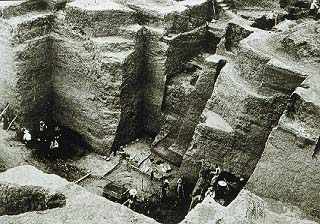 |
 |
 |
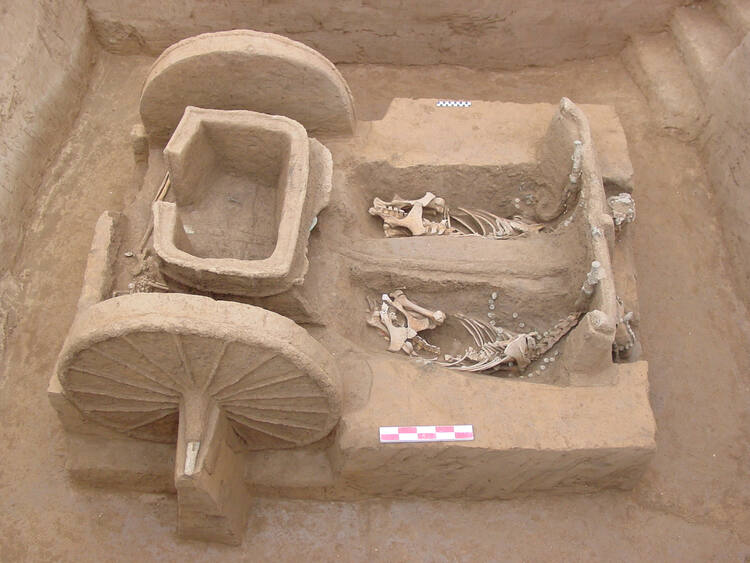 |
The tombs at Anyang indicate that sacrifice to the heavens and ancestors were an important part of Shang ritual life. Among the grave goods are sophisticated bronze ritual vessels, which were skillfully cast in clay molds using techniques first developed for pottery production. A common artistic motif on the bronzes was the “glutton” or taotie—a kind of supernatural beast with gaping jaws (see the design in the photo above). Offerings of food and drink were placed in these vessels during rituals. Many remains of human sacrifices have also been uncovered from the tombs at Anyang, including a few skulls with more Western features. Chariots uncovered in the tombs suggest at least indirect contact with Mesopotamian cultures.
In recent years Chinese archaeologists have uncovered several other early sites in southwest China. The Sanxingdui (Three Stars Cache) site near Chengdu, the capital of Sichuan province, may have been contemporary with Shang. The site is noted for its large assemblages of bronze objects that are quite unlike those found at Shang sites. Of note are hundreds of stylized bronze heads—many broken, some covered in gold leaf—and existing in various sizes. Most outstanding is an abstract, life-size image of what seems to be a ritual specialist. The findings at Sanxingdui and nearby sites raise more questions about early cultures in China than they answer. But one thing is clear. As research continues, a fuller picture of the early origins of Chinese culture will emerge.
 |
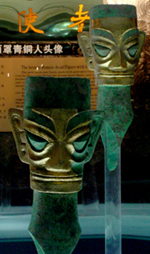 |
Zhou Dynasty (1100-221 BCE)
The Shang dynasty gave way to another kingdom called Zhou in 1100 BCE. The Zhou were once part of the Shang realm, and were located on the northwest borders near present-day Xian. Referred to as “barbarians” in early accounts, the Zhou seem to have conquered the Shang with a force of only 50,000 warriors after armies of the degenerate and oppressive Shang king joined the invading forces. Early rulers included King Wen (the “Cultivated”), who helped lay the foundation for the Zhou victory, and his son King Wu (the “Martial”), who carried it out. These two rulers embodied dual aspects of Chinese leadership incorporating both civil and martial strengths that would remain relevant for centuries.

Once Shang resistance was squelched by King Wu, a new order was put in place that evolved into a feudal system in which a central Zhou state developed relationships (by blood or marriage) with local lords all over the former Shang realm. Military prowess and accomplishment remained important attributes among the upper classes. Most people were farmers, and therefore serfs to various levels of local lords. There were also classes of craftspeople and traders.
The early period of conquest and rule, called the Western Zhou, produced another exemplary leader named the Duke of Zhou. The Duke was instrumental in forming an efficient bureaucratic state and later in the Zhou period, the sage Kongzi (Confucius) held him in high regard for his proper conduct. According to this story, the Duke of Zhou was the brother of King Wu and upon Wu’s death was made regent for his son. After years of giving good advice and guidance to the future heir to the throne, the Duke of Zhou “did the right thing” and stepped aside when the young king was ready to assume power. Although he probably could have wrested the kingship for himself, the Duke of Zhou demonstrated that proper conduct (li) and virtue (de) were more important than personal ambition.
By 771 BCE the Western Zhou had weakened due to natural disasters and ineffective leadership, finally collapsing under pressure from combined forces of western nomads and native Chinese. A popular legend tells that the last Western Zhou King would light signal fires to entertain his favorite concubine. In something like the “boy who cried ‘wolf’” story, he lit them one too many times, and the western part of the realm was overrun.


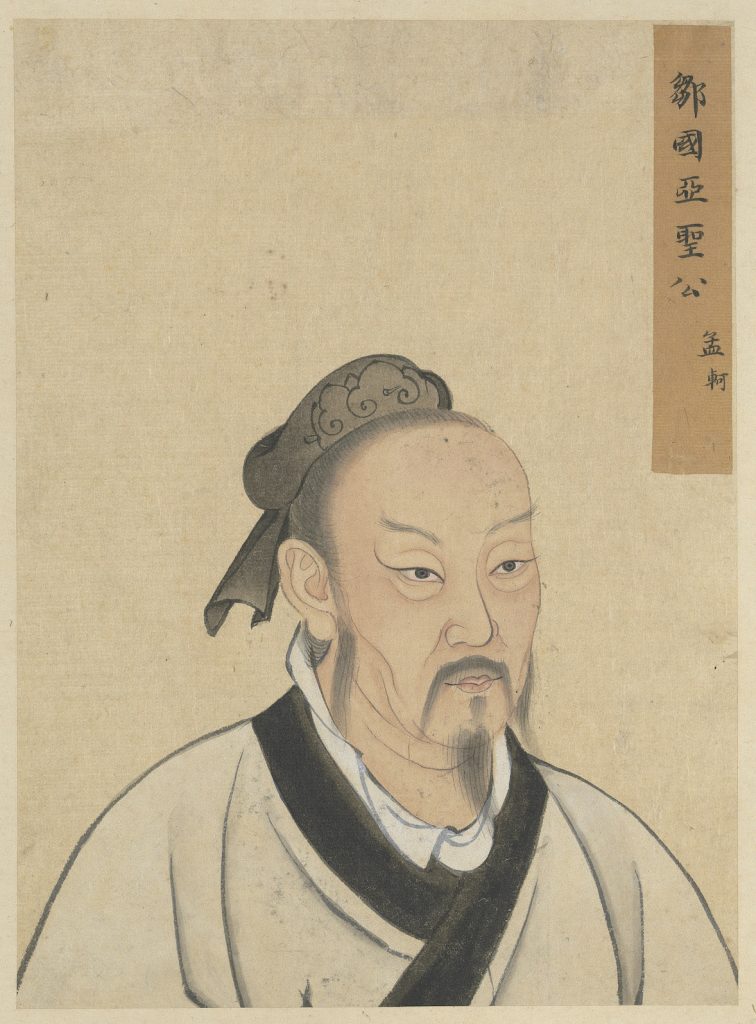
Under a new king, Zhou forces reconstituted themselves in the eastern capital called Luoyang, in present day Henan province. One era of the new Eastern Zhou dynasty was known as the “Spring and Autumn” period (770-476 BCE), famous for literature and rich philosophy, including the “Hundred Schools of Thought.” Confucianism, Daoism, Moism (Mohism), the Yinyang School, and many other philosophies flourished in this period. Classic writings and compilations like the Daoist classic, the Daodejing, the Analects of Confucius, the Book of Songs, and Sunzi’s Art of War all date to this period. This was an age of cultural and philosophical development that later ages would see as the true cradle of Chinese civilization.
An important idea in Chinese statecraft that had evolved early in the Zhou era was refined in this period. Thinkers such as Mencius (Mengzi) explained that under the so-called “Mandate of Heaven” only good rulers could receive the mandate (permission) of heaven to rule. If a ruler acted in accordance with the will of heaven, he would then remain in power and continue to serve for the benefit of the realm. If he failed in his duty, then the mandate would be withdrawn, and another ruler would come to power. Implicit in this formula was the peasant’s right to rebel if life became too intolerable. The early Zhou rulers used this theory to legitimize their usurpation of the Shang. In later ages, the theory would be invoked many times to justify dynastic and government takeovers in China. The social structure also underwent change during the Zhou. The Zhou kings were weak, and many local states evolved into nearly independent powers. Social mobility was also greater, and the influence of powerful families closely related by blood to the rulers declined. Systems of land tenure changed as well, with peasants paying taxes (rather than just labor) to their lords and the development of freer exchange of land. Metal coins became widespread in an economy that involved extensive and increasingly complex trade networks. Technological innovations saw the increased use of cast iron in place of bronze, which allowed for advances in the mass production of farm implements and of weapons—resources that would come into play in the final era of the Zhou dynasty.
 |
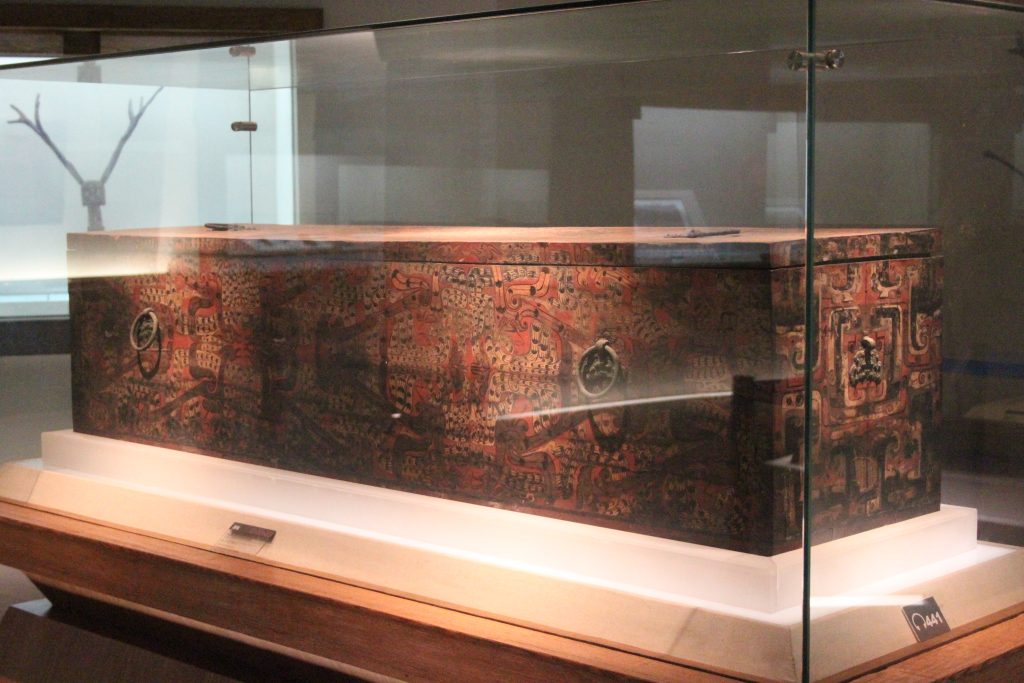 |
 |
This last era of the Zhou was known as the “Warring States” period (475-221 BCE). During this time, the individual Zhou states (which had their own armies) began full-scale struggles for power to rule and strategically ate each other up. By the end, only three states (Chu, Qi, and Qin) remained out of an original total of about seventy. The winning state was Qin. Located in the northwest, near the old Zhou homeland, the Qin had experimented with the principles of Legalism (fajia), which were promoted by the philosopher Han Feizi (d. 233 BCE). Unlike the program of Confucius, Legalism distrusted human goodness, and relied instead on bureaucratic theories of organization enforced by strict codes of rewards and punishments. With the final collapse of the Zhou feudal system, Legalist principles were implemented in the establishment of a unified empire under the leadership of China’s first emperor, Qinshi Huangdi.

Qin Dynasty (221-207 BCE)
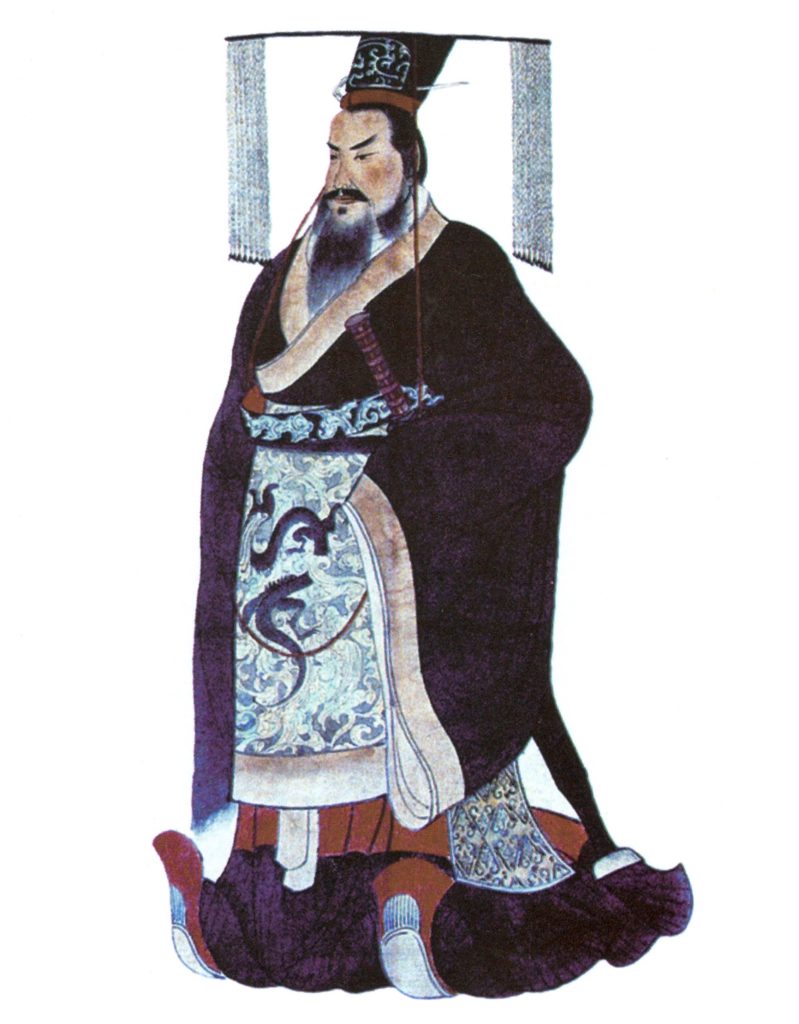
Although the Qin was the shortest of the major Chinese dynasties, it marked a transition point between the weakly-centered feudal states of the Zhou era and the emperor-centered imperial states of succeeding dynasties. Innovations in the Qin laid the foundation for government structures that lasted, with some modification, down into the early 20th century, ending with the collapse of the Qing dynasty in 1911-12, 2,000 years later.
When the forces of Qinshi Huangdi, under the guidance of the Legalist thinker Li Si, took control of the Zhou territories, methods were employed to secure control over the realm. Setting himself up as an all-powerful emperor, Qinshi Huangdi’s authority was absolute. Hereditary blood-ties were no longer a part of officialdom, and each position in the newly created state bureaucracy could be filled as if moving individual pieces on a chess board. Local officials were strategically placed in areas where they had no local allies, requiring them to look to the emperor, rather than personal or local ties, for support. Weights, measures, and written characters (which at the time had many local variants) were also standardized so that officials in all parts of the land could easily read all documents. The widths of cart axles were standardized so that any cart could run on any of the earthen roads throughout the land, thus increasing the speed and efficiency of transport and taxation. The old states were also re-divided into provinces and prefectures under the control of appointed officials, while the surviving ruling families were ordered to the capital to deprive them of power.

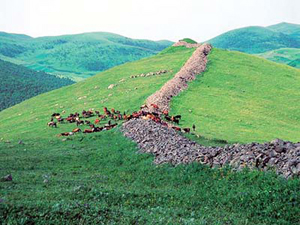
Other attempts at control included the burning of all but one copy of each of the Confucian writings (213 BCE). Though books on technical subjects were spared, more books were lost in the chaos at the end of the dynasty. Thus, much of the early learning was lost, though after the emperor’s death many books were recovered from surviving scholars who had memorized them by heart. Legend also says the emperor ordered several hundred Confucian scholars, seen as subversive to the new order, to be buried alive. Many other stories exist of the cruelty and excess of Emperor Qin.

Hundreds of thousands of farmers were conscripted to work on public works projects, the most ambitious being a series of walls across the northern frontiers. The tale of Meng Jiangnu, who searches for her husband’s bones along the Great Wall, is one of China’s most enduring folk tales. Conscripted labor also built a massive tomb for the emperor near the modern city of Xian. Five huge armies of life-size terra-cotta warriors and horses were arranged around the tomb to guard the emperor in death. The tomb itself has yet to be opened by Chinese archaeologists, who wish to perfect their techniques before attempting to excavate a structure that legend says contains a detailed model of heaven and earth, complete with jeweled skies and mercury lakes. After the discovery of the terra-cotta armies in the late 1970s, a huge museum complex has been opened to the public, where hundreds of thousands of visitors can view the excavated remains of China’s first great empire.
That empire came to an end soon after the emperor died while on a tour. Legend says that his decaying body was covered with fish on the journey home so that news of his death would not spread. Uprising and rebellion soon followed, however, and none of his weak young successors were able to hold onto power. This ultimately ushered in the rise of the great Han dynasty, China’s first long-lasting empire, based on many of the principles developed during the Qin.
Han Dynasty (206 BCE-220 CE)
The majority ethnic group in China today is called the “Han” (Hanzu, or “Han nationality” or “Han ethnic group”). The name derives from this first great empire, which lasted over four hundred years at about the same time as the Roman Empire (though the two empires knew very little about each other’s existence). The Han empire was founded in the chaos after the fall of the Qin by a rebel leader known as Liu Bang, also known by the reign name “Han Gaozu” given after his death. The early years of the Han were occupied with the consolidation of power. At the start, power was shared to some degree with local kings, but as time went on and the bureaucracy was revitalized along lines similar to the Qin, the emperor’s power grew. Legalist theory was also gradually replaced by a revitalization of Confucianism. This eventually resulted in the strengthening of the role of the emperor or “Son of Heaven” and in a more moderate state regarding what we would call “human rights” or “social justice.” Social classes included the ruling imperial family, civil bureaucrats, landed gentry (who acted as small-scale local leaders), farmers, artisans and craftspeople, and merchants.
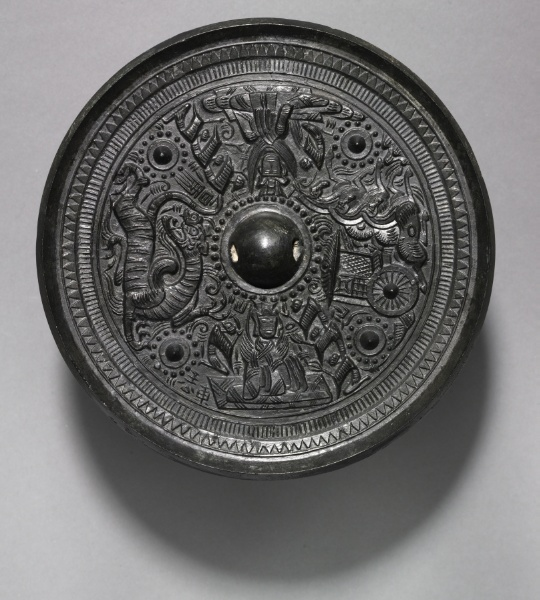
Cast bronze mirror from Eastern Han dynasty, 100-200 CE. According to the description of this museum exhibit, “Depicted on the mirror back are two Daoist deities: the King Father of the East (Dongwanggong) and the Queen Mother of the West (Xiwangmu). Completing the design are the White Tiger of the west (one the Four Spirits representing the four cardinal directions, including the Green Dragon of the east, the Red Bird of the south, and the Dark Warrior of the north) and a chariot drawn by three horses. The reason for the redundancy of two symbolic images relating to the west is not known.” Such mirrors were common in ancient China. The opposite side is smoothly polished. They could have daily life or ceremonial usages. (Photo courtesy of the Cleveland Museum of Art, gift of Drs. Thomas and Martha Carter, licensed under CC0)
Great advances were made in intensive agriculture, including crop rotation, fertilizers, and new techniques in the use of draft animals. Town and country were linked in a more advanced agrarian economy, and many farmers pursued sideline activities such as textile production. There were also attempts (not always successful) to keep tax burdens on peasants low. This was done in part by creating state monopolies on high consumption essentials such as salt, iron, and alcohol in order to temper the growing economic wealth of the merchant-class. Graves of the Han dynasty gentry class offer a wealth of insights into everyday life, for interred with the dead were clay models of everything from houses of the prosperous and ample kitchens, to well-stocked courtyards and nursing farm animals, all made to scale.
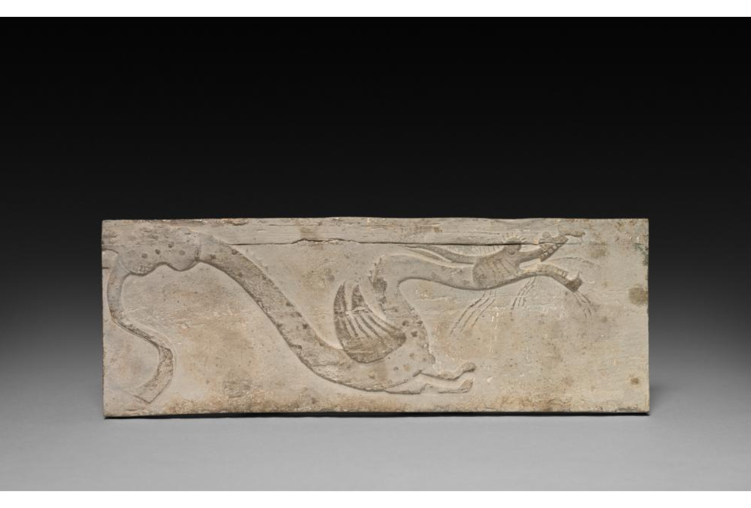
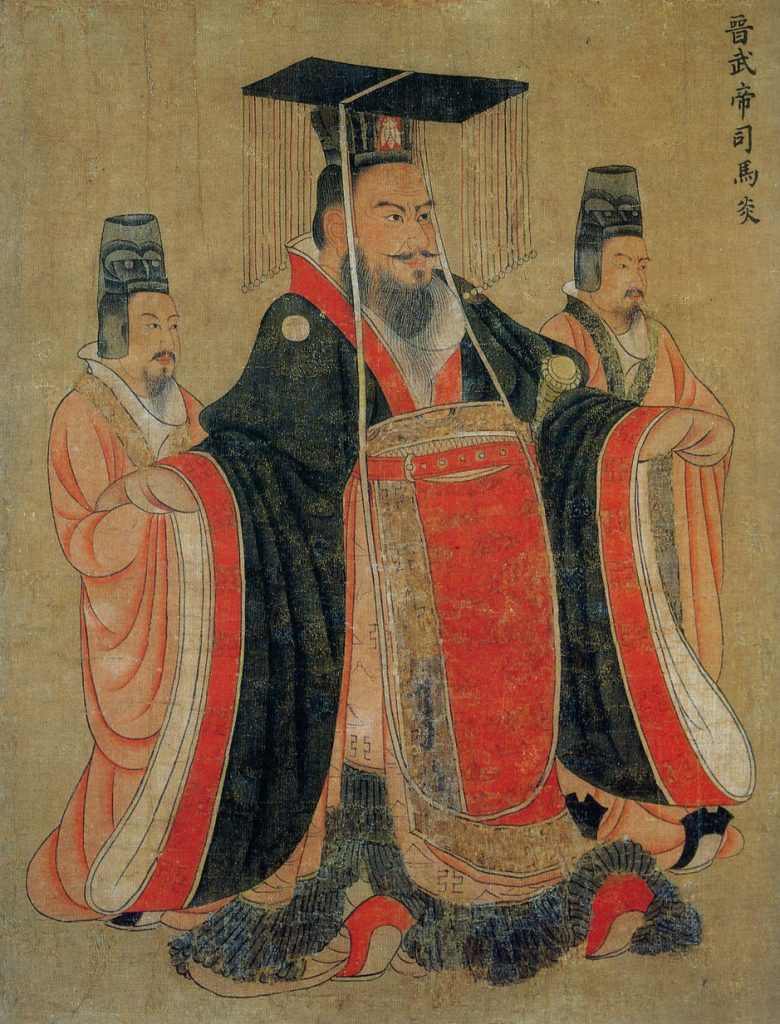
The borders of the Han grew, with advances along the Silk Road towards Central Asia, and large-scale migrations into southern China.After the founders, the greatest Han emperor was Wudi, who reigned from 141-87 BCE. The role of the emperor as a model of virtue who worked for the good of the people was expanded under his reign. Confucian philosophy also advanced, including the idea offered by the Han philosopher, official and writer Dong Zhongshu that nature would send signs such as earthquakes or floods if a ruler was losing the “Mandate of Heaven,” and speculated on the inter-relations between the heavens, earth, and mankind. In 124 BCE, an examination system was set up that offered an opportunity to males of any respectable background to elevate their (and their families’) positions in life. The exam system also served as a way to recruit true talent into the system. Much of what we know about early Chinese history comes from the writings of the historian Sima Qian (died c. 85 BCE), who was so dedicated to researching and editing the surviving writings of the past that he accepted castration for displeasing the emperor, electing to remain alive to finish his history rather than to commit suicide, which was seen as the more honorable path. Buddhism arrived from India by the first century BCE and gradually grew in popularity.
Throughout the Han era the Xiongnu on the northern borders were a threat dealt with first by warfare and then by a policy of diplomacy and appeasement that included Chinese brides. Under Wudi, the borders were expanded in a series of wars against the Xiongnu and command posts were established on the Korean peninsula in 108 BCE.
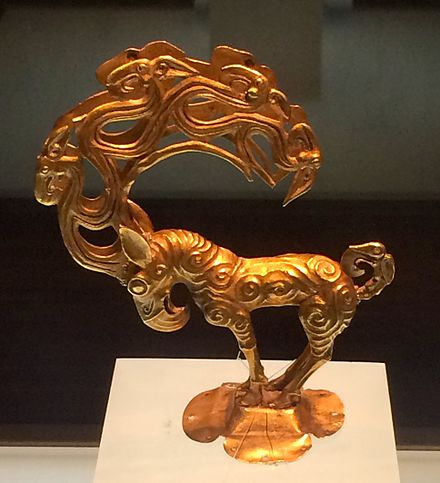
As time went on, however, the wars with the Xiongnu and other border peoples grew costly, lifestyles at the court grew lavish, and the tax burdens on the populace increased. After Wudi’s death attempts were made to rectify the situation, but eventually a usurper named Wang Mang came to power. He was the nephew of Empress Wang—one of a number of women who held powerful, but temporary positions during the Han.
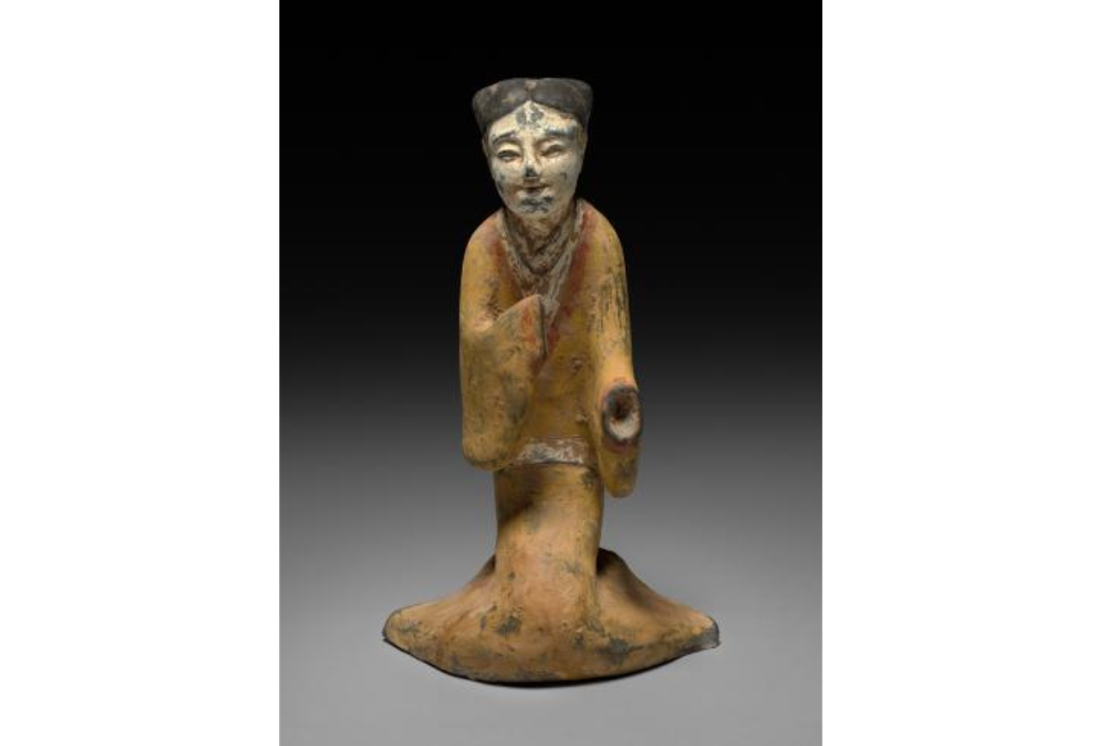
Once Wang Mang took over the throne, he attempted to institute social reforms by taking from the rich and giving to the poor. His reforms included the re-division of landholdings, freeing of slaves, providing social welfare and revolving credit programs for farmers and the poor, taxes on the use of firewood and natural resources, and reinstitution of government monopolies on certain goods. In practice, most of the reforms were not effectively instituted, or had the effect of adding even greater economic pressures on the populace. He also launched costly, disastrous campaigns against the Xiongnu.
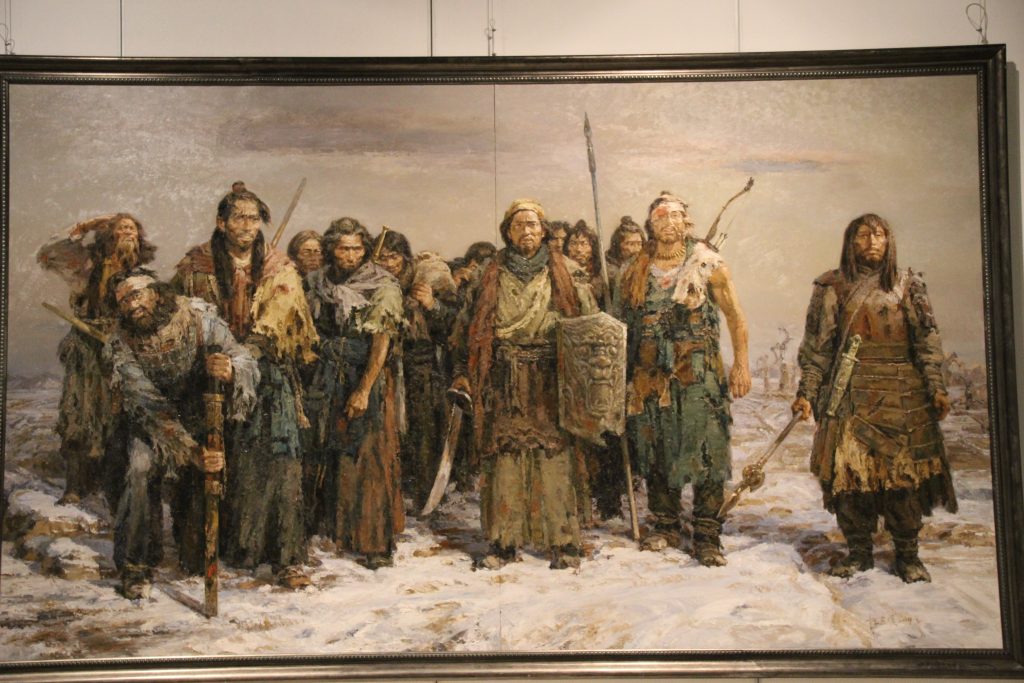
Eventually both the upper-class gentry and the greater population vehemently opposed the attempted reforms. As the young government became increasingly destabilized (possibly due in part to a traumatic shift in the course of the Yellow River in northern China), popular revolts led by a group called the Red Eyebrows brought the death of Wang Mang and an end to his experimental rule. The historian Wolfram Eberhard notes that Wang was decapitated while reading ancient scriptures in his chambers, and his skull was preserved for two hundred years.
After Wang’s death, the Han dynasty was revived by surviving members of the Han imperial line and returned to its former glory, though the capital in Chang’an (modern Xian) was moved eastwards to Luoyang. By about 189 CE, however, the realm was again on the road to crisis and collapse. Wars with border peoples like the Xiongnu and Xianbei, internal problems with powerful military cliques, weakening leadership at the imperial court, and more popular revolts—this time by groups such as the Yellow Turbans—fatally weakened the dynasty. It collapsed in 220 CE ushering in a period of disunity in China that lasted for about three hundred years. As Professor J.A.G. Roberts has observed, Rome fell at nearly the same time—and for similar reasons (especially pressure from nomadic peoples)—though Europe, unlike China, was never reunited in the same way again.
Period of Disunion and Alien Empires (220-581 CE)

With the fall of the great Han dynasty, the Middle Kingdom ceased to exist. For the next three and a half centuries numerous small kingdoms rose and fell on the lands that were once all ruled by the Han. First among these were three kingdoms, two southern ones called Shu Han (in present-day Sichuan) and Wu (in the Yangzi River basin), and a northern one called Wei. Battles and intrigues between the rulers of these states constitute the plot of China’s greatest historical romance, The Romance of the Three Kingdoms (Sanguo yanyi). The northern Wei state had a population of about 29 million, making it by far the largest of the three. Among its population were 19 groups of Xiongnu who had been allowed to settle in China near the end of the Han. There was relatively little encroachment on the northern frontier at first, since alliances among the nomadic tribes themselves had recently fallen apart and were yet to be reunited under a charismatic leader. During this period the Wei actually forged an alliance with the early Yamato state in Japan to attack hostile nomad groups on the Korean peninsula.
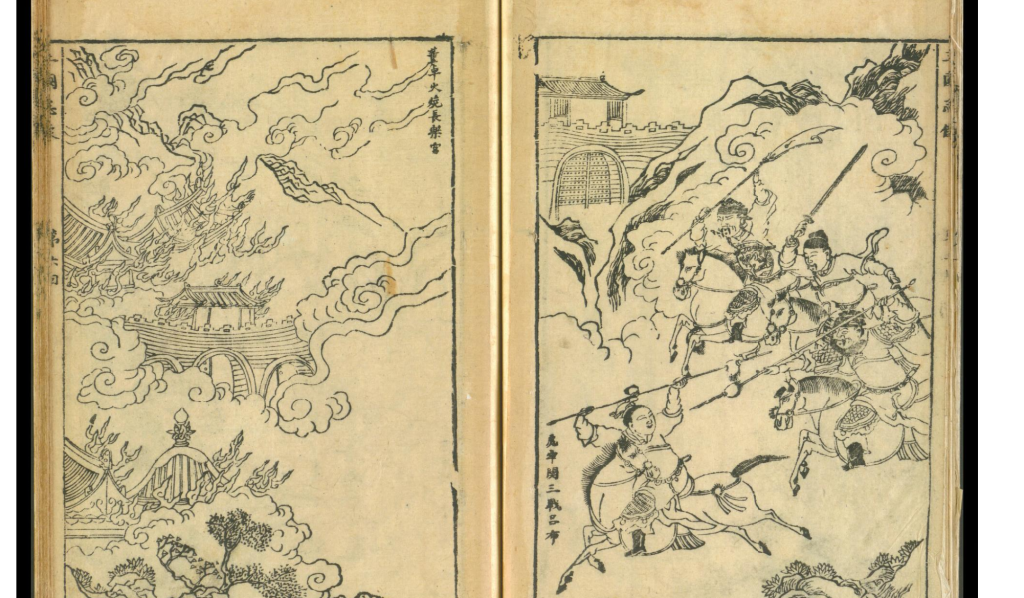
As time went on, these kingdoms collapsed, and large numbers of demobilized Chinese soldiers began farming and practicing various trades on the northern borders. In turn, nomads of Turkish, Xiongnu, Xianbei, Tibetan and other ethnic backgrounds allied and took control of adjacent areas. Cultures interacted over time, and a series of small states rose and fell. Some attempted to follow Chinese models of rule, many others gave their loyalties to charismatic rulers (a nomad attitude) whose kingdoms fell apart at their deaths.
During the 4th century a Tibetan leader created a large domain in western China. This was followed later in that century by a large state that ruled northern China and contiguous areas into the mid-6th century. The state was a multi-ethnic federation populated by the Toba people, whose leaders had adopted many aspects of Chinese tradition.
In the south there were fewer kingdoms, although cultural mixing between ethnic Chinese and southern indigenous peoples also took place. Northern immigrants were forced to adopt diets less rich in meat and higher in soybeans, fruits, and leafy vegetables as well as to adopt southern techniques of wet rice farming instead of the dry-land wheat production typically practiced in the north. In some instances, even the southern regions were subject to raids from the northern nomads.
Written records of the period of disunion are mostly from Chinese language source and were often composed by intellectuals in the service of “barbarian” overlords. The most important intellectual and spiritual trend of the long era was that of Buddhism and monks continued to enter the Chinese regions on both northern and southern trade routes.
PART 5: THE GREAT DYNASTIES
Sui Dynasty (580-618 CE)
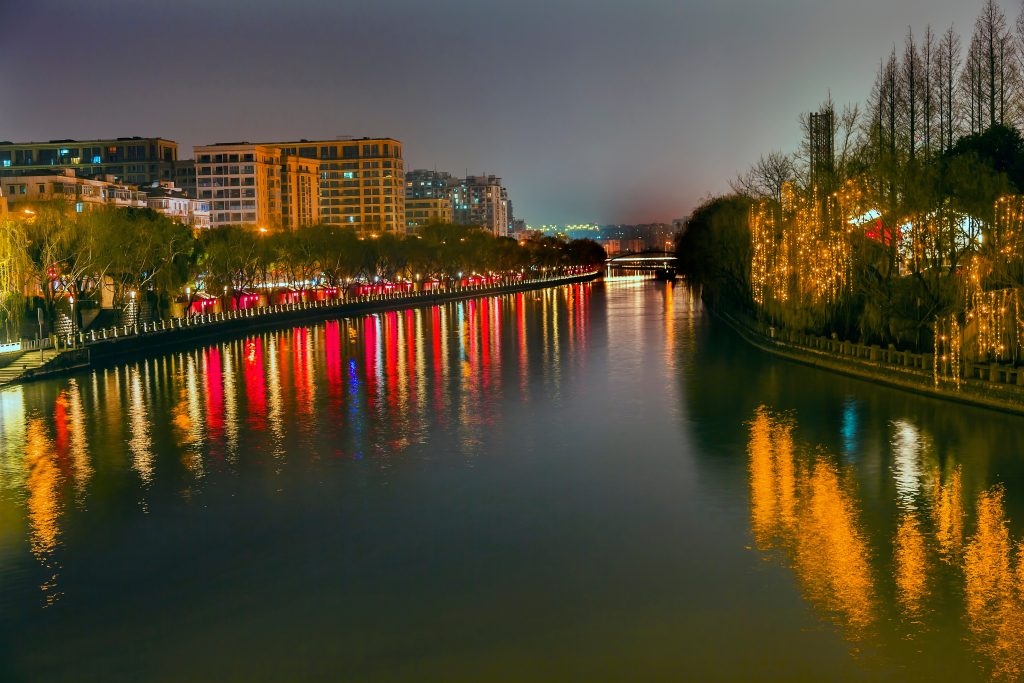
China was finally reunited under the efforts of a capable and thrifty military leader from the northwest named Yang Jian, also known by the reign title Wendi. His dynasty would be known as Sui. Like the earlier Qin dynasty, the Sui was a short and severe dynasty that nonetheless garnered many accomplishments.
The Sui revitalized old connections throughout the empire and revived institutions of control that would be further embellished by the great and long-lived Tang dynasty that followed. Among the accomplishments of the Sui was the building of the Grand Canal that linked the thriving cultures of southern China with those of the north, near the new Sui capital at Luoyang. The canal acted as an inland watery highway, especially useful for the transport of grain.
Strains were placed upon the Sui treasury by wars with foreign peoples on the northeast border, including attempts to defuse an alliance between the Korean state of Goguryeo and their nomadic Turkic allies. Leadership also became a problem after Yang Jian’s son, Yang Guang, or known by his reign title, Yangdi, took the throne. Although he is responsible for the success of the Grand Canal, historians and popular literature have not been kind to Yangdi’s memory. A case study in imperial decadence, Yangdi was known for high living and lavish expenditures on parties, palaces, and lengthy trips through the exotic southern reaches of his realm.
Stories of Yangdi’s well-known “pleasure tour” through the lower Yangzi delta are still told by Chinese storytellers in China today and had become the subject of racy vernacular romances by the 17th century. Legend suggests that Yangdi even had the custom of being drawn through the streets in a carriage pulled by unclad young men and women who would unceremoniously topple upon each other when the ruler pulled back on the reins.
Losing the support of the gentry landholders, the Sui economy eventually foundered, and uprisings began. Retreating to the south, Yangdi was eventually assassinated in 618 CE at the hands of his most trusted general’s son and the empire was dissolved. In the meantime, however, a capable general named Li Yuan and his brilliant, but ruthless son, Li Shimin had managed to position themselves for conquest and the rule of their own dynasty—the Tang.
Tang Dynasty (618-906 CE)
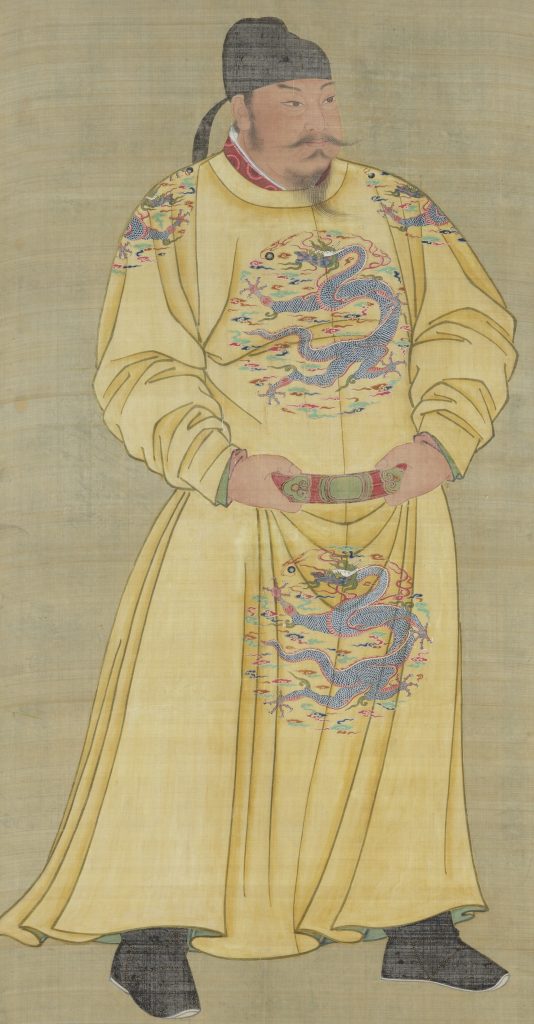
Chinese historians regard the Tang dynasty as both a revival of the best of the Han dynasty and as the high point of power and culture in Chinese history. An open, cosmopolitan era, the Tang was a time when cultural influences and ideas streamed into China along the Silk Road, and China became a model for emerging kingdoms in Korea and Japan. Its capital, Chang’an at times had a million inhabitants and drew peoples of many faiths and ethnicities from all over Asia and perhaps beyond. Art and literature also famously flourished in the Tang period, which is seen as the peak moment of Chinese lyric poetry.
Li Yuan, the founder of the dynasty, was a military leader of possible Toba background. Allied for a period with threatening Turkish nomads, he and his son Li Shimin toppled the weak Sui government and ruthlessly took control. In the process, Li Shimin killed his elder brothers (who were conspiring against him), as well as many other rivals. Once assuming control, Li Shimin, also known as Taizong, went on to become one of the most effective emperors in Chinese history, leading a strong, stable, and influential state.
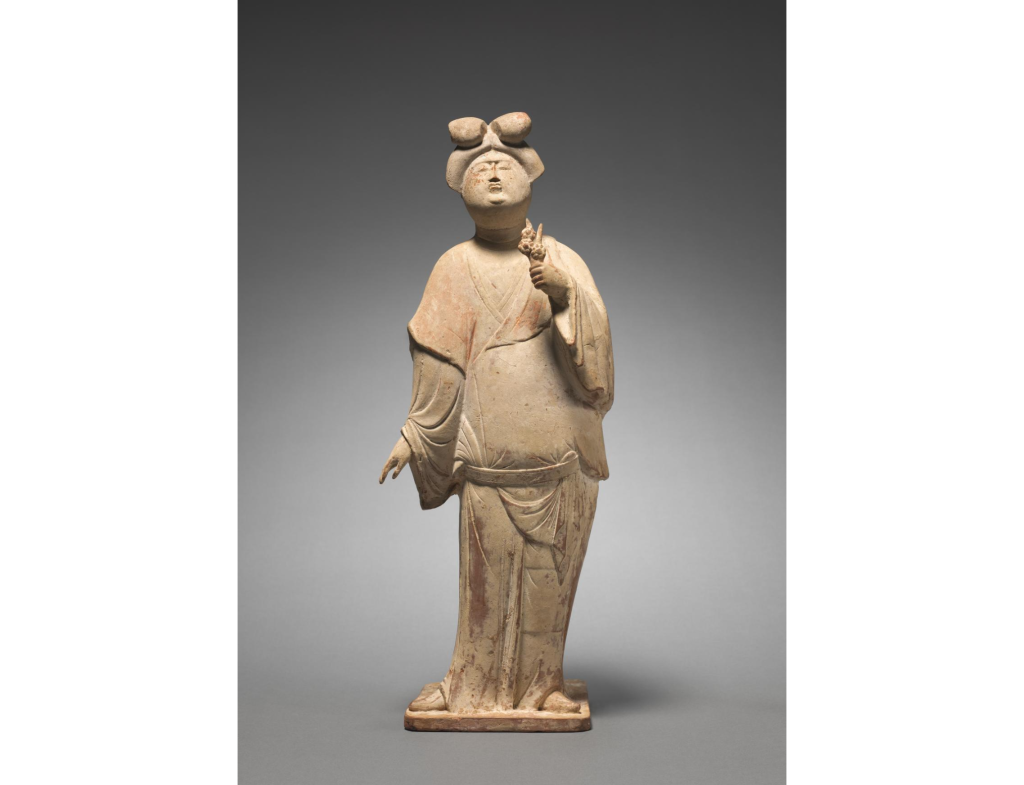 |
 |
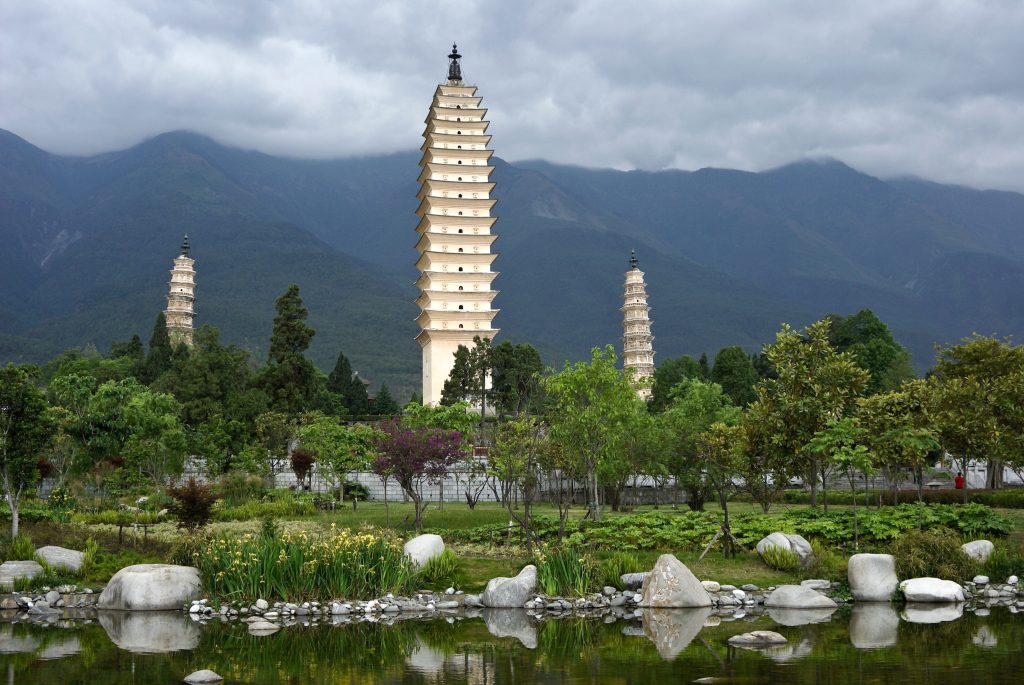
The civil and military bureaucracies were revived and expanded under the Tang. Below the emperor were civil officials and military leaders, largely drawn from the powerful gentry, families with large hereditary land holdings. Middle-level positions were filled by men from provincial gentry families and those who did well in the civil service examinations that were reinstituted in the Tang. The greater populace was comprised of farmers, artisans, craftspeople, and traders. Large armies were deployed on the northern borders and local armies and militias were filled with peasant farmers.
Military campaigns were carried out against Turks in the northwest and eventually against Korean states in the east, with the Tang forming a special relationship with the kingdom of Silla. Chinese influence on Japan (in the Nara and Heian periods) was also great at this time. On other fronts, in the 7th century the Tibetan state became very powerful to the west, and, in what is now southwest China and parts of Southeast Asia, a large kingdom called Nanzhao arose.
Land was an issue from the very beginning in the Tang. Among the first acts of the new rulers were attempts at land reform. In an attempt to weaken the holdings of powerful gentry landholders, land was re-divided, giving farmers equal shares of land—a system that had been tried in earlier times, including Wang Mang’s experiments in the Han and also for a while in the Toba kingdom. This “equal field” system offered both advantages (land to till) and disadvantages (taxes and corvée labor) to the peasants. Over time, many moved to the less restricted south, eroding the tax base. Another old system called baojia (collective households) was also tried. In this system, the farm folk were divided into five-family groups who were responsible for collectively submitting their taxes and annual labor quotas for state projects. Even this proved ineffective, and the attempts at land reform gradually diminished as the gentry regained power over more and more land.
Several colorful rulers and other palace figures populate Tang history. Among these is Empress Wu Zetian, arguably the most powerful woman in Chinese history. She came to the imperial court as a concubine of Li Shimin, but later had a relationship with his son, Emperor Gaozong. She eventually became his empress after forcing him to divorce his wife and succeeded in placing her son on the throne. She later deposed him and placed herself in power as emperor of her own Zhou Dynasty, which lasted from 690-701 CE. According to Wolfram Eberhard, this was in part possible because women in the Tang had more freedom of movement than in earlier and in later times due to lingering attitudes from the nomad kingdoms in the period of disunity. Once in control, Wu Zetian, in an attempt to consolidate her power, moved the capital east to Luoyang and away from the powerful gentry families of Chang’an. She instituted reforms in the examination system and government that made it more difficult to succeed solely on family connections and women were allowed to take civil service examinations to become officers in the court. She also promoted the interests of her allies, the Buddhists. Many monasteries became very rich during her reign. Huge temples and a massive iron pagoda were built with government support. Wu Zetian was a good administrator and the country was strong under her rule, though under constant threat from the Turks. Nevertheless, historians have been unkind to Empress Wu, traditionally describing her as evil and debauched. In recent years, her accomplishments have begun to be better appreciated.
 |
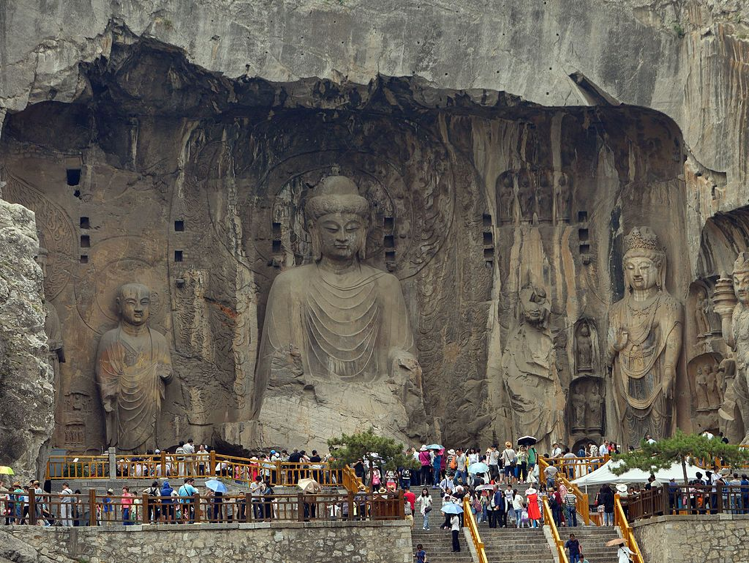 |
Empress Wu was eventually forced from power and the Tang was restored. Soon after, Emperor Xuanzong came to power. He was a capable ruler who fortified China’s northern borders by the establishment of nine military command zones staffed by his appointees. He also made reforms to government administration and finances and attempted to deal with problems of grain transport and taxation of the peasants. In his later years, however, he became infatuated with a young concubine, Yang Guifei. Their love affair is one of the most popular tragic love stories in China. During this period, one of the border commanders, a man of mixed nomad stock named An Lushan ingratiated himself with Yang Guifei. He later fomented a rebellion that ended in 763 and marks the beginning of the decline of Tang power. Although the Tang was still in many ways a well-run state after the An Lushan rebellion, a crisis in leadership ensued. The borders also weakened, as did the imperial treasury, and rebellions ensued. Eventually smaller military states began to appear in northern China. Eventually Tang fell apart, ending a great period of openness, creativity, and power.
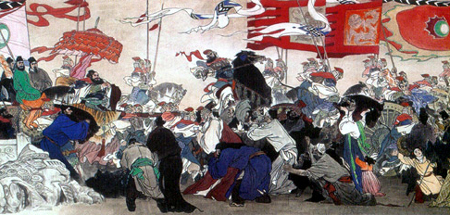 |
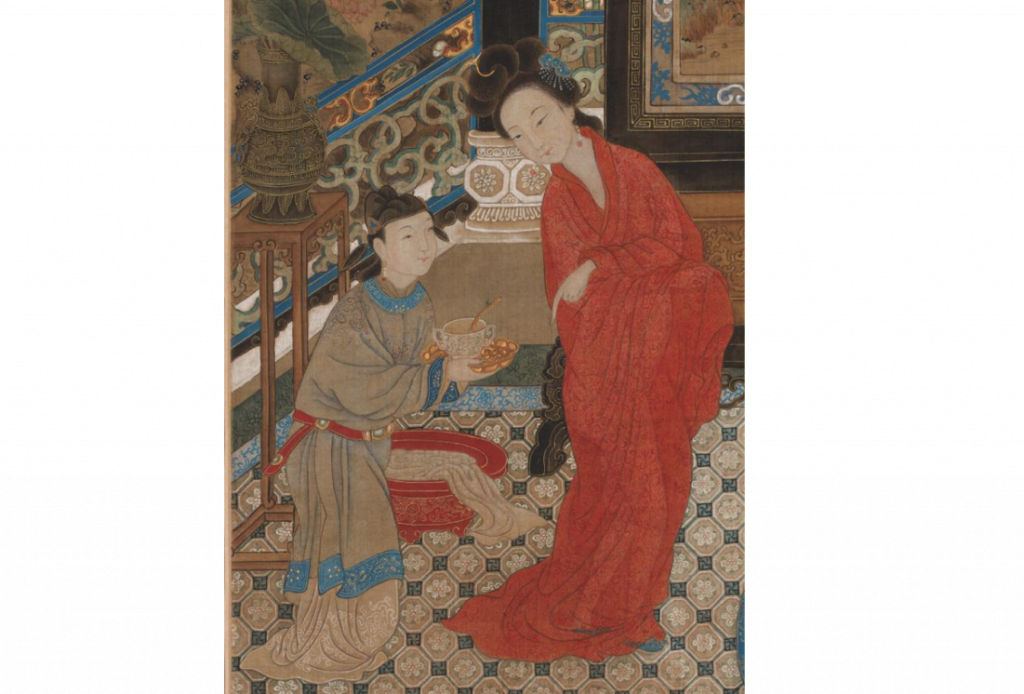 |
Second Period of Disunion (906-960 CE)
The decades after the fall of the Tang dynasty are known as the Five Dynasties and Ten Kingdoms, referring to a succession of small states that came and went during this short period of time. It was a time of division between north and south and of rapidly changing administrations. By 960 CE, China was again reunited in the Song dynasty.
PART 6: SHIFT TOWARDS “MODERN TIMES”
Song Dynasty (960- 1279 CE)
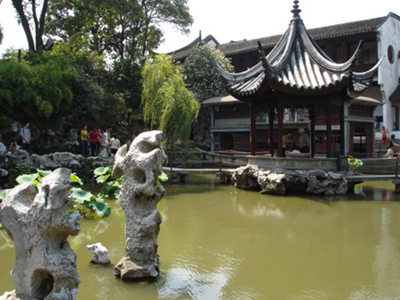
The Song marked a period of transition toward early modern forms of society as many of the powerful gentry families of the Tang period crumbled and a new era of social mobility for males of all classes commenced. The new leaders brought the military under control and strengthened the civil side of the government with modifications in the civil service examinations. As J.A.G. Roberts has noted, the society was becoming more meritocratic, with less emphasis on family background.
As described in Chapter 2, the development of new styles of urban life was associated with a growing middle class. This growth was due in large part to an increasingly sophisticated economic system that allowed for the expansion of merchant guilds and revived the use of money (which had declined in the previous eras). In part, this development was due to a shift in geographical focus southwards to the Yangzi delta, an area that had been growing in population for centuries and had been made more accessible due to the canal links to the north. The delta cities of Hangzhou, Suzhou, and Yangzhou all became important economic and cultural centers, and today offer some of the finest examples of Chinese garden architecture in existence. Scholars in these cities advanced the arts of landscape painting and poetry during this period. Many technological advances also occurred during the Song, including the widespread introduction of printing, development of advanced military devices employing gunpowder, improved irrigation techniques, watermills, large mechanical clock towers, and so forth.
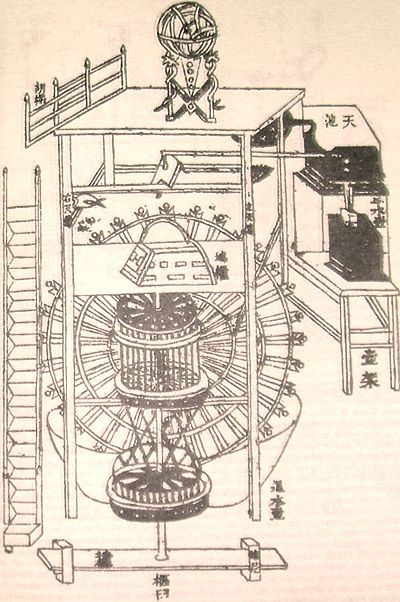
One less “modern” change was an increased restriction of the lives and activities of women both within and without the home. During this period, for instance, discourse that discouraged widows from remarrying was elaborated and grew more popular. Although many women in this period were engaged in household textile production, they were seldom allowed to leave the home except for occasional visits to temples or to attend certain festivals. The relative freedoms of the Period of Disunion and the Tang were replaced by a stricter system of clan and household management that gave more power to males, especially male heads of households. Neo-Confucianism, which saw further developments in the Song, played a part in defining this increasingly constricting vision of women’s roles in society.
Although in many ways developments in the Song set new directions for the development of urban, mercantile lifestyles that continued in some cases into the early 20th century, the era on the whole was militarily weak and the dynasty was subject to invasion. Indeed, the Song is divided into two parts—the Northern Song (960-1127 CE) and Southern Song (1127-1279 CE)—due to foreign invasion. By 1115 CE the Jurched, a people from the northeast, had conquered the lands north of the Yangzi River, setting up a large state called Jin. A Tibetan-related group known as the Tanguts established another state, called Xixia in the northwest in present-day Ningxia. In the southwest, a successor to the Nanzhao kingdom still held sway. As a result of the Jin invasion, the Northern Song capital, located in the city of Kaifeng, moved to the southern city of Hangzhou. For a time, the population of Hangzhou numbered over one million inhabitants. Although the Song continued in the south for over a hundred years, it too eventually fell in 1271, this time to the Mongols, who, under the leadership of Genghis Khan, had ravaged the kingdoms to the north, including the Jin.
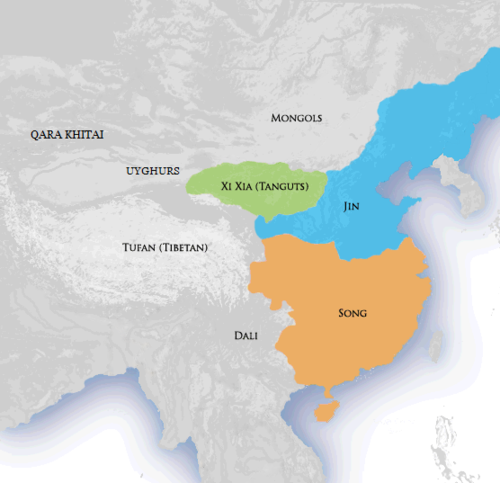
Mongol Interlude (1271-1368 CE)
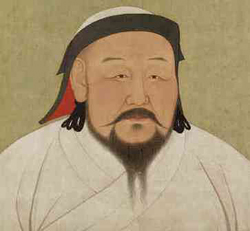
An overview of the Mongol era in East Asia is included in the Timeline. After the Mongol destruction of the Jin and Xixia states—which included the slaughter of an estimated 90 percent of those populations—the Southern Song fell to the Mongols in 1271 CE (although the conquest was not actually completed until 1279). The Mongols had superior military organization and a better grasp of the advances in military technology such as siege engines, primitive rockets, and simple cannons than had previous northern invaders, and for the first time China fell completely under foreign rule. As Wolfram Eberhard has noted, for the next 631 years, China would be under the control of foreign invaders for 355 years and under Chinese rule for only 276.
Khublai Khan, a grandson of Genghis Khan, had spear-headed the defeat of the Southern Song and founded a dynasty in China known as Yuan, declaring himself emperor. In order to keep the realm under control, he instituted a system of ethnic stratification that put Mongols of various origins at the top of the hierarchy, other northern peoples such as the Uygurs and the surviving Tangut were in second place, while northern Chinese (who had a long history of interaction with the steppe people) were in the third position of trust. The southern Chinese were at the bottom. Many government and clerical positions were staffed with people from the northwest and Central Asia—especially Uygurs from the now Islamic areas of Xinjiang— who learned both Chinese and Mongolian. Most Chinese, especially in the rich Yangzi river valley were shut out of governmental appointments. Some scholars, like Guan Hanqing, released their creative energies by writing dramas, an art form that appealed to both the Chinese and their Mongol overlords.

As the Yuan dynasty progressed, the economy weakened as large amounts of wealth left China in the hands of foreign merchants who were allowed many advantages over their Chinese counterparts. Pressure was also put on peasants by Chinese gentry who had been allowed to keep their lands and by Mongols who were given tracts of land as part of the spoils of war. The government also required tax revenues and corvee labor for massive public works projects, such as the overhaul of the old canal system, which was now needed to transport rice from the fertile south to the more barren north. A huge new capital, known today as Beijing, was built in the north. However, even Beijing was too hot for the Mongol rulers, and a special summer palace (in Tibetan style) was built still farther north in Chengde, near the old Mongol homelands. As the economic system weakened and some Mongols became disenchanted with a sedentary lifestyle, popular discontent grew. After about eighty years, ruling China became increasingly difficult. The Mongols were finally driven out by a peasant rebel named Zhu Yuanzhang, who had found common cause with the patriotic Chinese gentry. Zhu would become emperor of the Ming dynasty—the last Han Chinese dynasty in imperial history.
Ming Dynasty (1368-1644 CE)
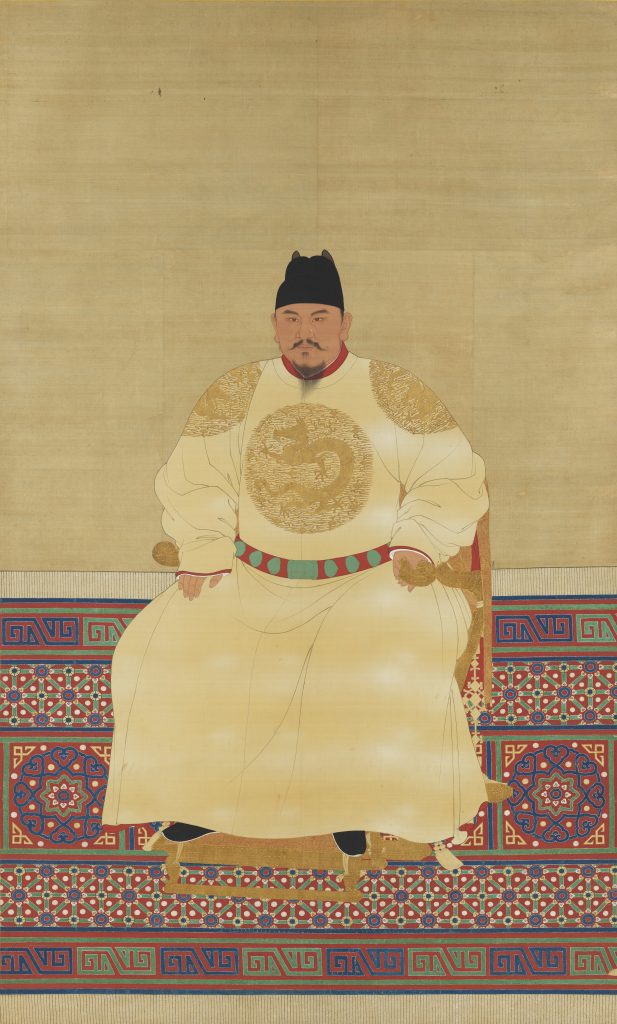
As noted, the Ming (“bright”) dynasty was the last imperial dynasty ruled by Han Chinese. Once Zhu Yuanzhang (also known by the reign name Hongwu) ousted the main Mongol forces, he declared himself emperor. He moved quickly to gain military control of the whole country, in many ways following Yuan styles of military and government organization. It was not until 1390, however, that the final Mongol holdouts were driven from southwest China. Occasional Mongol raids still perplexed the Ming even in the 16th century.
In order to restaff and reinvigorate the government bureaucracy, Zhu revived the civil service examinations and set up government-sponsored schools throughout the land that helped examinees ground themselves in the Confucian Classics. He also experimented with new tax policies by introducing a system in which local gentry were responsible for tax-collection in their areas; and organized farm households into groups of ten, who then shared mutual responsibility for taxes and labor for public works projects.
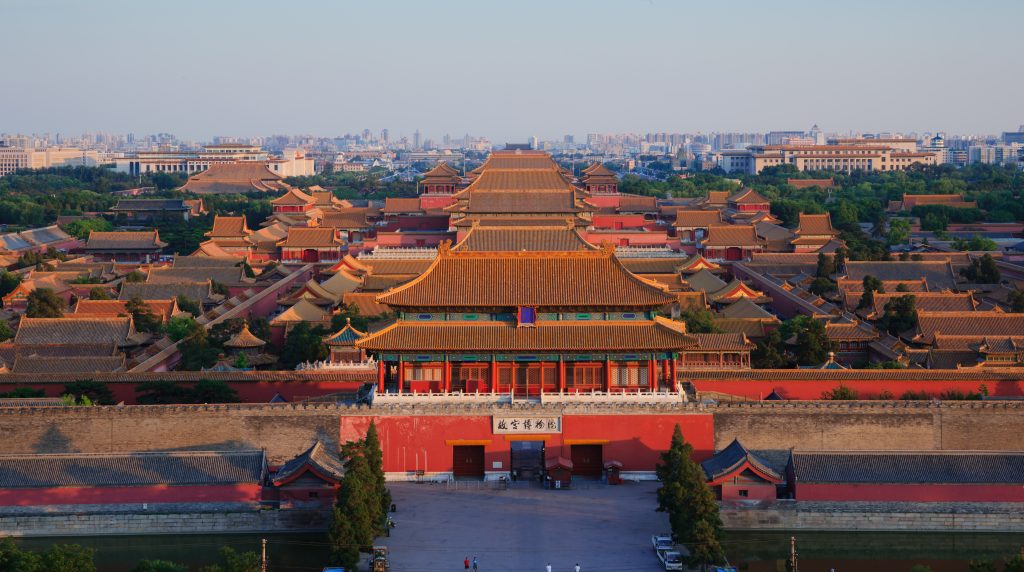
Zhu Yuanzhong’s grandson, the Yongle Emperor, moved the capital from Nanjing, in the south, to the site of the former Mongol capital, Beijing. Here, between 1402 and 1421, he built the massive Forbidden City, which still stands today beside Tiananmen Square. Yongle also led several military expeditions into the remaining Mongol realms as a deterrent show of force. Besides refurbishing the Grand Canal system to improve grain transport he commissioned the Moslem eunuch Zheng He on seven voyages across the Indian Ocean to the east coast of Africa and ports in the Arabian Sea. One detachment of his men made a pilgrimage to Mecca and recent genetic research has confirmed legends which say that some of his sailors remained behind and lived in communities in Eastern Africa. The massive fleets of over 300 ships, including several huge treasure boats ten times the size of the Santa Maria (a ship in which Christopher Columbus “discovered” the “New World” in 1492), must have inspired awe and respect in all who encountered them. Yet, for some reason Yongle lost trust in the enterprise (and in Zheng He). He ordered the fleets burned and China lost its initiative as a commercial, sea-faring power. Years later in the dynasty, Japanese pirates would constantly raid the Chinese coast.
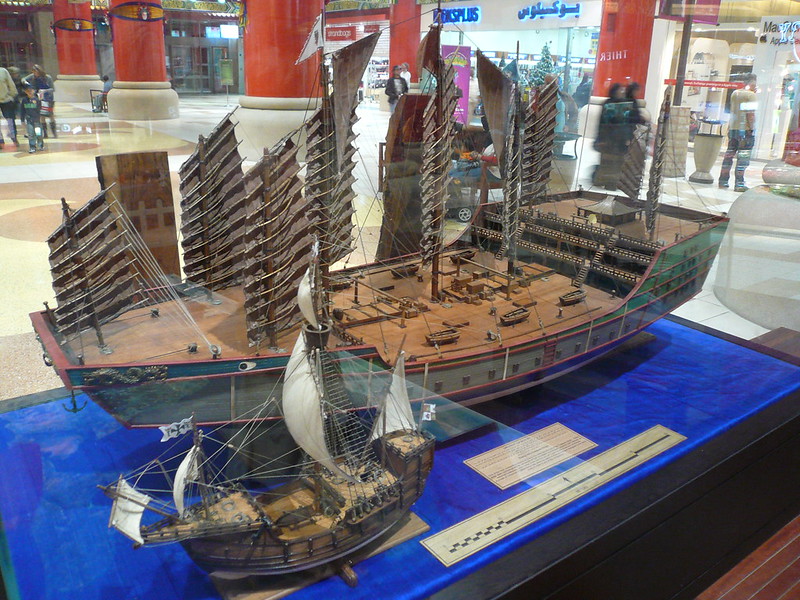 |
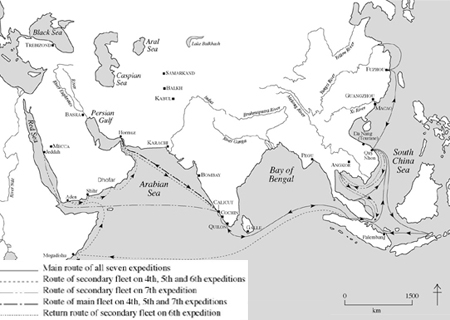 |
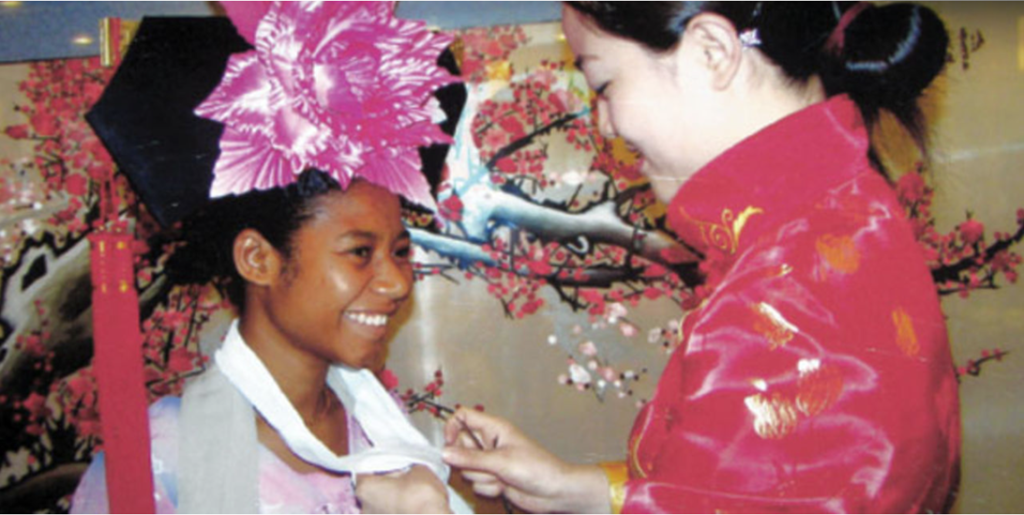 |
Zheng He’s voyages and their legacy: (Left) A comparison of the size of Zheng He’s ship to that of ship of Christopher Columbus. (Center) A Map of Zheng He’s seven voyages. (Right) Dr. Mwamaka Sharifu of Lamu Island, Kenya, who may be a descendant of Zheng He’s crew. In 2005 she received a full scholarship from Nanjing University to study traditional Chinese medicine (TCM) and recently graduated, taking all her coursework in Chinese. |
||
Other events also marked a shift inward. The Mongols again proved a threat, actually capturing the reigning Ming emperor around 1448. The eventual result was a revamping of the Great Wall, which was initially formed from several existing walls and rebuilt and fortified along the borders of the northern steppe. Due to relatively stable times and advances in agricultural techniques, the Chinese population reached 150 million by 1600. New strains of hardier and faster-growing rice were developed and new crops such as the white potato, sweet potato, maize, peanuts, hot peppers, and tobacco were arriving from the New World via the Portuguese, Spanish, Dutch and other Europeans who were now taking control of the world’s sea routes.

Portuguese Jesuit priests, representatives of a highly learned sect of the Catholic Church, were the first sea-faring Europeans to arrive in China during the Ming, making contact in 1514. By 1582, the famous Jesuit Matteo Ricci, like Marco Polo in the Yuan dynasty, had learned Chinese and even wore Chinese clothing. Chinese intellectuals shared their knowledge of astronomy and their inventions with the Jesuits, who in turn introduced aspects of European mathematics and science of the day. During the Ming, printing became even more widespread than in the past and a wide variety of books, including vernacular short stories and romances, found ready markets in urban areas.
Eventually the combination of a decline of leadership that was coupled with corrupt eunuchs at the imperial court, destabilization of the economy due to an influx of foreign silver, population growth, abusive tax policies, and popular rebellion weakened the Ming. Among the rebels fighting to overthrow the Ming was one Li Zicheng, who in 1644 managed to capture the father of a Chinese commander named Wu Sangui. Instead of submitting to Li Zicheng, Wu allied himself with Dorgon, a leader of the Manchus. The Manchus were descendants of the old Jurched peoples who lived in the rich forests of Manchuria (what is now northeast China and part of North Korea). For several generations, under able leaders like Nurhaci (1559-1626), the Manchus had been scheming to invade China. After Wu Sangui aided the Manchu forces in breaching the Great Wall they entered and soon took command of all China.
PART 7: FROM 1644 CE – PRESENT
In 1644 CE the Manchus established the Qing dynasty. It lasted over two hundred and fifty years, far longer than the Mongol occupation. The Manchu empire extended China’s borders to their greatest extent in history, bringing allies such as Tibet and the northwest regions of Xinjiang under direct Chinese rule. Incredibly strong in its earlier years, the dynasty declined by the early 19th century due to a combination of rapidly rising population, incompetent rulers, inner revolts, and outside forces that arrived by sea, rather than by the traditional land routes. In 1911-12 the dynasty collapsed, replaced by China’s first attempt at setting up a Western-inspired republican government.
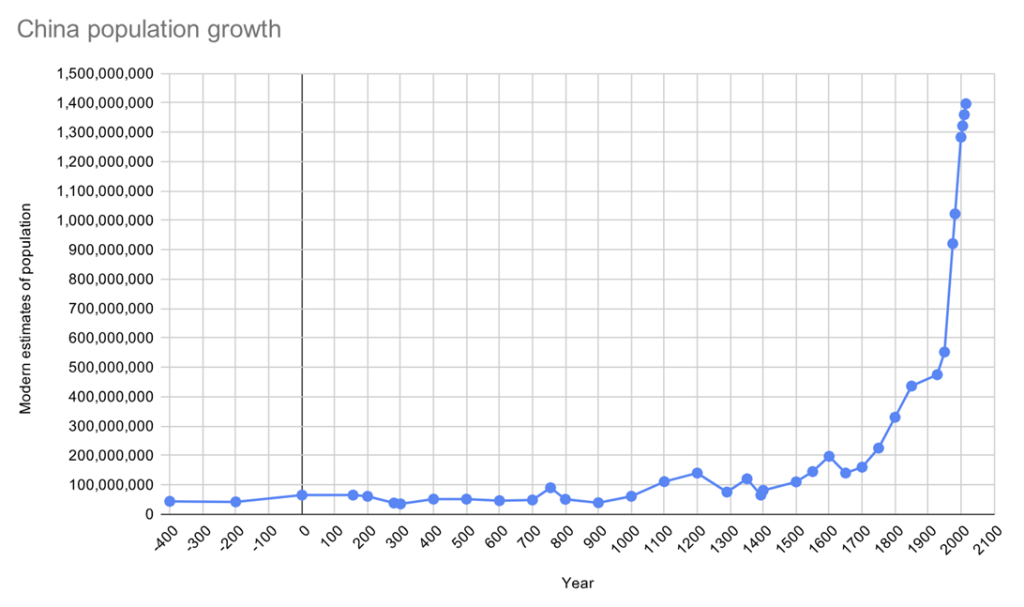
For generations before the takeover, Manchu leaders such as Nurhaci and Abadi studied Chinese culture and history in preparation for their invasion. Related to the populations of the ancient Jin state, the Manchu “banners,” as they called their military units (in Mongol tradition), were composed of Manchus, Mongols, mercenary Chinese, Koreans, and other ethnic groups. Once the Manchus took hold of power, they instituted a system that kept much of the Ming system of rule intact and allowed many Chinese to continue to serve in office. Eventually a dual administration system was developed, with both Chinese and Manchu filling complementary government positions (something like the dual nature of the Communist Party and People’s government today). In many cases, local order was kept by the Chinese gentry.
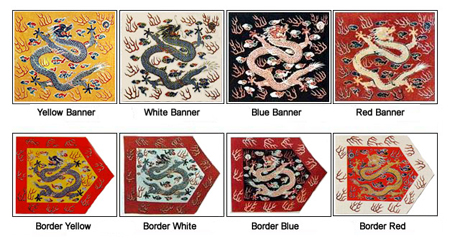
All imperial documents were written in both Chinese and Manchu, though as the years passed, Chinese became the de facto court language. Nevertheless, attempts were made to preserve Manchu culture. Immigration into the Manchu heartland was at first forbidden. Males in the new realm were required to shave the front of their heads and grow a long, plaited queue, new dress styles demanded that garments fasten from the side, and Manchu women were forbidden to adopt the Chinese fashion of foot-binding. This painful disfiguring practice involved winding long cloth strips tightly around girl’s and young women’s growing feet in order to shape them into small “golden lotuses.” Instead, upper class Manchu women wore high platform shoes and distinct, elaborate headdresses.
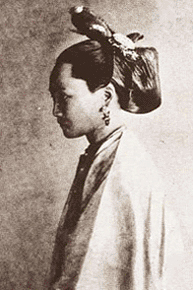 |
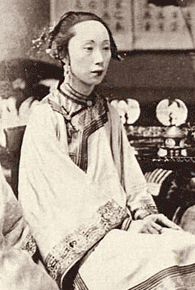 |
| Manchu women’s clothing and hair styles in the late Qing dynasty. | |

Two early Manchu emperors brought the Qing dynasty to its peak. These rulers were Kangxi and his grandson, Qianlong. Kangxi ruled for 55 years (1667-1722) during a time of great expansion. Qianlong left the throne after a reign of sixty years, a few years before his death. Under Qianlong the borders of China grew to their largest in history. Much of the expansion into lands on the northern and western borders seems to have been made to create buffers from perceived threats of overland invasion. Culturally, the Qing strongly censored historical and literary accounts for any anti-Manchu sentiments or romances, such as Outlaws of the Marsh, that might incite anti-government sentiment. On the other hand, Kangxi authorized the creation of a comprehensive dictionary of the Chinese language, encyclopedias of knowledge, and huge compendiums of ancient writings. European learning continued to be introduced into China, including Western methods of painting employing linear perspective. In the 18th and 19th centuries a number of great works of fiction were produced, as well as large numbers of plays. In all, the reigns of Kangxi and Qianlong were times of intense activity among the intellectual class, which included Han Chinese and the increasing number of Manchus raised in the traditions of Chinese scholar-officials.
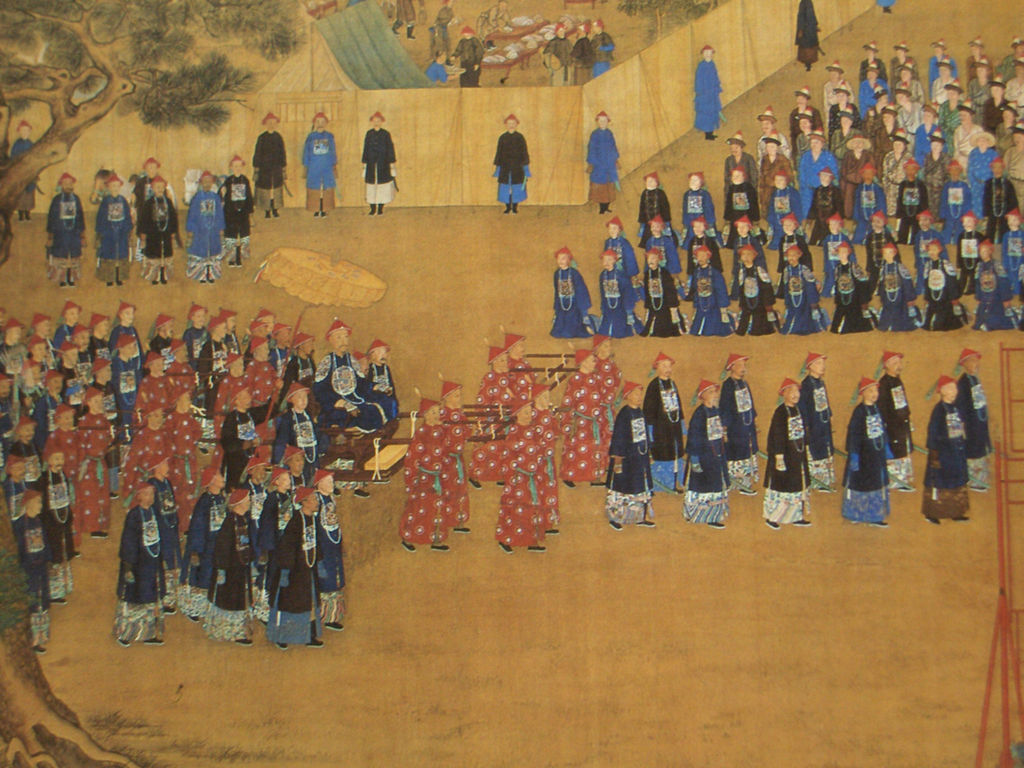
By the late 18th century, however, there were signs of decline, signaled by an uprising in Shandong of the White Lotus Sect, a Buddhist-inspired underground organization that had been involved in previous rebellions. Abuses by local officials seem to have been the cause. As Qing leadership waned in the early 19th century, the population was also outgrowing the means to sustain itself, which also led to rebellions. Large numbers of people, especially in the newly settled southwest, were living on very marginal land. This was due in part to the earlier introduction of crops like sweet potatoes and tobacco that could be grown in poor soil.

Trade frictions grew with the European powers, especially Britain. British merchants of the East India Company had long sought to right trade imbalances with China. The Chinese had little need for anything other than silver from the West, selling porcelain, silk, and tea in return. Eventually in order to recoup their silver, the British began illegally importing Indian opium into China, with the help of corrupt Chinese middlemen in specially designated coastal trade zones. When the Qing government moved to halt the illegal trade by burning confiscated opium, British traders petitioned their own government for redress. British gunboats fired on Chinese positions along the coast, outgunning the crude Qing cannon. The result of this so-called Opium War (1839-1842) was humiliation for the Qing government and a series of unequal treaties, including the Treaty of Nanjing that ceded the port of Hong Kong to the British in 1842.
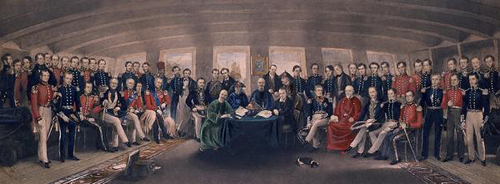
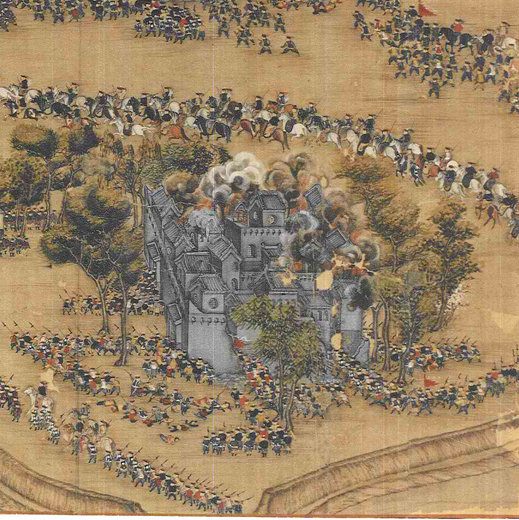
While foreign influence began to grow on Chinese soil, internal pressures mounted, finally erupting in the devastating Taiping Rebellion which raged from the early 1850s until 1864 and leaving an estimated 30 million dead. The rebellion began in the southern province of Guangxi and was led by a visionary of Hakka ethnicity named Hong Xiuquan. After failing at the local civil service examinations, Hong studied with foreign Christian missionaries. He had a vision that pronounced him the younger brother of Jesus Christ, who had been sent to earth to create a kingdom of “great peace.” Disenchanted peasants of several southern ethnic groups pledged themselves to Hong’s cause, giving up their property (which was then fairly redistributed among the revolutionaries), as well as abstaining from opium, tobacco, alcoholic beverages, gambling, prostitution, polygamy, and foot binding. Men and women were declared equal in the movement and soldiers lived a communal lifestyle. It is interesting that the grandfathers of several of the later Communist revolutionaries of the early 20th century were Taiping rebels. As the movement grew in force it swept through southern China and nearly took the southern capital of Nanjing. The rebellion was weakened by contradictions among the Taiping leadership. Qing government forces, now partially Westernized in military hardware and tactics (though still behind those of Japan), finally put down the rebels with the help of European soldiers.
 |
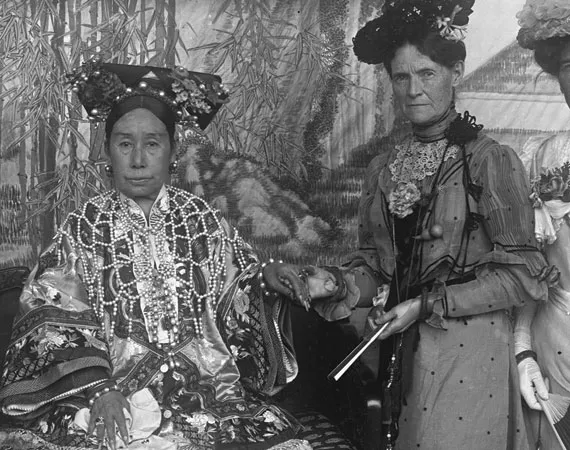 |
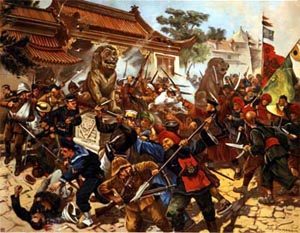
By the end of the 19th century it was becoming clear to many in China that serious changes must be made in order to preserve Chinese sovereignty in the face of aggressive European—and eventually Japanese—imperialists. Although a Qing “self-strengthening movement” had some success in military reform, the reforms were hindered by weak imperial leadership. By the end of 1890s the imperial throne was under the influence of a former concubine known as the Empress Dowager Cixi. In response to foreign naval threats, she squandered funds on a large marble pleasure boat, now a tourist attraction at the Summer Palace in Beijing. After losing the Sino-Japanese War of 1894-95 (fought over control of Korea), it became clear to all that Chinese power was little more than a shadow of the past. Reformers, including Kang Youwei, finally convinced the imperial government to institute experimental reforms in government and military in the spirit of the reforms that had all too clearly yielded results in the Meiji Reformation in Japan. The “One Hundred Days of Reform” (named for how long the reform lasted) were too much of a threat to the conservative imperial order, however, and its leaders were either beheaded or fled to Japan.
Things soon went from bad to worse. Another massive uprising, caused by famine and unstable social conditions, erupted in Shandong. This movement was led by the so-called Righteous Order of Harmonious Raised Fists (Boxers, for short). In 1898, the Boxers, who included de-mobilized soldiers, went on an anti-foreign rampage. A number of foreigners were killed, and armies of seven European countries and the United States fought off Boxer attacks throughout northern China. In the melee the imperial library was looted and huge amounts of treasure and antiquities were taken from China by foreigners, who ironically demanded indemnities for their own losses. More pressure was brought to bear on Chinese territory, and a fierce battle for territories in northeast China was fought between Russia and Japan, won by the Japanese, was fought in 1904-1905.
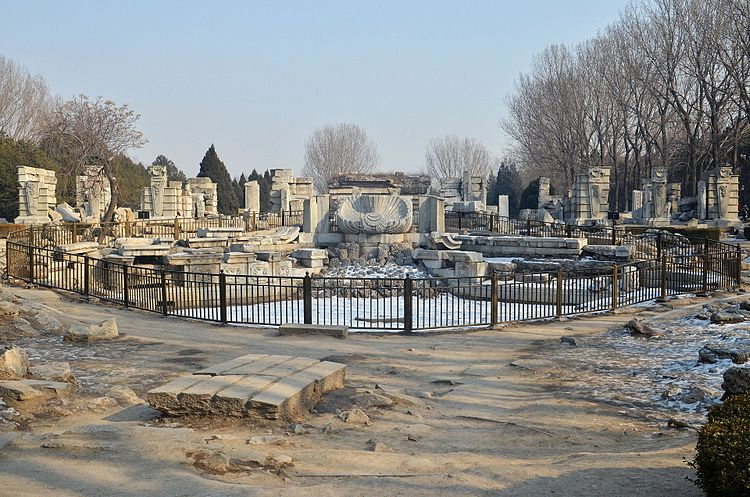

By 1905, the imperial system was in a state of near collapse and the civil service examinations were abolished in that year. Reform and revolutionary movements were rising both within and outside of China, many led by young Chinese students and others influenced by ideas they had learned in Japan and the West. Among these was Dr. Sun Yat-sen, who helped organize the revolutionaries that eventually ignited a rebellion in the city of Wuhan in the Yangzi Valley. Although Sun was outside China at the time, he soon returned and was elected president of the newly declared Republic of China. This was a modern style, Western-inspired government supported by a variety of social classes that all wished to see the Qing come to an end. Within a month, however, Sun stepped aside and Yuan Shikai, head of the Beijing military, was elected as president. The new government was unable to take control of the whole country, and local military governors began assembling their own spheres of influence. By 1915 Yuan Shikai declared himself emperor but died a few months later. Other leaders followed, but none could not stop the proliferation of warlords who set up local power bases, much as small states arose after the collapse of earlier Chinese dynasties. Sun Yat-sen founded an opposition government in southern China supported by his followers, the Nationalist Party.
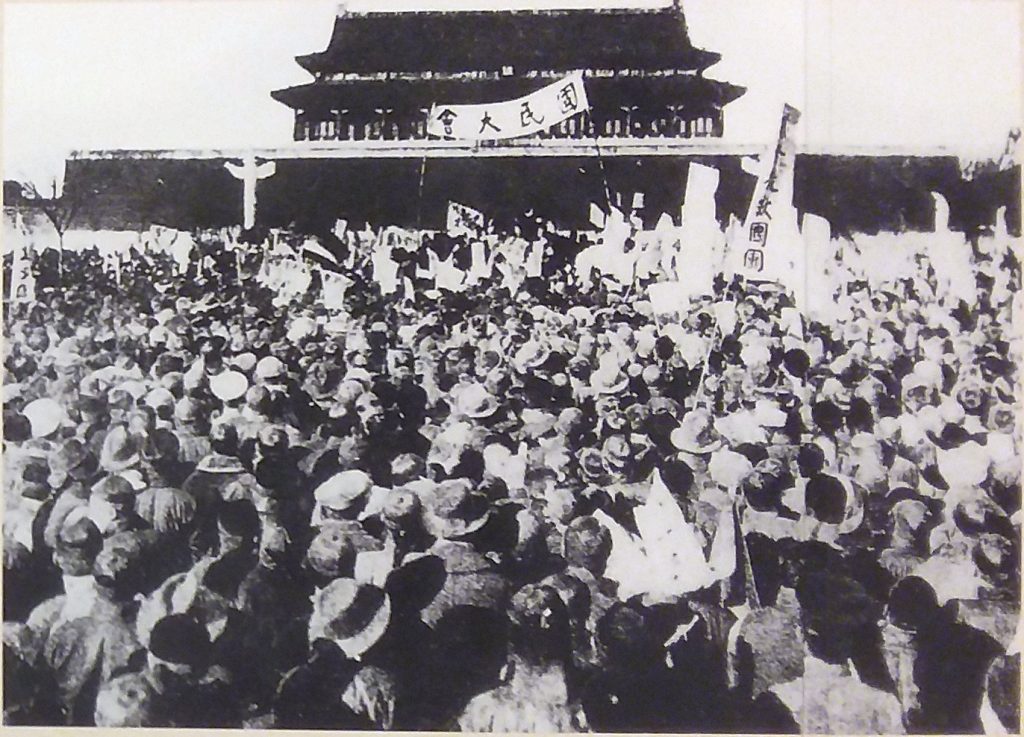
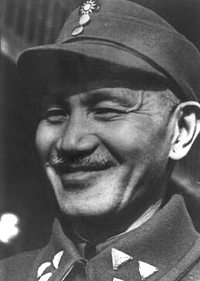
By 1919, following ill-treatment of China under the Treaty of Versailles that ended WWI, a movement arose among students and intellectuals at the new Peking University in Beijing. The May Fourth Movement was an intellectual and spiritual revival among educated, urban Chinese already exposed to many Western ideas and technology. Protests and marches were held and some students were shot by government soldiers. The students called for reforms in government, science, and culture—all similar to modernizations made in Japan over fifty years before.
After the death of Sun Yat-sen in 1925, Chiang Kai-shek (Jiang Jieshi), a young military officer who had received training in the Soviet Union, took control of the Nationalist Party. He quickly moved against the warlords. He undertook the Northern Expedition in 1927 and was quite successful in gaining control of parts of eastern China. His efforts were complicated, however, by the rise of the Chinese Communist Party, which was founded in 1921 by a handful of young revolutionaries inspired by the successful formation of the of the Soviet Union in 1917. Pushed underground by the Nationalists, the Communists retreated to mountain lairs in southern China, where they perfected their reform movement in neglected peasant areas.


By the late 1920s, the Japanese were threatening northeast China, where they set up a puppet-state in old Manchuria. A prolonged movement by the Nationalists to liquidate the Communist strongholds led the beleaguered Communists to undertake a retreat, walking 5,000 miles through the extreme terrains of southwest and western China. The Long March took over a year, from 1934-1935, and only 20,000 of the original 100,000 participants survived the march. It ended in a place called Yan’an in the mountains of Shanxi province, not far from the ancient Qin capital of Xianyang (near modern Xi’an). Among the marchers were the eventual founders of the People’s Republic of China in 1949: Mao Zedong, Zhu De, Zhou Enlai, and Deng Xiaoping. For a time in 1936, there was talk of a united front of Nationalists and Communists against the Japanese. In the so-called the Xi’an Incident, Nationalist generals Zhang Xueliang and Yang Hucheng, with the support of the Communist leader Zhou Enlai, kidnapped Chiang Kai-shek and forced him to join a united front with the Communists against the Japanese. This united effort, however, eventually fell through.
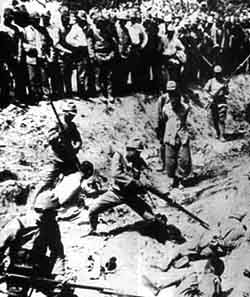
By 1937, the Japanese had invaded deep into China, bombing Shanghai and committing horrendous atrocities on the population of Nanjing. The Nationalist government, wracked by corruption and lacking in resolve, lost many troops in battles trying to protect the coastal cities. The government eventually retreated inland up the Yangzi River, finally creating a base in Chongqing, an area now within the borders of Sichuan province. Meanwhile, the Communists, from their base in Yan’an, spread their influence among peasants across northern China and penetrated behind Japanese lines using sophisticated guerilla warfare tactics.
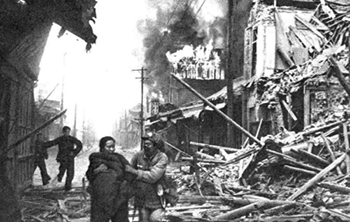
As the Anti-Japanese War (1936-1945)—what the Chinese call World War II —was winding down, the United States, which supported the Nationalist cause, briefly entertained the idea of a coalition government between Communists and Nationalists, and even sent a mission to Yan’an in 1944. Once the war was over in 1945, however, the US aided the Nationalists by helping them move troops to northeast China to accept the Japanese surrender and to check the advancing Russians who were interested in regaining ports and railway lines in Manchuria. Eventually, however, despite US support of the Nationalists, the Communist following was strong enough—due in no small part to the common cause they had found with the peasants in resisting Japanese invasion—that they won the civil war. The Chinese communists drove Chiang Kai-shek and the Nationalists to the island of Taiwan, which had been under Japanese control for over eighty years. In October 1949, Mao Zedong stood on the terrace in front of the Forbidden City in Beijing and declared the founding of the People’s Republic of China.
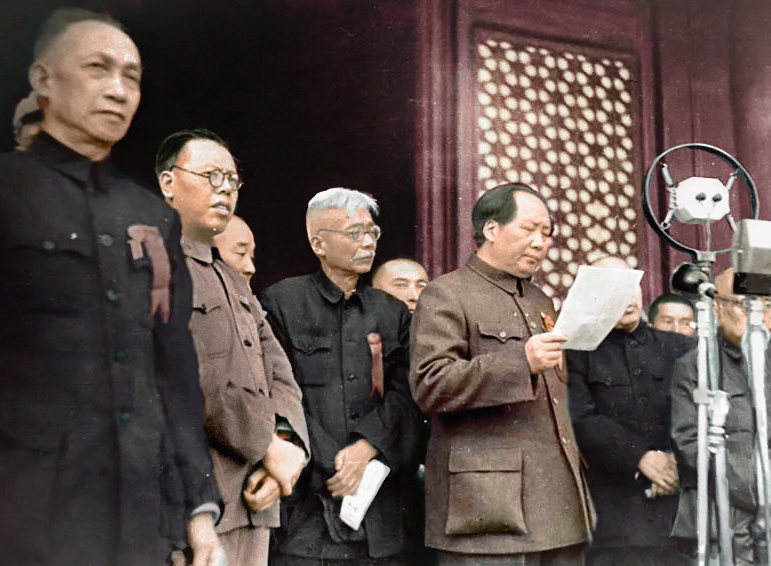
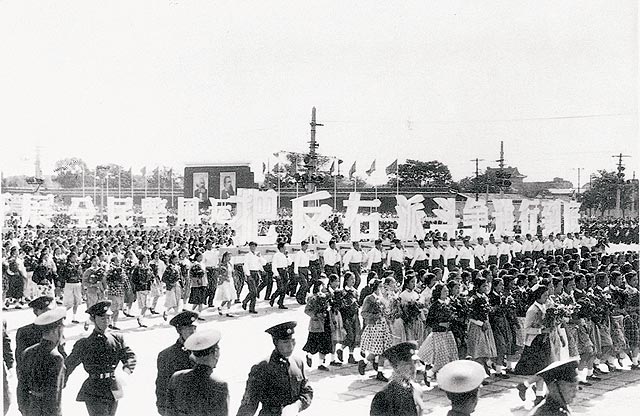
The early years of the People’s Republic saw land reforms and steps toward feeding, housing, and providing medical care to an estimated 400 million people in a country ravaged by over a century of almost constant war and rebellion. Mao Zedong, the major thinker behind the Communist revolution, was made Chairman of the Communist Party. By the late 1950s, questions began to arise among intellectuals and common people alike over certain of Mao’s policies, which were also challenged by some other Party leaders. In 1957, the government asked for constructive criticisms on its policies in a political movement known as the Hundred Flowers Campaign. The criticisms were more than Mao had gambled on and he soon launched a counter-revolutionary movement called the Anti-Rightist campaign. This resulted in the stigmatizing or imprisonment of many intellectuals and students who had offered even the most innocent suggestions.

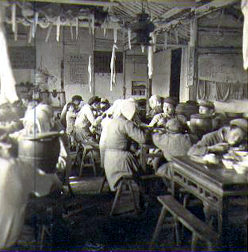
This began a prolonged era of periodic, government-induced political movements that wracked and divided Chinese society well into the late 1970s, with occasional policy repercussions even into the 1980s.
 |
 |
In 1958, in response to inner-party criticisms of the Anti-Rightist campaign, which some moderate Communists thought had gone too far, Mao launched a movement called the Great Leap Forward. During this period, Mao cut off relations with the Soviet Union, which had been supplying technical support to China since 1949. Throughout the country over 700,000 People’s Communes were created in a further expansion of land reforms already instituted in the early 1950s. Communal housing and kitchens were set up all over the country. At one point, the populace was burdened with the task of melting down any metal objects they could lay their hands on in homemade smelters to raise China’s steel production to the level of Britain’s within five years, a challenge set by the top leadership. China could not rapidly overtake developed countries on a wave of Socialist zeal alone, however, and this utopian project failed. With the mass of peasants involved in steel production, however, harvests failed around the country and by 1961 over 30 million people (even according to Chinese statistics) had starved, a tragedy compounded by the actions of many local officials who, in trying to please their superiors, had inflated grain production figures reported to the central government.
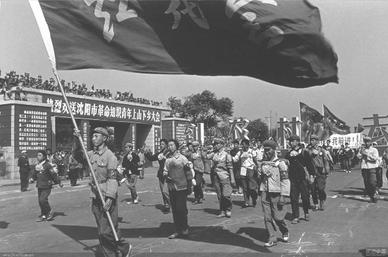
By 1963, Mao had been skillfully shunted aside by Liu Shaoqi and Deng Xiaoping, leaders who suggested that experiments with basic market-based production be tried. Within a few years, however, Mao had rallied his many allies, and began a movement that indoctrinated the young people of China, urging them on as the vanguard of a radical new movement against counter-revolutionaries in the schools and government offices. This was the Great Proletarian Cultural Revolution.
By 1966, huge rallies of young people, called Red Guards, were trekking (sometimes over a thousand miles) or riding free trains to massive rallies in Tiananmen Square in Beijing in hopes of glimpsing Chairman Mao as he spoke to them. Violence broke out as Red Guard groups “struggled” against “reactionary” teachers and officials. Some were beaten to death by overzealous students or committed suicide out of shame after public rallies in which degrading signs were hung around their necks and pointed dunce caps placed on their heads.
By 1968, the Red Guard movement had spun further out of control and factions fought among themselves to prove their loyalty to Mao. Eventually the Red Army interceded, and large numbers of students and urban youths were sent to rural areas to “learn from the peasants.” Life on the communes was not easy for many of the city youths and older intellectuals who had been branded as “counter-revolutionaries.” The peasants, with no clear idea of what was going on in the cities, often resented the sudden arrival of groups of city-raised youth.
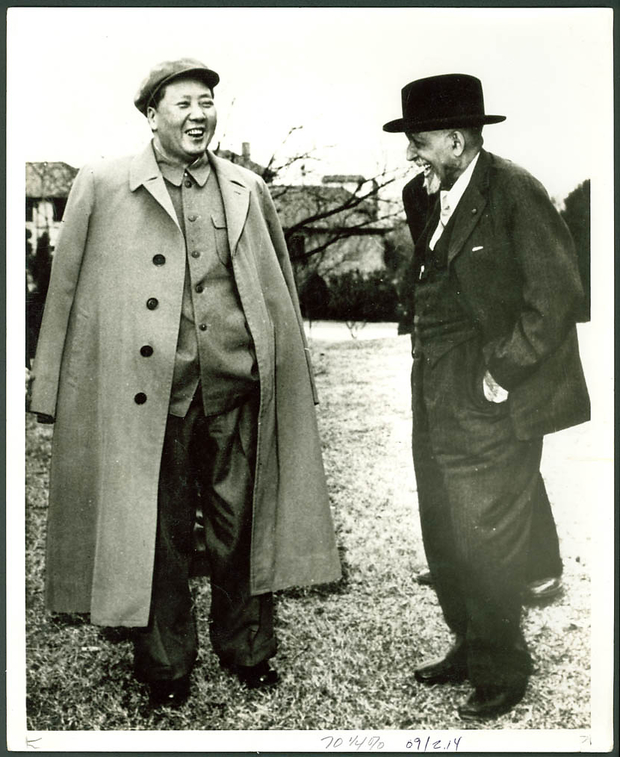
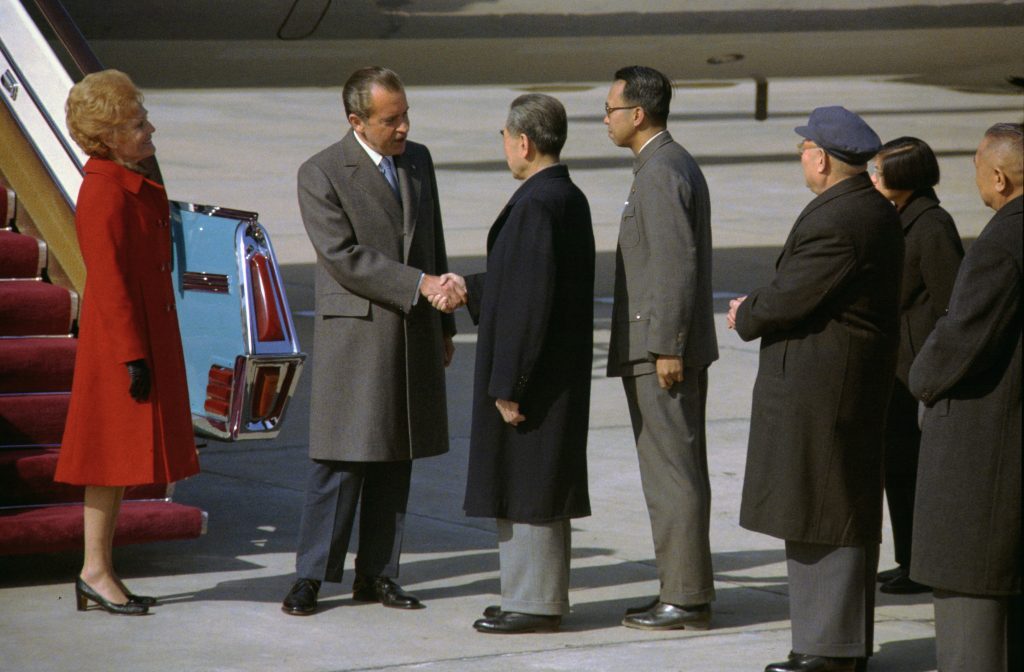
By the early 1970s as Mao aged, a group called the “gang of four,” which included one of Mao’s wives, an actress named Jiang Qing, took control of the country. Also, during the early 1970s, US President Richard Nixon and his aide, Henry Kissinger, began secret talks with the PRC leadership. These talks eventually led to a well-publicized ping-pong match between Chinese and American athletes touted as “Ping Pong Diplomacy.” And, in 1972, Nixon visited China, meeting with Premier Zhou Enlai (a respected diplomat who had managed to stay the course through years of chaos), and a then-senile Chairman Mao.

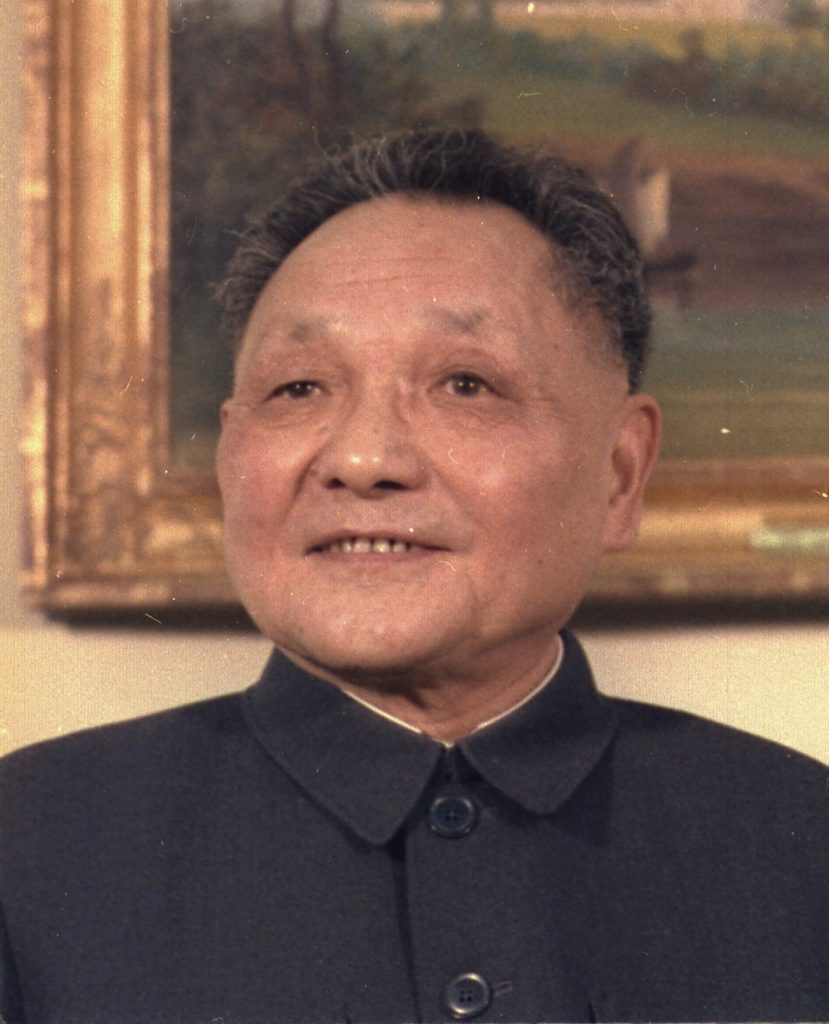
Mao died in 1976, a year that also brought the deaths of Zhou Enlai and Zhu De, and an earthquake in Tangshan that killed 250,000 people. The ten years of Cultural Revolution ended with the capture of the “gang of four” by the Chinese army. By 1980, reformer Deng Xiaoping (who stood only 4’9”) used his political skills to come to power. Jailed three times by Mao, he was always considered a creative intellect, due in part to several years spent in France in his youth. By the early 1980s, Deng had systematically set China on a new course towards a more open, economically viable society. Abandoning radical Maoist ideas on communal economy, the new plan was to create “socialism with Chinese characteristics.” Although finding a new direction was sometimes difficult, in all the process was carried out in a very systematic way, combining socialist and previously taboo capitalist principles.
As a first step, the people’s communes were dissolved, and a “household responsibility” system was put in place in the rural areas. Now, instead of laboring for “work points” farmers could control what they raised and keep a larger share of the profits. Land was redivided under renewable contracts and sideline productions of animals, fruit, and other items were again allowed and encouraged. Once the rural economy was stimulated, more liberal policies were launched in the cities, and small private businesses staffed by “unemployed youth” supervised by older advisers were encouraged. On a larger scale joint ventures were allowed between government companies and foreign firms in some coastal cities. An experimental capitalist city called Shenzhen was also built near Hong Kong. Lessons learned there were later applied to other cities.
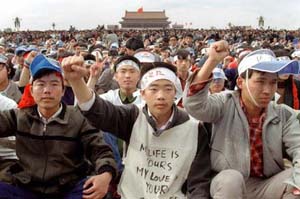
Changes came fast and expectations rose faster. By the late 1980s, unrest developed among idealistic students on campuses in Beijing and Shanghai. Students raised complaints against government corruption and called for more democracy and a swifter pace towards openness and modernization. By the spring of 1989, over 90 days of protests in Tiananmen Square resulted in a popular uprising in which several soldiers were killed and burned. This stimulated a brutal crackdown by the government which resulted in the deaths of an unknown number of civilians, including some students.

After several years of retrenchment, economic policies were reaffirmed in the spring of 1992 and China entered a stage of rapid economic growth. After Deng’s death in 1997, the reforms progressed even more rapidly, leading the Chinese economy to an average growth rate of 8-9 percent a year into the early 21st century. Also, in 1997 Hong Kong was returned to China from Great Britain and became a special administrative zone of the PRC. A new area of Shanghai called Pudong marked Shanghai’s economic rebirth, more and more government companies became private, and foreign investment skyrocketed. This foreign investment included that from Japan and Taiwan (which had successfully modernized its economy by the early 1980s and instituted democratic reforms in the late 1980s). Stock markets were founded and became a passion for everyday citizens. Millions of peasants streamed into urban labor markets, forming a huge “floating population” of over 150 million temporary workers. New forms of popular culture spread throughout the country via television, a relatively liberalized film industry, and the Internet. Universities began charging tuition and some students took part-time jobs (unthinkable before the late 1980s). In some rural areas, health care became expensive, and its delivery and quality declined, along with other social services like education. In general, however, new optimism fueled by opportunity and intense competition ignited in young people across the nation even as corruption found new outlets in the dynamic economic environment. Despite enforcement (with some slackening over the years) of the “one-child” birth control policy in force since the late 1970s, China’s population reached 1.3 billion by 2004. In 2002, China joined the World Trade Organization, becoming more fully integrated into the world economy. China’s first “taikonaut,” Yang Liwei, orbited earth in 2003, and plans were soon announced for a future lunar mission.
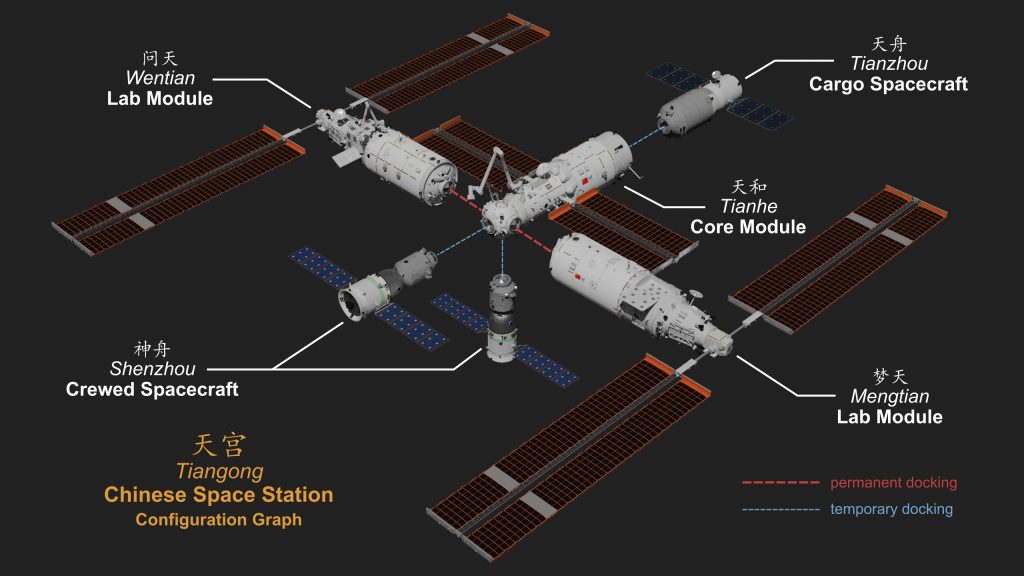
Moving farther into the 21st century, the Chinese economy grew and matured as its middle class expanded to over 350 million. Massive urban building projects, including ecologically planned “mega-cities,” and many new universities dotted the landscape. In 2021 Xi Jinping, who spent part of his youth in rural Shaanxi province during the Cultural Revolution and was later a foreign exchange student in Iowa in the United States, became president. Xi went on to hold many other leading roles in government and the military. Ushering in an era of reforms, he launched an extended anticorruption campaign and promoted a nationalist agenda named the “China Dream,” an agenda that seeks to build China into a moderately prosperous country and a leading world power.
Huge investment in infrastructure (high speed rail in particular); addressing environmental concerns; pursuing China’s territorial claims in the South China Sea and other areas; developing the “One Belt, One Road” global trade linkage project; rural poverty alleviation; oversight of the internet; harnessing artificial intelligence technology; refining a “parental” model of social guidance and regulation; and increased urbanization in accord to “green” principles; and creating a situation of “common prosperity” within a system of “whole-process democracy” are all areas of activity in the country directed by the government. In 2021, the child-birth limit was raised to three children, as demographics indicated that birthrate was too low to replace the aging population. By early 2020, tensions between China and the West over economic trade and human rights concerns in Northwest China and Hong Kong, were exacerbated by the COVID-19 Pandemic, which was first identified in Wuhan.
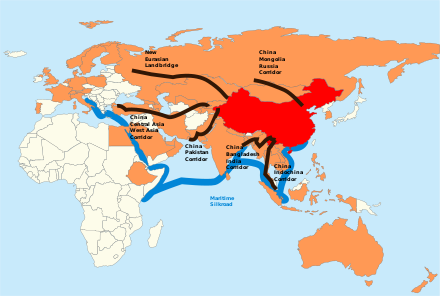
As of May 2021, just weeks before the 100th anniversary of the Chinese Communist Party, both the United States and China landed space-rovers on Mars (and China placed a manned space station in orbit), highlighting the growing competition and rivalry between an established superpower and a rapidly rising one. In March 2023, Xi Jinping began his third five-year term as president of China. What the future holds for China and the world remains to be seen, but the repercussions will be felt by all.
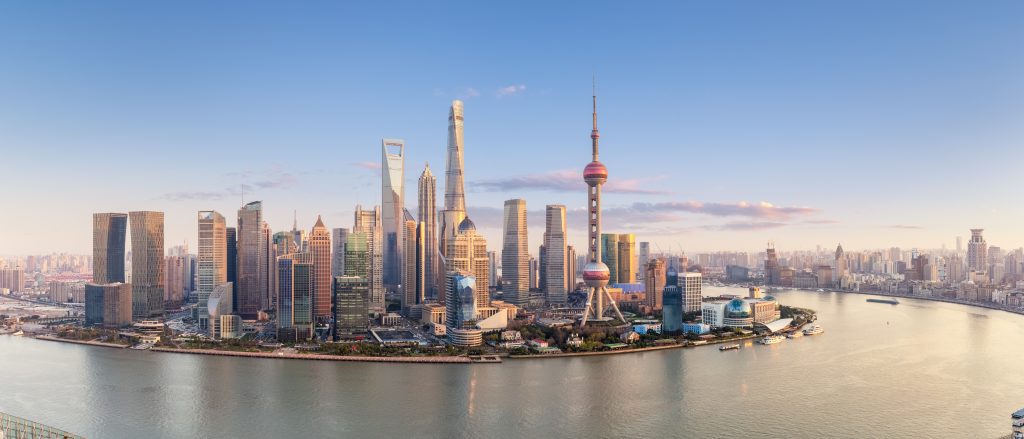
Selected sources:
Chao, Eveline (2016). Let One Hundred Panthers Bloom: The Black Panthers and Mao Zedong. China File. October 14.
https://www.chinafile.com/viewpoint/let-one-hundred-panthers-bloom
Muhlhahn, Klaus (2019). Making China Modern: From the Great Qing to Xi Jinping. Cambridge: Belknap Press, Harvard University.
Roberts, J.A.G. (2003). The Complete History of China. Gloucestershire: Sutton Publishing Limited.
Willimas, Alexandria S. (2019). From W.E.B. DuBois to the Panthers: A History of Black Americans in China. RADII. Feb. 27.https://radiichina.com/from-w-e-b-du-bois-to-huey-newton-a-history-of-black-americans-in-the-early-prc/
Eberhard, Wolfram (1977). A History of China. Berkely: University of California Press.
Korean History
PART 1: OVERVIEW
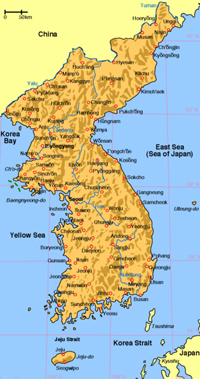
The Korean peninsula is located at the eastern end of Asia, between China, Siberia (now part of the Russian Federation), and the islands of Japan. Because of the complex, shifting historic relations between these areas, as well as relations with other places such as the United Sates in more recent times, the history of Korea has been told in many ways and is still the subject of hot debate both inside and outside the two Koreas. North and South Korea have different versions of the peninsula’s history, both of which differ in detail and perspective from Korean histories written in China, Japan, Russia, and the USA. The following sections, which attempt to outline Korean history in a balanced way, are based on a variety of materials, including lectures given in a special workshop on Korean culture at Korea University in the summer of 1997.
The overall pattern of development in the history of the Korean peninsula is a process that begins with an unknown number of early tribal groups that populated the peninsula in prehistoric times, wandering out of Siberia and areas to the west. Over time, some of these groups formed more complex societies. These eventually resulted in early kingdoms that grew up on the peninsula, in some cases extending westwards into what is now Chinese territory. As time and events unfolded, these kingdoms were unified, though the borders and degree of unity have continued to change over time—down to today. Besides the obvious split between North Korea and South Korea, cultural differences (including dialect, food, and local identity) exist between the various regions of the peninsula. In some cases these differences are enough to influence the results of political elections. Nevertheless, Korean culture is highly homogenous in comparison with China, and even Japan.
Over the last 2,000 years the Korean peninsula has been wracked by eight major invasions and countless smaller wars and incursions. Strategically situated on a partial land bridge in the Yellow Sea interaction sphere, the peninsula has been a natural access route for invasions to and from the Asian mainland. In times of war armies tend to push each other up and down the peninsula, guaranteeing that many areas will be subject to repeated devastation—a dynamic very prominent in the Korean War (1950-53).
Among the many invaders have been ancient Chinese kingdoms, Qidans (Khitans), Mongols, Japanese, and Manchus. In the 20th century, Korea was colonized by Japan and in the Post-WWII era was caught in the middle of conflicts between the United States, the Soviet Union, and China over the expansion of Communism in the Cold War Era. The Cold War, in fact, still lingers in the as-yet unresolved division between North Korea and South Korea. In some instances, invaders have left their mark and even ushered in periods of positive cultural exchange, others left only devastation was left in their wake. Despite these challenging circumstances, Koreans have managed to maintain a unique cultural identity that marks them as hardy survivors.
Today, for example, South Korea has among the most “wired” societies on earth in terms of Internet access and has a dynamic economy that grew by leaps and bounds throughout the 1980s and early 1990s and has matured in the early decades of the 21st century. South Korea was also a leader in economic recovery after the Asian economic crisis of 1997 and continues to have a dynamic economy today in the 21st century. North Korea is poised to undergo changes within the next decades that will in part determine the stability of East Asia and the northern Pacific Rim. In short, the Korean peninsula, always integral to the dynamics of regional power and politics, will continue to play an important role on the world stage.
PART 2: PREHISTORY AND EARLY KINGDOMS
Prehistory and Myths

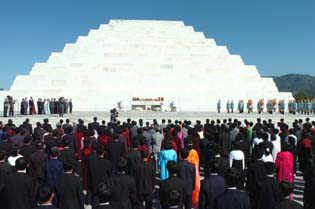
Traditional myths of ancient Korea say that over 4,000 years ago the King of Heaven, Hwanung, descended near a Tan tree on Mt. Taebaek in what is now North Korea. Accompanying him were 3,000 followers, and he ruled over all their needs. In a nearby cave lived a tiger and a bear who wished to become human. To test them, he gave them mugwort and garlic to eat and requiring them to live in darkness for 100 days. After only a few days, the tiger could no longer stand it and ran out into the mountain forests. The bear, however, stayed in the den, finally emerging as a beautiful woman. She repeatedly prayed beneath the Tan tree for a child, and Hwanung momentarily transformed himself to marry her. They produced a wonderful child they called Dangun. Dangun invented the basics of civilization and created a dynasty that lasted for 1,500 years. This was followed by a period called Gija Joseon that lasted 99 years. Dangun is still regarded as a great cultural hero and his memory is marked each October 3rd on Foundation Day. Depictions of Dangun often show him with a tiger, which is regarded as a mountain god.
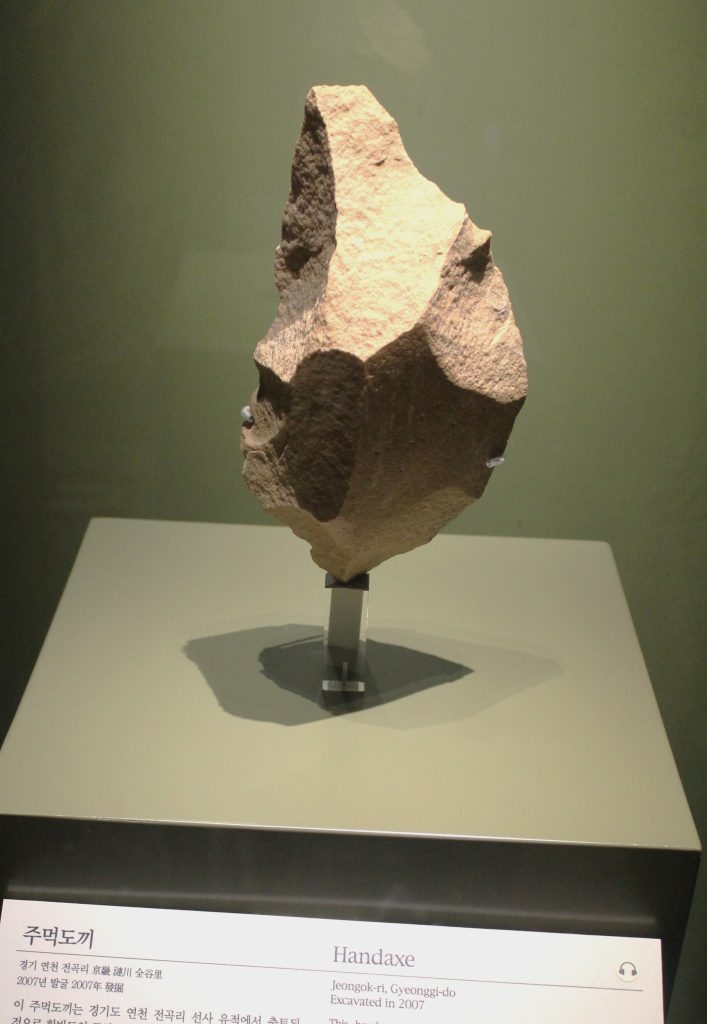

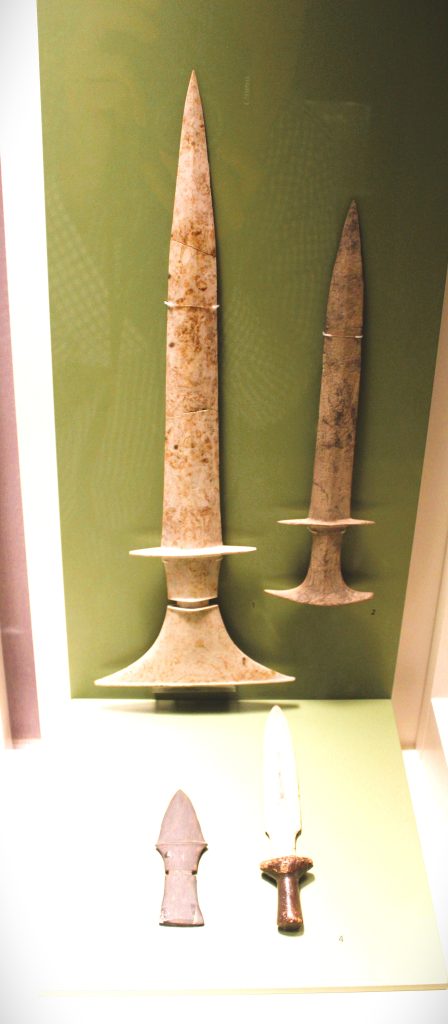
Archeological evidence indicates that the presence of modern humans in northeast Asia dates to approximately 39,000 years ago. By 6,000 BCE Neolithic cultures appeared on the Korean peninsula. Early inhabitants were hunters and gatherers who migrated onto the peninsula from the Manchurian Plateau and Siberia. By 1200 BCE agriculture was widespread and bronze tools were in use. Towns were protected by earthen fortifications and society became increasingly stratified. By 400 BCE Chinese records tell of formidable cultures on the peninsula. Among these early peoples were the Yemak and Puyo. By 108 BCE, the Han Empire of China had set up several posts on the peninsula after battles with the Wiman Joseon kingdom. Over the next four hundred years many aspects of Chinese culture were assimilated into the various peninsula cultures. As time went on, small kingdoms grew and sometimes confederated on the peninsula. Some had closer relations to China than others, which served to their advantage if conflicts broke out with other kingdoms.
The Three Kingdoms

With the decline and fall of the Han dynasty, the Chinese command posts were gradually abandoned, and three major kingdoms emerged on the peninsula. These rival kingdoms were:
Goguryeo (37 BCE-668 CE), located on the northern half of the peninsula, and part of what is now northeast China; Baekje (18 BCE- 660 CE), located in the peninsula’s southwest; and Silla (57 BCE-935 CE), located on the southeast of the peninsula near present-day Gyeongju.
Although the kingdoms differed in many ways and even may have spoken different languages, there were some commonalities. All three were agricultural economies based on rice cultivation (though other grains such as wheat and millet were also raised). Their trade was mostly through barter, with a limited use of shell money or Chinese coins. Transport was by horse, oxcart, and ship.
Each of the kingdoms developed rigid social hierarchies in which a small, powerful ruling class was drawn from a small number of families. Rule was passed from father to the first-born son in a system of primogeniture. The elite were ordered in the so-called “bone rank” system (something like the idea of aristocratic “blue blood” in feudal Europe). According to one’s “bones” (i.e. lineage), a person could rule as king (an option limited to very few), serve on governing councils, or hold government positions at varying levels in the provinces, counties, and smaller units of government throughout the realms. There were also numbered grades of lower aristocracy called “head ranks” (6, 5, 4), and free citizens (3, 2, 1), as well as classes below these that included slaves and criminals. Movement between classes was strictly controlled. A hierarchical system was also used in the military organizations, which was led by the king.
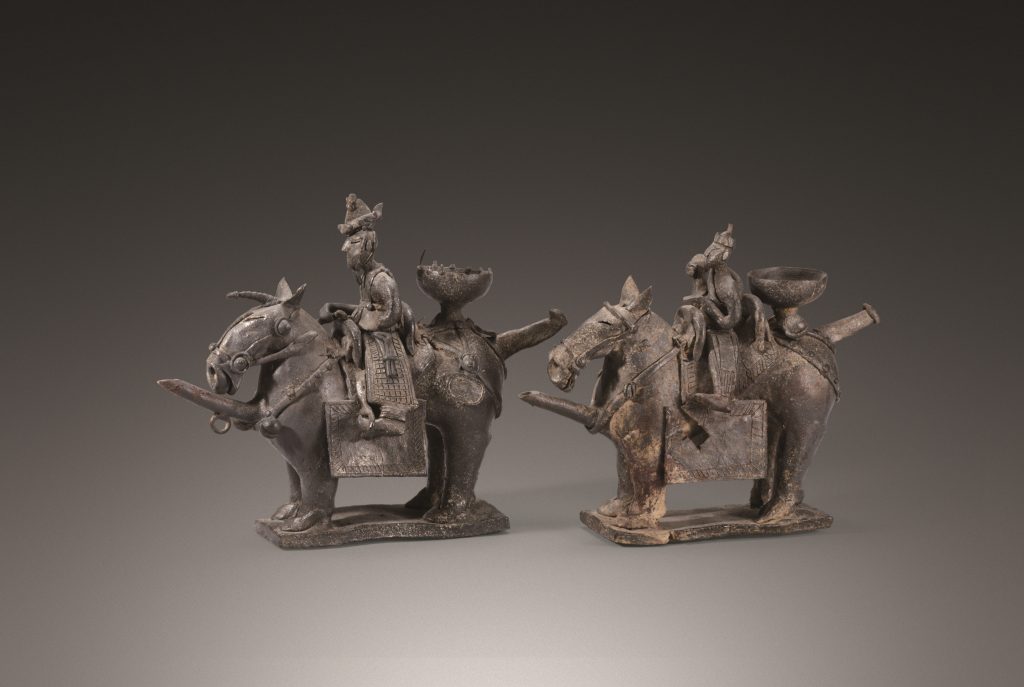
Each kingdom developed effective military forces of cavalry and foot soldiers employing weapons that included iron swords and spears, as well as bows and arrows. All three kingdoms developed under the influence of Chinese culture. Archaeological evidence in the form of glass objects and animal designs on jewelry also suggest contact with other cultural forces from farther west on the Asian landmass.
Buddhism was adopted by the northern state of Goguryeo in 372 CE and in Baekje in 384 CE. Silla, on the more remote eastern end of the peninsula, did not adopt Buddhism as a state religion until 528 CE. One reason that Buddhism was so quickly accepted in some areas may have to do with its reinforcement of social roles, which Buddhists believe are decided by actions in past lives. This meant Buddhism could be used in justifying and maintaining the status quo. If people accepted their lot in life, they were easier to control. Confucianism and Daoism were other aspects of worldview that gradually penetrated all three of the kingdoms.
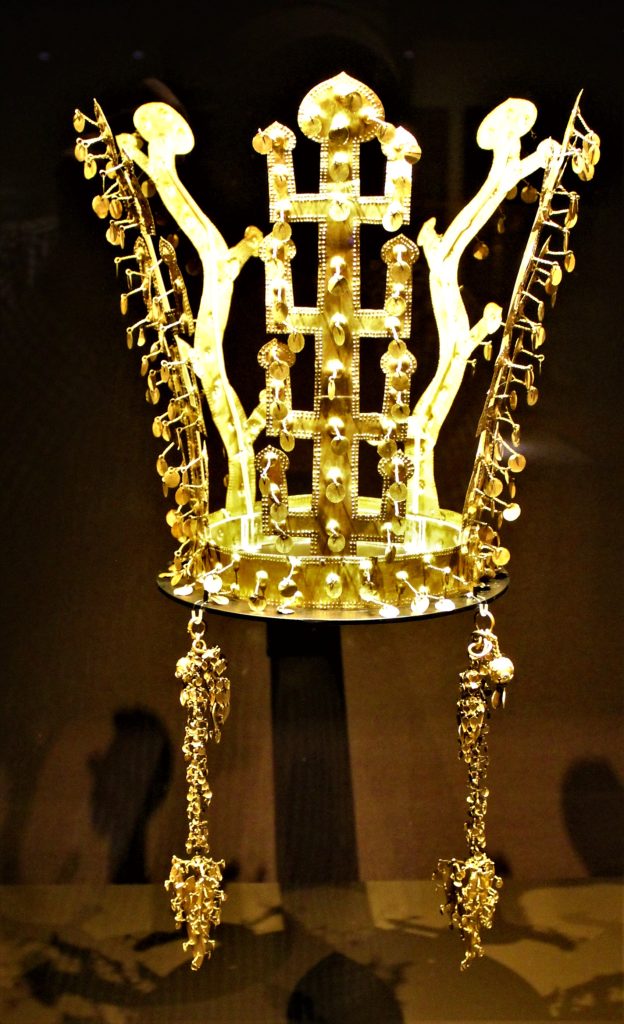
Buddhism heavily influenced the art of the kingdoms, too, especially in terms of temple architecture (temples were built of native stone and wood), sculpture, and tomb paintings. In Silla, a type of gray, ash-glazed ceramic was developed. Silla rulers also wore intricate crowns made of thin sheets of gold that incorporated symbols of celestial trees and deer antlers. Education of the upper classes included foreign language studies in Sanskrit and Chinese in order to better read the Buddhist sutras and Confucian classics.
In Silla a special cadre of talented young men were cultivated in civil and martial arts, and inculcated with the time-honored values of chivalry, patriotism, harmony, and unity. These young men (something like West Point cadets in the United States in our time) were known as the “Flower Youth Corps” (Hwarangdo). The kingdom of Goguryeo had a similar youth organization.
In general, China was regarded as a cultural model and tributary relations existed with all three states. There were also relations between some of the kingdoms and Gaya, a small league of states at the tip of the peninsula that had close relations with the Yamato culture in southern Japan. During the Three Kingdoms era, there was almost constant fighting between the rival kingdoms and the borders shifted many times. The first Korean history of the Three Kingdoms era, called Samguk sagi, was written many centuries later by Kim Bu-sik in 1145 CE.
PART 3: UNIFIED SILLA (SHILLA) AND GORYEO (KORYO) DYNASTIES
Unified Silla Period (668 – 935 CE)
Although Goguryeo was the earliest, largest, and most powerful of the Three Kingdoms, by the 7th century it was suffering from a decline in leadership and was weakened by wars with Sui dynasty China. For sixteen years, a tremendous number of resources had been used in constructing a long wall between Goguryeo and China. Silla, on the other hand, was modernizing its government and eventually strengthened its relations with the newly established Tang dynasty, though the process involved a complex series of alliances and broken alliances among the various states of the region. Eventually, Silla was able to defeat both Baekje and Goguryeo in a series of wars and take control of much of the peninsula. It set up a unified state comprised of large portions of the former Three Kingdoms. By this time the Silla state closely followed the structure of the Chinese government, with a powerful ruler who oversaw 6 bureaus filled with officials who oversaw the affairs of the state, which included war, finance, and public works. The Unified Silla era became a time of relative peace, prosperity, and cultural growth. Today, a great number of archaeological sites and artifacts from the period can be found in the former Silla capital of Gyeongju in the east of the peninsula.
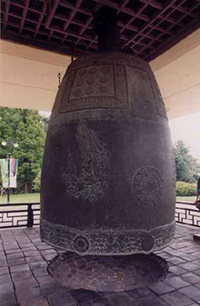 |
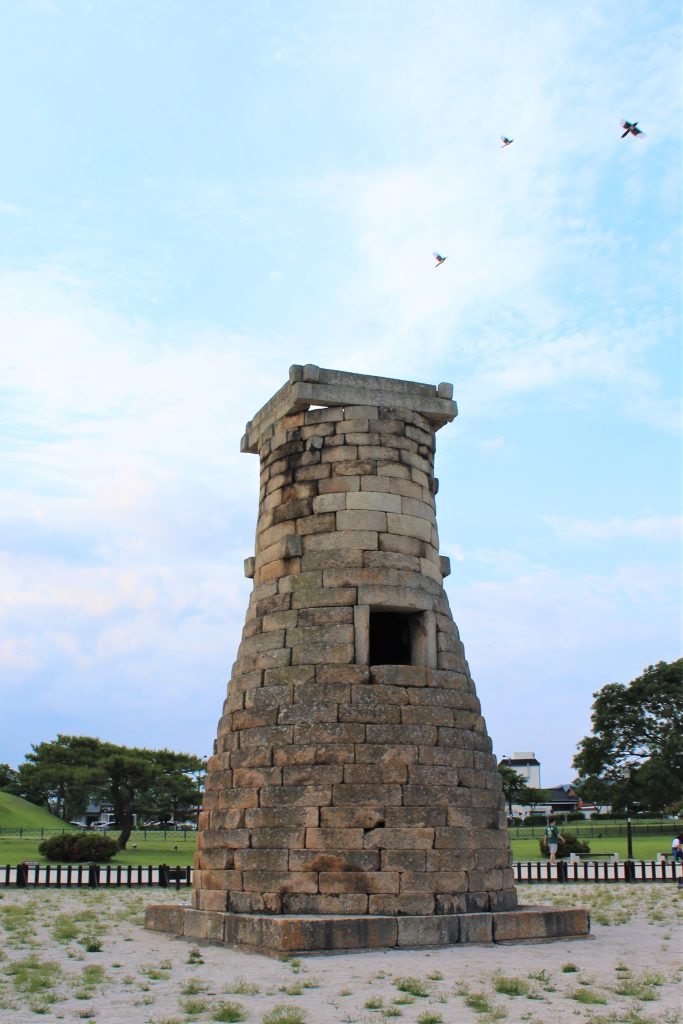 |
These include the Silla tombs, burial mounds of the ancient Silla royalty. A number have been excavated in Tumuli Park and have revealed a wealth of information on Silla culture. Although the custom of burying living servants with the rulers was abolished in 502 CE, numerous and lavish grave goods such as jewelry, everyday use items, and weapons accompanied the dead. Another famous site is the Queen’s Astronomical Observatory (Cheomseongdae), the oldest observatory in East Asia. It was built about 647 CE by a Korean queen. The structure is 9.4 meters in height and has 27 layers of cut stone—all arranged in accord to precise mathematical calculations that relate to the heavens. The National Museum, which houses many treasures from Korean history, houses the so-called Emille Bell, another treasure of this period. Dating to 770 CE, the bell was cast in bronze with funds collected by Buddhist monks. According to the tale, the bell would not ring clearly when first cast. A human sacrifice was deemed necessary. As the story goes, an infant farm girl was volunteered for the honor and cast into the molten metal. When the bell was recast, it rang with an “emillie” sound, like a cry of a child for its mother.
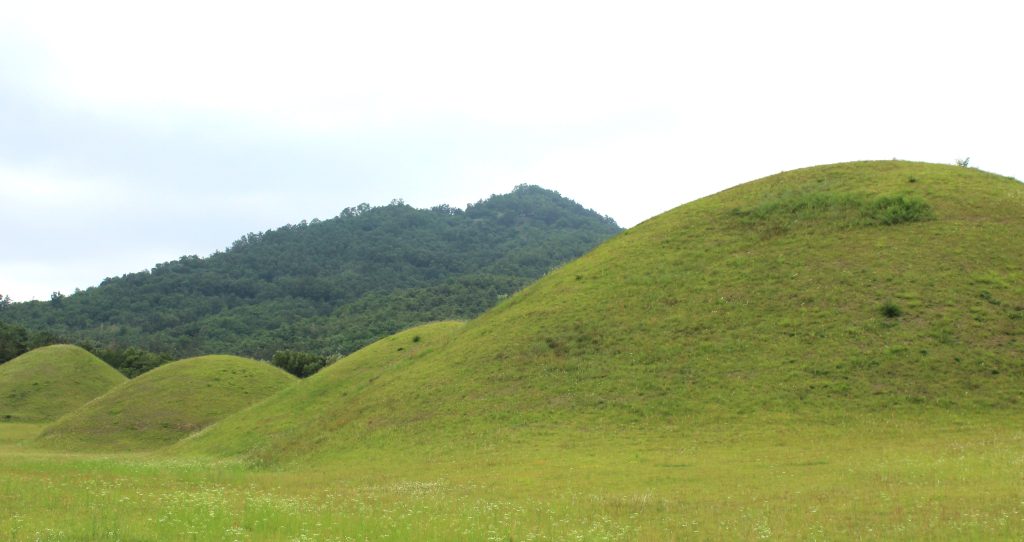
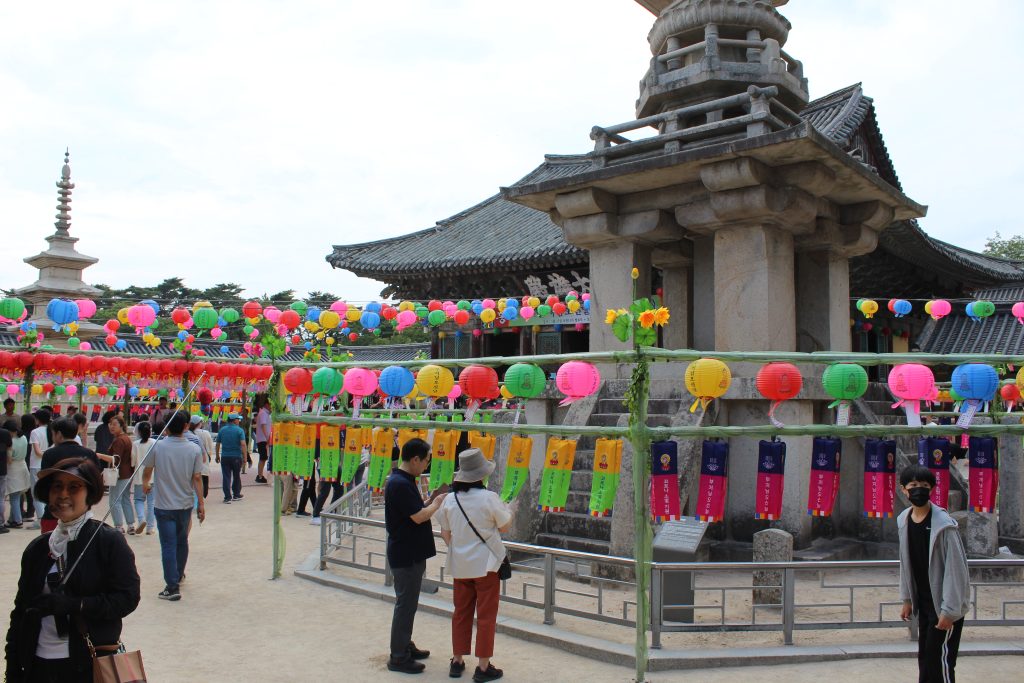
In the nearby mountains is a great granite and wood temple known as Bulguksa, meaning “Temple of the Buddha Land.” Dating to the early 6th century CE, it has been reconstructed several times after periods of warfare. The temple is the finest example of Silla-style temple architecture in existence. In the main courtyard are two small pagodas known as Seokgatap Pagoda and Dabotap Pagoda. According to traditional stories, a newlywed stoneworker was commissioned to carve the two pagodas. His work took him far from home for several years. One night he had a dream that his wife was standing by a pond near Bulguksa, awaiting his return. Little did he know that his dear young wife had made the long journey to the temple site and was indeed waiting for him outside. After several days, however, she had not caught even a glimpse of her busy husband. Several locals told her to look at the reflection of the pagodas in the pond. She did so, but still did not see her husband. Believing she would never see him again, she jumped in and drowned. Later, when her husband heard of her death, he ran about the pond and forests, searching for her in vain. He finally found a human-shaped rock and carved a Buddha upon it in remembrance of his wife.
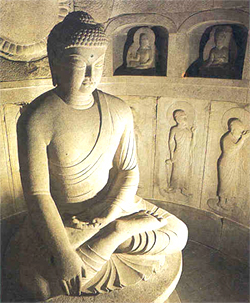
One of the most outstanding architectural and artistic feats of the Unified Silla period is the Seokguram Grotto Shrine, located in a mountain cave not far from Bulguksa Temple. Dating to 751 CE, the grotto was eventually lost, and lay for centuries undisturbed. In 1909 it was re-discovered when a mail courier took refuge in it from the rain. The central sculpture is a sublime carving of Sakyamuni Buddha executed in white granite. The massive carving, crafted from a single piece of stone, commands the interior of an arched vault and measures seven meters in diameter. The vault is constructed of intricately shaped, interlocking slabs of granite. The domed walls are lined with carvings of Buddhist deities, including the Four Heavenly Kings and an array of bodhisattvas and disciples. The site is a testament to the high level of mathematics, astronomy, architectural principles, and artistry of the Unified Silla period in East Asia during a time when powerful cultural influences were traversing the Silk Road.
Although Silla unified and controlled most of the peninsula, another state eventually formed in parts of the former Goguryeo (Koguryo) kingdom to the north. This kingdom, also ruled on the Chinese model, was known as Balhae and was situated between northeast China (what came to be known as Manchuria) and Silla. The Balhae kingdom was established in 716 CE and lasted until 926 CE. As the Tang dynasty declined in China, leadership in Unified Silla was also weakening. During uprisings and fighting the Unified Silla state fell into pieces somewhat along the lines of the old Three Kingdoms. Eventually a rebel leader named Wang Geon became strong enough to challenge Silla. In the end, he and the last Silla king ended it amicably by each marrying one of the other’s daughters, with Wang taking control and allotting the former king a large holding of land. The new state would be known as the Goryeo dynasty.
Goryeo Dynasty (918 – 1392 CE)
The Goryeo dynasty Wang Geon founded extended the borders of the defeated Unified Silla northwards into parts of old Gogoryeo—Goryeo is a shortened form of that name. The name “Korea” is derived from Goryeo. In his bid to maintain control over the new kingdom, Wang Geon followed an old Chinese strategy (also used in Tokugawa Japan). He forced local rulers to send male members of their families (often sons) to live in the capital as virtual hostages. He also took 29 consorts from families of position all over the realm. Although this initially helped him gain control, in the long run succession problems arose because of the many powerful families involved.
In the Goryeo period, the government became even more complex and centralized than it had been in Unified Silla. The Chinese model was followed even more closely. Civil service examinations were established, and open to all except the lowliest classes. Special considerations were made, however, for sons from the higher ranks of society, who could be given positions by appointment. Examinations were based on composition, knowledge of the Confucian Classics, and occupational knowledge such as astronomy, mathematics, and law. A national academy was established as well as private institutions of learning. Although in theory there was no private ownership of land, land tracts were often given to high office holders and military personnel. Taxes were levied on landholdings and households and the government could demand yearly service for labor projects. Individual regions, which specialized in certain products, might also be asked to supply quotas of these goods. The government also ran production industries (manufactories) in the capital and provinces that were staffed by artists and craftspeople. Some in the provinces were staffed by persons in the lowest social classes. Products ranged from consumer goods, such as precious metals (gold and silver), salt, silk, charcoal, paper, ink, and roof tiles, to agricultural items such as fruits, grain, sesame, and ginger.
Although the bone rank system of Silla had been broken by the rise of powerful new families and by rebel leaders drawn from lower classes, hierarchy was still a powerful social concept. The new classes that emerged in Goryeo fell into six ranks in the following order of importance: 1) the royal caste group, comprised of relations to the royal clan; 2) a class of civil and military officials known as the yangban (“two classes”); 3) palace functionaries of lower official rank; 4) regional clerks and other lower government officials; 5) tax-paying free citizens, mostly peasant farmers, fishermen, artisans, etc.; 6) inferior, stigmatized people such as butchers and market hunters (who were considered defiled by Buddhism because they took life), itinerant peddlers, the female entertainers known as kisaeng, and slaves. Landholdings were held mostly by the upper and middle ranks.
During the Goryeo period Buddhism flourished and was closely linked to the ruling caste. The period was also a time of change on the northern borders, as Parhae was overrun by the newly emerging Liao (Qidan) state in what is now northeast China and many refugees fled to Goryeo. Goryeo was eventually invaded twice by the Liao, and once, briefly, by the Song dynasty in China, which itself soon came under the control of successors to the Liao—the Jin—who conquered northern China. Eventually the Jin were conquered in turn by the Mongols. By 1231, the Mongols had begun serious incursions into Goryeo that lasted thirty years with devastating effect. In some cases, the Goryeo forces put up stiff resistance, including the month-long siege of Kuju, in which the Mongols employed a whole array of “weapons of mass destruction.”
Though resistance continued, relations eventually improved between the Mongols and the Goryeo court. This was due in part to the personal relationship between the Goryeo King Wonjong and Kubilai Khan who became the emperor of China when he founded the Yuan Dynasty. According to the story (an example of diplomacy of the era), when Kubilai Khan developed gout in his feet, King Wonjong sent him a pair of orthopedic shoes made of fish skin. In turn, when the King was ill, the Khan sent a special medicinal soup. Both Mongol and Korean brides were traded in alliances that deepened over the years, with a Korean lady serving as the final empress in the Yuan dynasty in China. During the latter Goryeo period Mongol cultural influences left a lasting impression on Korean culture. For example, some say that the red circles on a traditional Korean bride’s face today are related to the Mongol legacy.
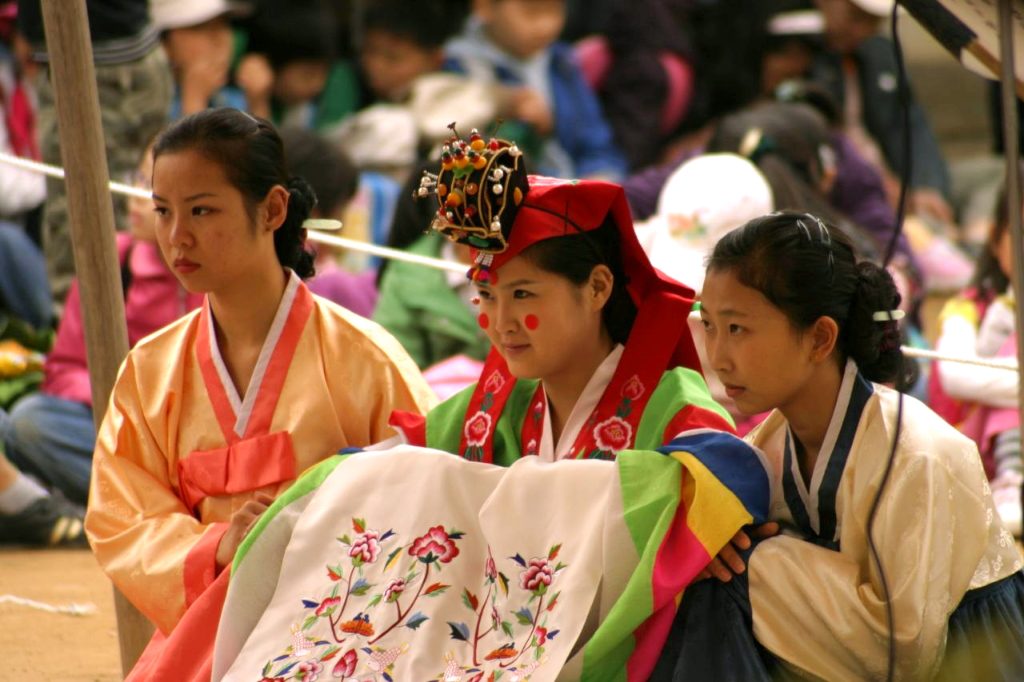
Among the artistic and technical accomplishments of Goryeo was the creation of a sublime style of ceramic known as “Goryeo celadon.” The greenish-blue hue of the glaze was especially coveted by Song dynasty Chinese emperors (who also enjoyed Chinese celadons). Unfortunately, the formula for the hue was lost in the Mongol invasions and never recovered, despite attempts that continue today.

Printing technology also advanced during the era. During the Mongol invasion the wooden printing blocks used to print the Buddhist scriptures were burned. As a result, the monks on Ganghwa Island re-carved them—all 80,000—and carried them on their heads into the southern mountains. The blocks (known as the Tripitaka Koreana, or “Palman Daejanggyeong”) are still housed today in the Haeinsa Temple on Mt. Gaya.
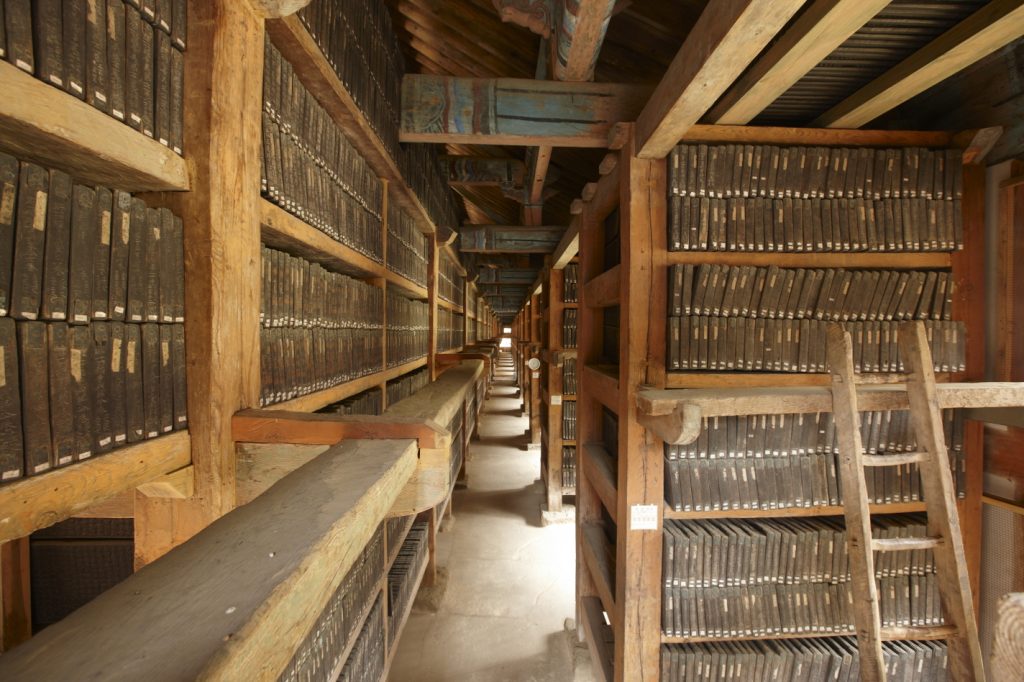 |
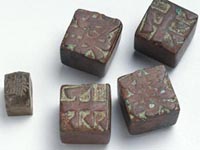 |
Another result of the burning of the Buddhist printing blocks was the invention of moveable metal type. Although both the Chinese and Koreans had been experimenting with printing for centuries, and moveable ceramic type was in limited use, the Koreans developed moveable cast bronze type as another way to try and preserve the scriptures. Thereafter, both metal type and woodblock printing techniques were used down to modern times, when they were largely displaced by Western moveable type in the early 20th century. Despite advances in printing, brush writing was still the most common form of written communication at the individual level. One of the most popular literary forms was a style of lyric poetry, sometimes used for social comment, known as sijo poetry. Popular folk songs were known as changga and were often of a humorous, earthy flavor.
Such poetry would become even more popular in the dynasty that succeeded Goryeo—the Yi or Joseon dynasty that arose during the waning of Mongol power and the rise of the Ming dynasty in China. Powerful families that had supported the Mongols were eventually swept from power and Buddhist hold on the government was ended as a new generation of leadership under General Yi Song-gye established the longest—and last—dynasty in Korean history.
PART 4: THE LAST DYNASTY
Joseon (Yi) Dynasty (1392-1910 CE)
The Joseon, or Yi, dynasty lasted from 1392 until 1910. During the dynasty, relations were established with Ming China; the peninsula was invaded by the Japanese in the late 16th century; and their neighbors the mighty Manchus invaded a few decades later. Western powers threatened Korea by the mid-19th century, while Japan was positioned to take control of Korea by its end, which finally prompted the fall of Joseon in 1910. Thus, the longest dynasty in Korea’s history spans some of the most transitional periods in the recent history of East Asia.
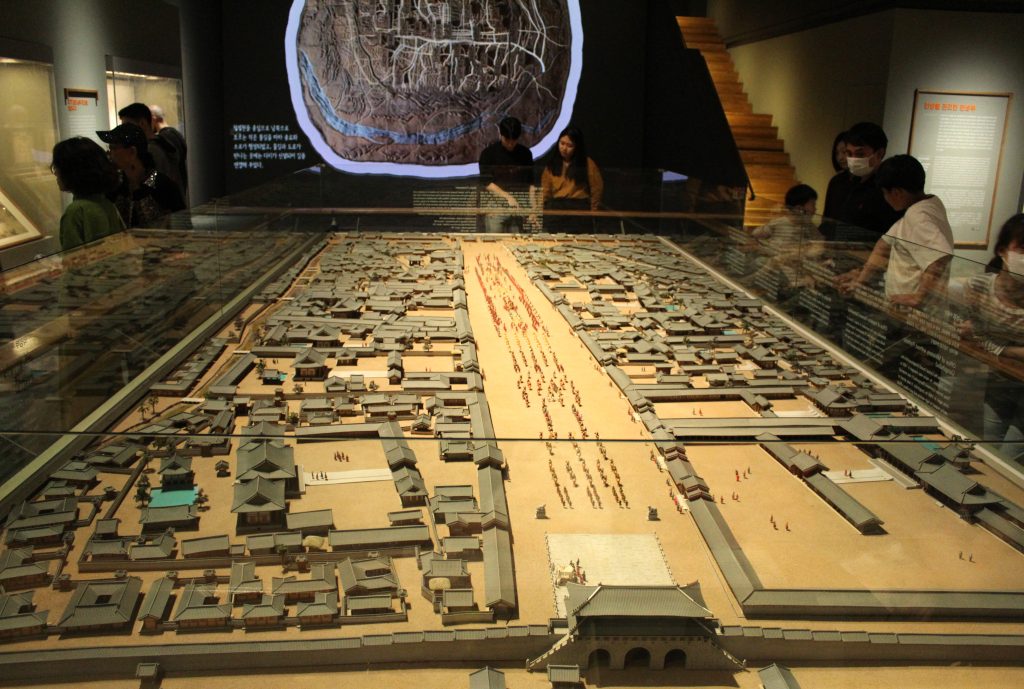


(Top) A model of the central thoroughfare through Seoul as it was during the Joseon dynasty. At the bottom middle of the model, you can see Gwanghwa Gate, the entrance to Gyeongbok Palace, the residence of Joseon kings, which remains to this day (middle). Just inside the gate, you can still observe the changing of the guard, Joseon dynasty style (bottom).
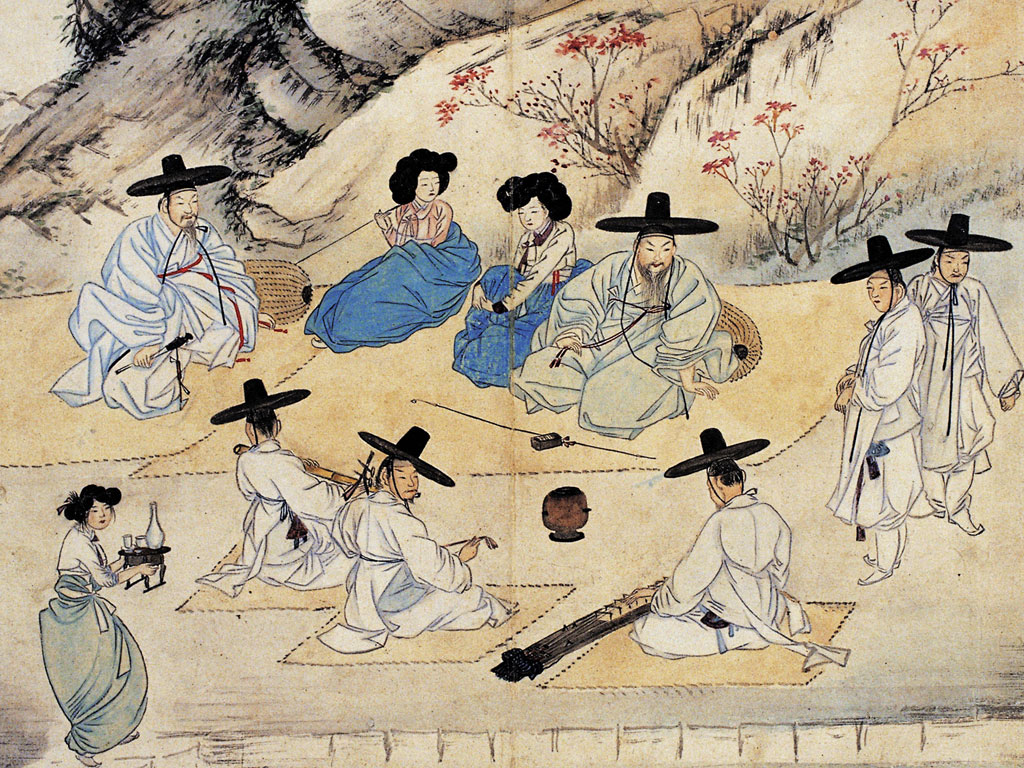
As noted, General Yi Song-gye founded the dynasty which took his name. Yi had made a name for himself fighting Jurched forces in Manchuria and Japanese pirates (wako) on the seas around the peninsula. As Goryeo fell apart under a series of child rulers and shifting alliances among the forces in northeast Asia, Yi took control of the situation on the peninsula and set up the Yi or Joseon dynasty. To secure power he stripped formerly powerful families of landholdings and withdrew government support of Buddhist monasteries. Some sources say it took days to burn the land registers in the streets of the new capital at Seoul. The last Goryeo king was exiled, and faithful officials were purged from the government or even executed.
A strong central bureaucracy was established, building on the Chinese/Goryeo model, but extending government control over the realm even farther. New officials were appointed from among Yi’s followers and land redivided. Large numbers of civil officials and military, appointed through a rigorous series of civil service or military examinations, came to fill the ranks of the yangban. As time went on, the civil service yangban became a leisured class with elite tastes whose members excelled in the arts of painting, calligraphy, and writing classical Chinese and the more vernacular sijo poetry. As the power of the Buddhist organizations was weakened, Confucianism was promoted and elaborated under the tenets of Neo-Confucianism. In the early decades of Joseon, reforms in agricultural and economic reforms were carried out, printing with metal type increased (including texts exported to Japan), paper money was issued, and schools and academies prospered. Books were published on Neo-Confucianism, literature, agriculture, technology, and medicine. In terms of social control, one ruler even instituted the use of identity tags (made of ivory, antler, or wood, depending on class) to keep track of all males for tax and other purposes.
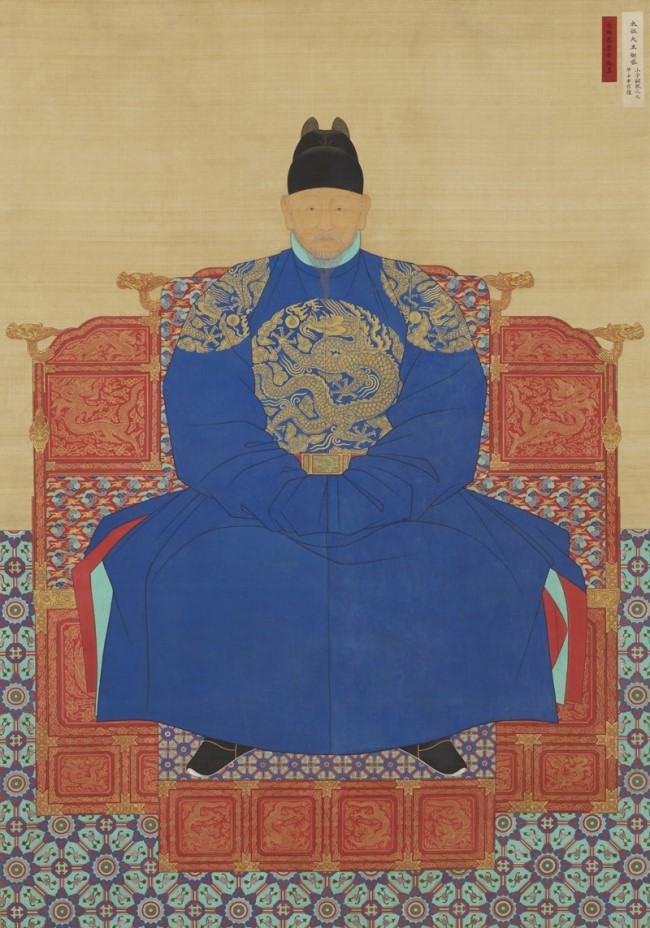 |
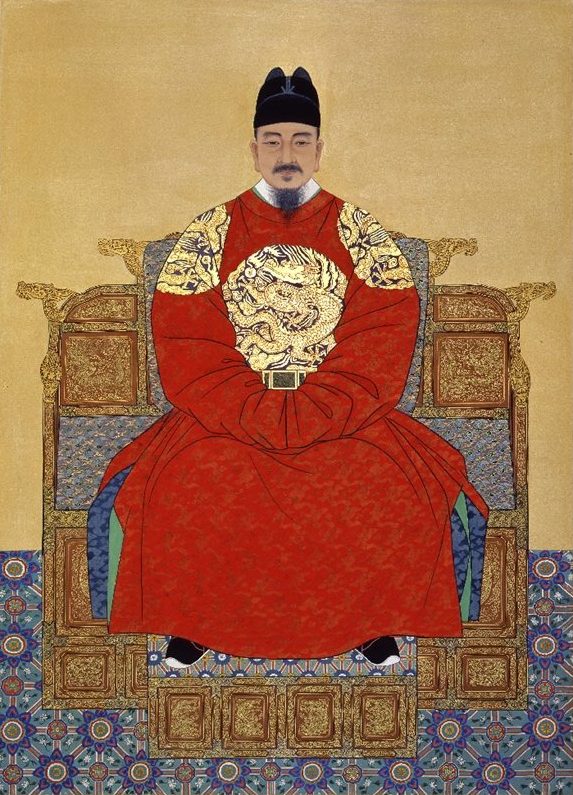 |


The vibrant new dynasty produced outstanding rulers and scholars. Among them was the almost incomparable King Sejong, the fourth Joseon monarch who reigned from 1418-1450. Known as a model king, Sejong surrounded himself with the finest scholars of the day and commissioned important research projects in astronomy, geography, firearms and metals technology, irrigation and other areas. Probably the most enduring project was the creation of the Hangul syllabary. Often regarded as the most scientific syllabary ever invented, the shapes of the symbols are based on abstract representations of the mouth and tongue when pronouncing the various basic sounds. Although Korean scholars continued to use written Chinese characters down into the early 20th century, Hangul became popular among merchants, women, and authors of popular fiction, as it was easy for people to learn. Many translations of Chinese Confucian and Buddhist classics were made into the new system of writing.
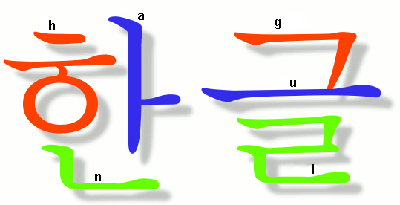
Neo-Confucianism, developed by the Song philosopher Zhu Xi, became popular in the Joseon period. Of great interest was the relation between moral principles (“I” in Korean, “li” in Chinese) and the vital life force known as qi in Chinese and gi in Korean. The most famous Korean exponent of living in accord with innate moral principles was Yi Hwang (1501-1570), also known by his literary name, Toegye. Leaving a lower official position in the capital, he set up a small academy called Dosan Seowon (Peach Mountain Academy) in the Andong region of the southeast. Scholars and students came to the academy to study with Yi Hwang, who welcomed even the local children. On a low veranda surrounded by various plants and a small pool, Yi Hwang spoke with the children about the moral qualities of the cultivation of gyeong—one’s basic honest nature. Using examples of plants such as pine, bamboo, and lotus, Yi Hwang explained how proper cultivation of gyeong would show in one’s actions and how one can rise above one’s situation like a lotus arising from the mud of a pond. As part of his daily regimen, Yi Hwang practiced throwing arrows into the thin neck of a bottle, an activity immortalized on the South Korean 1,000 won bill that depicts Yi Hwang and the arrow bottle.
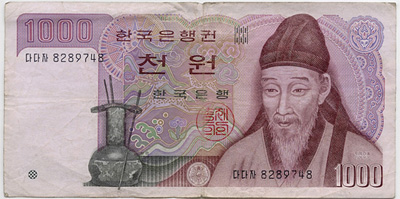
Besides the growth of a refined elite culture, the folk culture of the urban lower classes and peasantry was rich—and often humorous and earthy. Local bands of percussion, wind, and string instruments accompanied farmers as they planted rice and provided music at festivals, weddings, and other events. In recent years, this so-called “farmer’s music” (nongak) has been the basis for a revival of folk music, including the well-known percussion group, Samul nori.
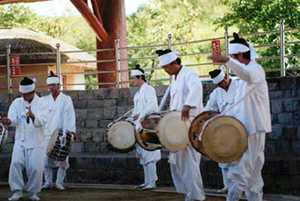
Masked dance dramas have a long history in East Asia and the Korean form is known as talchum. In the Joseon dynasty such dramas were often associated with festivals celebrated according to the Lunar calendar, especially during slack times in the agricultural cycle. In the Andong region, village performances began with a young actor dressed as the village goddess standing on the shoulders of another actor. She would be carried around the performance space as part of a village protection rite, which was the dual function of many performances that were held as much to entertain the gods and thus gain their favor as they were to entertain the local audiences.

By the last half of the dynasty, a type of performance art that was a form of storytelling that combined singing and speaking became popular. This “one-man opera” (pansori) featured a single storyteller who would unroll a grass mat as a performance space and, holding a folding fan, would entertain audiences with long stories. The musical parts were accompanied by an assistant playing an hourglass drum (changgo). The most famous of these stories were about filial young women beset with barriers and indignities in a hierarchical Neo-Confucian society that placed many strictures on the behavior of women. These stories included the “Story of Chunhyang” and the “Story of Simcheong.” See Module 7 for more on traditional Korean performance.

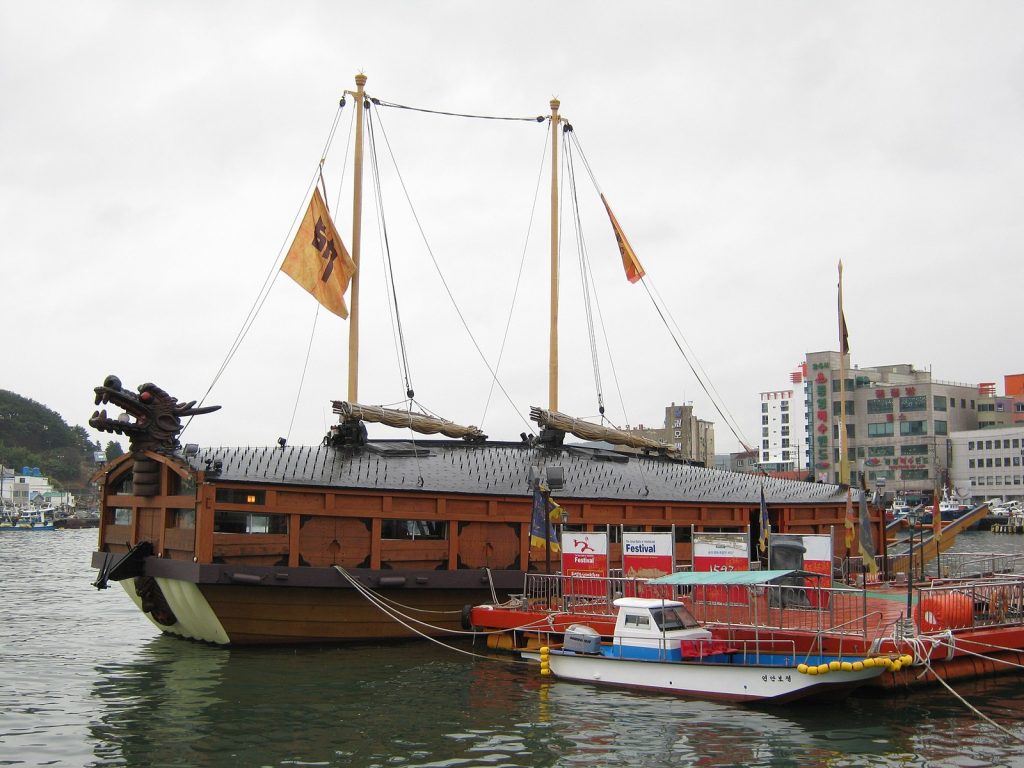
By the end of the 16th century, various internal and external situations precipitated a series of devastating invasions from which the Yi dynasty never really recovered. As royal leadership declined, struggles for power on the islands of Japan spilled over onto the Korean peninsula in a series of invasions launched by the warlord Hideyoshi. Despite fierce resistance from government troops and peasant militias as well as aid from the Ming dynasty many parts of the peninsula were sacked by Japanese troops that arrived by sea with firearms and cannon. Although the Koreans had used gunpowder since the Mongol era, a particularly galling experience was having captured Korean cannons used as cannonballs and shot back into Korean fortifications by larger-bored Japanese guns. One bright point in the invasions was the armada of turtle boats commanded by Admiral Yi Sunsin. Yi had invented a sort of armored ship holding many cannons that for a time deferred the Japanese forces. In the long run the Koreans held on as the Japanese became embroiled in internal clashes leading to the founding of the Tokugawa shogunate.

The Joseon dynasty barely had time to recover from Hideyoshi’s incursions, when scarcely thirty years later new invaders appeared on the northern borders in the form of the Manchus, who were establishing their empire under the leadership of Nurhaci and Abadi. As the Ming fell and the Manchu Qing dynasty arose, Korea found itself allied as a tribute state to the Manchus after a series of devastating invasions that were fiercely resisted, or aided, depending on what side of the internal struggles the forces were on. A certain number of Korean rebels joined the Manchus, forming a Korean banner.
Korean leadership never returned to its earlier days of glory. By the time Western forces (French, English, American, and Russian) began sending missions up Korean rivers to force the so-called “hermit kingdom” to open its doors in the latter 19th century, the most powerful ruler was Queen Min, regent to a weak young king. Queen Min played a role like that of the Empress Dowager Ci Xi, whose rule overlapped with hers for a few years. The Queen was killed by Japanese-backed assassins in 1895 as Japan maneuvered to take Korea as a colony. The Manchus vainly attempted to hold the situation together. (The future president of the Republic of China, Yuan Shikai, was for a time the field marshal in Korea.)
Inner turmoil and rebellion ignited with the rise of an anti-foreign group called the Donghaks, who attempted to use “Eastern Learning” (aspects of the Three Teachings, described in Module 3), to resist the challenge of the West. Although its leader, Choe Je-u, was executed, social instability continued as did the decline in leadership. By 1910 Japan ruled Korea as a colony, with the quiet acquiescence of the British and American governments who formed a secret pact with Japan to protect their own holdings in Asia.
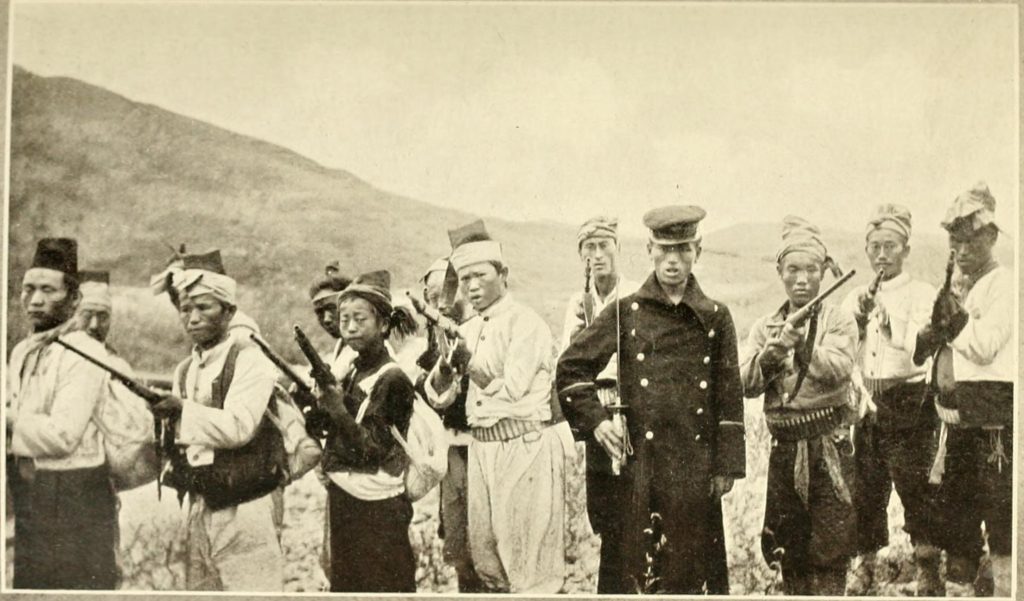
PART 5: KOREAN HISTORY 1910 – PRESENT
1910-1945: The dark days
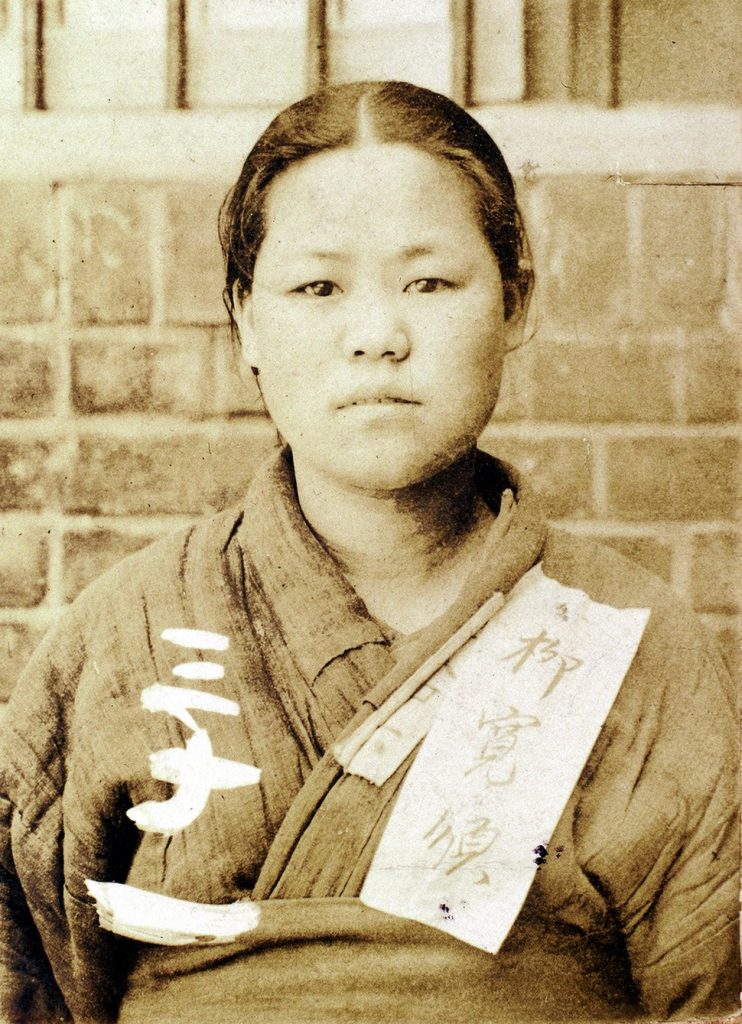
The period between 1910 and 1945 is considered the darkest days in modern Korean history. Under the control of the imperialist empire of Japan, Korea was stripped of its natural resources (thankfully many forests have recovered in recent years). Its language, media, and customs were suppressed—at one time the attempt was made to force the Korean populace to take Japanese surnames. Resistance began in early 1919. Students and workers took to the streets in nationwide demonstrations similar to those that later began the May Fourth Movement in China. The protests were put down with violence. Among the young patriots of the day was a 16-year-old martyr named Yu Gwansun, who was tortured to death in prison. She is remembered as a Korean “Joan of Arc.”

A provisional government was set up in Shanghai, China during the 1930s under the leadership of Kim Gu. Meanwhile, General Kim Il Sung led communist resistance fighters in raids against the Japanese in the northern part of the peninsula.
Post WWII Era: Two Different Roads
Soon after the end of the Japanese empire in the summer of 1945, Korea’s fate was decided at a meeting in the eastern United States at which no Koreans were present. During this short meeting a line dividing North and South Korea was marked along the 38th parallel. The line divided the spheres of influence of the American-led Allied forces and the forces of the Soviet Union, which had been poised in Siberia in hopes of taking the Japanese surrender in East Asia. As relations between the two sides worsened, governments in the communist North and republican South failed to reach accords over united rule. The situation deteriorated further when the Soviet Union suddenly withdrew support from the North.
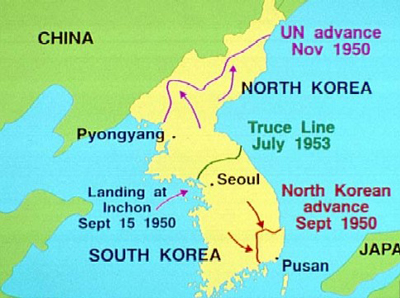
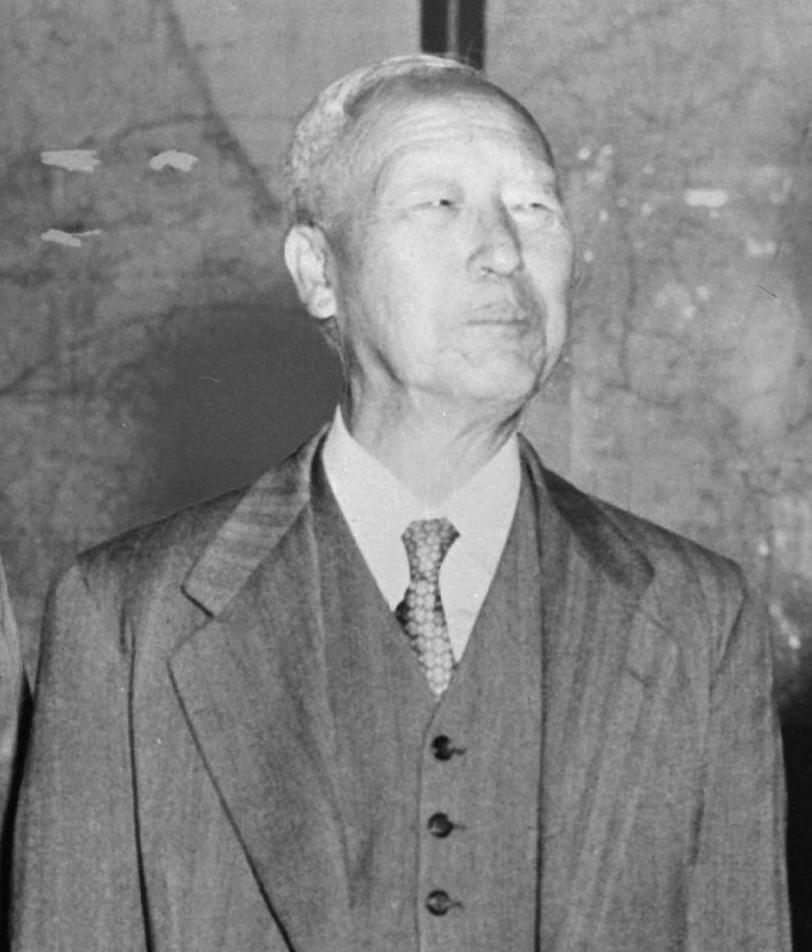
In 1950, the North launched a surprise attack deep into Southern territory, pushing to the tip of the peninsula and surrounding the coastal city of Busan (Pusan). The United Nations, led by United States forces stationed in Japan, launched a counterattack with the South Korean military and pushed the communists nearly to the Chinese border. Having just established rule in 1949, the Chinese communists were alarmed by threats of nuclear war made by United States General Douglas MacArthur, who was soon recalled from the conflict. In response, the Chinese poured 250,000 troops across its border into North Korea in the space of only a few nights. After heavy fighting in freezing weather, UN forces were pushed south again, below the 38th parallel. By 1953, a ceasefire truce was called, one that remains in effect today.
As time passed, the economy of North Korea improved quite rapidly under Kim Il-sung’s “self-reliance” or ju-che policy. South Korea, under the US-backed Syngman Rhee, who had been a leader of the provisional government in Shanghai, gave way to a series of military dictators. The South Korean economy lagged behind that of North Korea until the late 1960s, when its economy began to improve under the iron fist of Park Chung Hee, who believed that economic growth comes first, then democracy. Growth was linked with strong government support for a handful of “super companies,” conglomerates like Samsung, Daewoo, LG, and Hyundai, that are known as chaebol.




As the South Korean economy improved throughout the 1970s and 1980s, when it was in fact the fastest-growing economy on earth, cries for long-postponed democracy arose from the people. With one of the highest literacy rates in the world, the economically well-off and educated middle class of South Korean helped fuel these demands. Thousands of university students became involved in protracted protests and struggles, some which were put down with violence. By the late 1980s, the military government was replaced by democratically elected leaders. Although corruption has plagued the new Korean politics, the voting rate is high and the public enthusiastically participates in election and issues-related politics.
As the Republic of Korea in the south blossomed during the 1980s and early 1990s, the Democratic People’s Republic of Korea in the north stagnated and turned even more inward. Economic hardship descended on the country with the collapse of the Soviet Union in 1989 and the withdrawal of the economic support that had resumed from that country after the Korean War. The “Great Leader” Kim Il Sung passed away in 1994, ushering in a three-year period of mourning. His son, Kim Jung Il took command and led the country from 1994 until 2011, the year of his own death. During this period of time the country faced periods of economic stagnation and famine and faced persistent international concern over its human rights record. Kim Jung Il was succeeded by his son Kim Jong Un, who assumed power in his mid-20s and rules the country today.
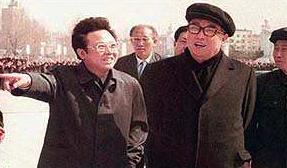 |
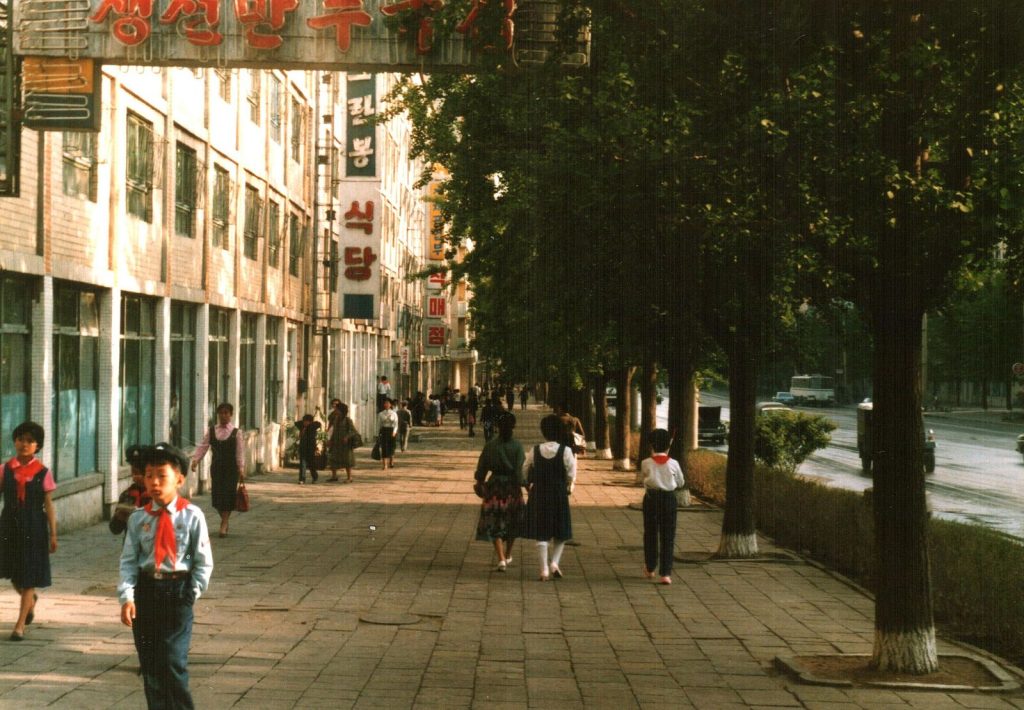 |
In recent decades concerns over nuclear capability and human rights abuses in North Korea continue to strain relationships in northern East Asia and beyond. South Korea, China, Japan, Russia, and the United States are all involved in varying degrees in this regional power equation. China is a key player in problems on the Korean peninsula, as the country has retained ties with North Korea and has established new ties with the South, and many hope that it might eventually serve as a model for North Korean economic liberalization. By 2002 several special economic zones (SEZ) similar to the experimental capitalist zones created in China in the early 1980s, were established in North Korea in places like Sinuiju and Kaesong. Though North Korea’s young leader President Kim Jong Un briefly welcomed US President Donald Trump across the border in 2019, North Korea remains the most isolated nation on earth, leaving questions on an eventual reunification of the two states unanswered.

South Korea continues to project its soft power through multimedia and a powerhouse popular culture industry, or “Korean Wave” that has seen Korean Pop Music, or K-Pop, attracting fans and setting trends throughout East Asian and worldwide since the 1980s. It also continues to attract international attention to its internal politics—such as the scandals surrounding the first female president Park Gyeun-hye (served 2013-2017) and to its leading-edge experiments with cloning and the development of artificial intelligence.


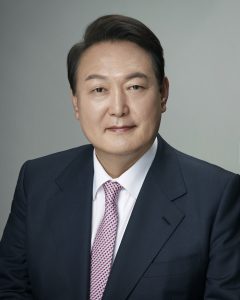
Selected Sources:
Hwang, Kyung Moon (2017). A History of Korea: An Episodic Narrative. New York: Palgrave, Macmillin Essential Histories.
Henthorn, William E. (1971). A History of Korea. New York: Free Press.
JAPANESE HISTORY
PART 1: OVERVIEW

This section is an overview of Japanese history, from the earliest times to the present. Unlike China and Korea, the borders of Japan have stayed relatively stable throughout most of its history due to its geographic status as a group of islands. Until the mid-20th century, historic Japan was never occupied by another people and in turn never held territorial possessions on the mainland or major islands nearby until the late 19th century—though attempts were made at colonizing the Korean peninsula in the late 16th century. From the late 19th century until 1945, the imperial Japanese government had colonies in Taiwan, Korea, Northeast China and, during WWII, it added major parts of Southeast Asia. Since 1945, Japan has remained in its traditional territory, though a few islands are still held in dispute with various states in the region.
The Japanese people of today seem to have had ancestors that came from several places. Although in antiquity the mountainous islands were once connected to the mainland, after the last Ice Age the waters rose, isolating the island group. Whatever the origins of the earliest inhabitants were, some groups may have come from nearby Siberia, the Korean peninsula, the Yellow River and Yangzi River areas of present-day China and the southern chain of islands that lead down into Polynesia. By at least 300 BCE, significant populations with advanced metal technology, rice agriculture, and horses began arriving from the Korean peninsula, and the dates of such migrations may yet be pushed back farther.
As culture developed in Japan, there were several periods when the archaeological and historical evidence points to the rapid introduction of cultural elements from other places. These cultural borrowings were subsequently “remade” in Japan to fit local needs and tastes. In some periods, cultural borrowing proceeded in a systematic matter, with definite goals in mind. This process of controlled selection and adaptation was enhanced by the island nature of the country. The Age of Reform (552-710 CE), the Meiji Period (1868-1912), and the decades right after WWII are three prominent examples. In studying modern Japanese culture, it is still possible to see “layers” of these influences from the past. At various times in history, the major sources of these influences have been states on the Korean peninsula, Silk Road cultures, China, Europe, and the United States. After periods of intense borrowing, Japan has often withdrawn into itself and the foreign cultural influences have become Japanese, sometimes taking new and creative directions. A good example would be certain styles of Japanese art and architecture that were once based on Chinese models.
It is interesting to note that in some instances the results of borrowing and remaking were wildly successful—the modern automobile industry, for example. Other experiments in cultural borrowings took unexpected turns. A good example of this is the attempt to introduce the Chinese style of imperial government starting in the 7th century CE. Although certain codes and reforms were established over several centuries, the grand experiment of a Confucian style bureaucracy began to deteriorate by the 10th century. This was due to the monopolization of court politics by the powerful Fujiwara family. This style of government was then largely abandoned by the late 12th century, when a form of Japanese feudalism arose. In this new system, the emperor became a divine figurehead, while real power lay in the hands of the paramount military leader known as the shogun. This era gave way to a culture of warrior-aesthetes, quite distinct from the clearer separation between civil and military cultures in the Chinese state.
Today, Japan is a super-modern and developed country that is still able to hold onto selected vestiges of its rich cultural heritage. Tokyo and Osaka are highly cosmopolitan cities that feature cultural elements from all over the globe. At the same time, a “Japanese” aesthetic prevails as past and present cultural influences continue to interweave in one of the most powerful engines of popular culture on earth.
PART 2: PREHISTORY
Jomon c. 8,000-300 BCE
The evidence of chipped stone tools suggests that humans inhabited Japan at least 30,000 years ago. “Neolithic” cultures called “Jomon” still retained stone tool and pottery traits of earlier periods that date to at least 10,000 BCE. The Jomon people were hunters and gatherers who lived upon the rich resources of game, fish, and wild plants native to post Ice Age Japan. “Jomon” means “cord-marked pottery,” one of the defining examples of material culture that survive from this people. Jomon pottery is also some of the oldest reliably dated on earth. By 8,000 BCE this type of cord-wrapped pottery—with decorated lines made by wrapping or laying cords on wet clay—was developed. Other clay objects are dogu figurines. These are small human-like figurines that may have been used in fertility worship. Another theory is that they were used as talismans in shamanistic practice to ward off illness. Always few in number, the Jomon peoples were first concentrated on the southern island of Kyushu before moving to the Kansai and Kanto plain areas of the main island of Honshu.
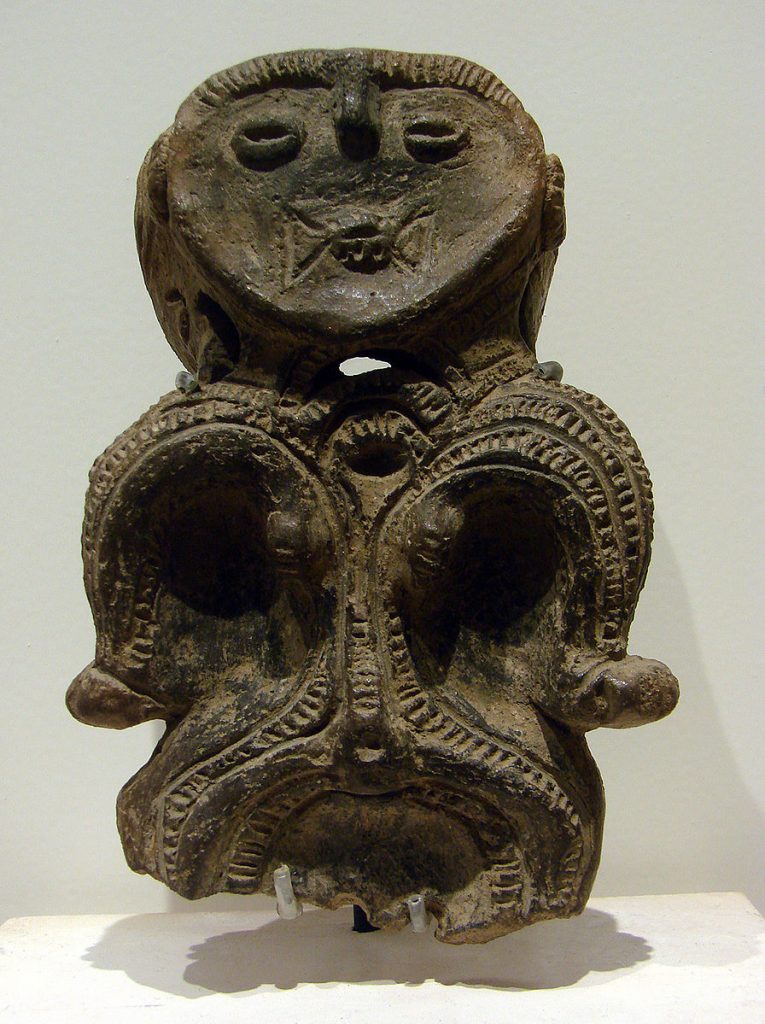 |
 |
Yaoyoi Period c. 300 BCE – 300 CE
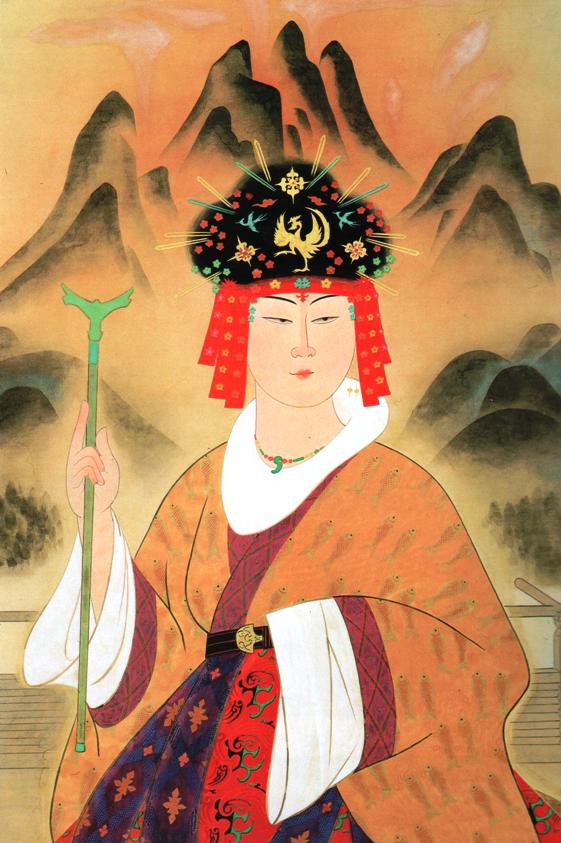
Japan first appears in the historical records of China in about 300 BCE. In those records the inhabitants of Japan were known as the “Wa.” The records tell of a Queen named Pimiko (Himiko) who had a tribal domain in the southwest areas of Honshu and Kyushu. According to the accounts she lived in a hill-top fortress and was waited upon by 1,000 young women. Her brother handled communications outside the walls, acting as a sort of regent. The queen may have had a dual role as a type of shaman with links to the spirit world. It is not known if she was related to the gods. Eventually, Japanese emperors would trace descent directly to the Sun Goddess, Amaterasu, who along with her misbehaving brother Susanoo, was instrumental in the creation story of Japan.
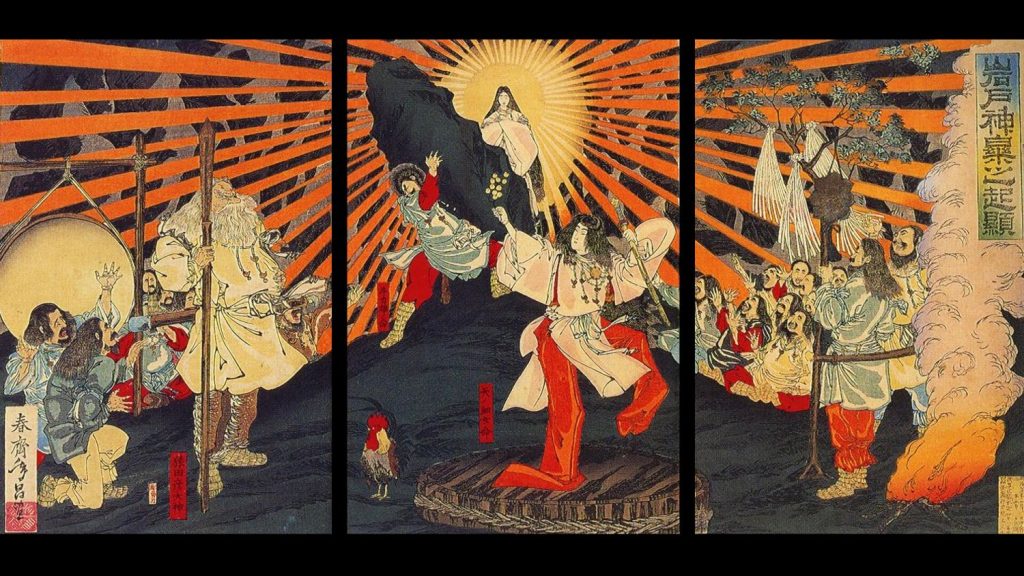
During the Yayoi period a number of new technological and agricultural elements arrived from the Asian mainland, most probably by boat from the Korean peninsula. Among the new arrivals were wet-rice agriculture, bronze and iron technology, new styles of pottery, livestock, and a host of cultural patterns related to village and elite life. Most likely these elements of culture were carried to Japan by waves of immigrants who settled around the land, gradually displacing or absorbing the earlier native populations. It is unclear how the aboriginal Ainu fit into the picture of these early periods of Japan, but warfare with displaced tribes continued for centuries.

PART 3: EARLY KINGDOMS AND CLASSICAL AGE
Tomb Period c. 300-552 CE
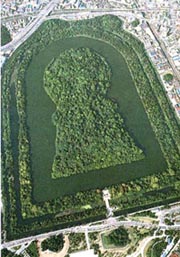
By the Tomb Period population centers had grown up in several parts of the islands and the roots of city culture had taken place. Contact with cultures in China and especially the Korean peninsula continued. Except for the northern wilderness of Hokkaido and parts of southern Kyushu, clans known as uji controlled many portions of the islands.
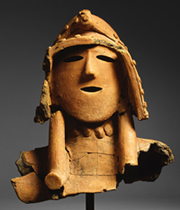
Chinese records from the latter part of the era tell of a powerful uji family known as the Yamato, who were located on the plain between the present cities of Nara and Osaka. By this time a stratified society had developed consisting of rulers, craftspeople, farmers, and even some slaves. The Yamato were only one of many tribal units, which, according to Chinese records, fought incessantly among one another. The Yamato had relations with China and with several states on the Korean peninsula. The present emperor of Japan traces his descent to the Yamato ruling family.
The Yamato Plain region is the site of the oldest tomb mounds in Japan. These tomb mounds (kofun) are in some ways like earlier ones found in China and those on the Korean peninsula from around the same time period. There are some huge mounds in the shape of an old-fashioned keyhole and many smaller ones that are hemispherical in shape.
A style of clay sculpture known as haniwa is associated with some of the grave mounds. The haniwa are earthenware pottery made of hollow tubes of clay. The subjects are abstracted humans of various occupations, farm animals, houses, boats, and other items. In ways they are similar in spirit to the clay items placed in graves during Han dynasty China. Sometimes the inside of the larger tombs was decorated with murals, as also seen in early China and Korea. By the 5th century, models of horses and bronze horse tack appear among these artifacts, along with more sophisticated metal swords, bows and arrow, and spears.
Age of Reform 552-710 CE

Influences from China and other mainland civilizations on the Silk Road made their way into Japan via people moving to and from on the waters of the Tsushima Straits between Japan and Korea and the greater Yellow Sea interaction sphere. By 607 CE a ruler in Japan by the name of Prince Shotoku (574-622) sent a mission of monks, government representatives, and students on a prolonged “study abroad program” to China in order to increase the rate at which positive aspects of Chinese culture were imported. Among the imports were literacy in Chinese (Shotoku had a Korean scribe to help with this task), Buddhism, art, customs, and principles of Chinese rule. The gifted prince, regent for his mother, the Empress Suiko, commissioned a temple complex at present day Horyuji. He also drafted Japan’s first written government constitution, the 17-Article Constitution.
As time went on, over six missions were sent to China, and reforms based upon their findings were instituted in Japan, first in the Yamato court, then elsewhere. In 645 CE, a reformer named Fujiwara no Kamatari (614-669) extended the implementation of the Chinese model of government by canonizing a set of legal reforms known as the Taika Reforms. Later, the Emperor Temmu, who reigned from 672 to 686, introduced more institutional and legal reforms on the model of Tang dynasty China. In a break with the past (and in imitation of the Chinese “son of heaven”), Temmu took the title of “heavenly emperor” (tenno), rather than king. In 702 CE, another set of legal guidelines called the Taiho Code were drawn up to resolve contradictions between government interests in taxation and the landholdings of large uji, who were in constant factional power struggles with the centralized government. Eventually monasteries and large estates gained a special tax-exempt status, and the peasants shouldered the burden of taxation.
During the Age of Reform, the Japanese laid the foundations for an experiment in Chinese-style rule that would bear fruit in an elite culture unrivaled in Japanese history that lasted until the late 12th century. The next two eras, the Nara and Heian, are known as the “classical age” of Japan.

Nara Period 710-794 CE
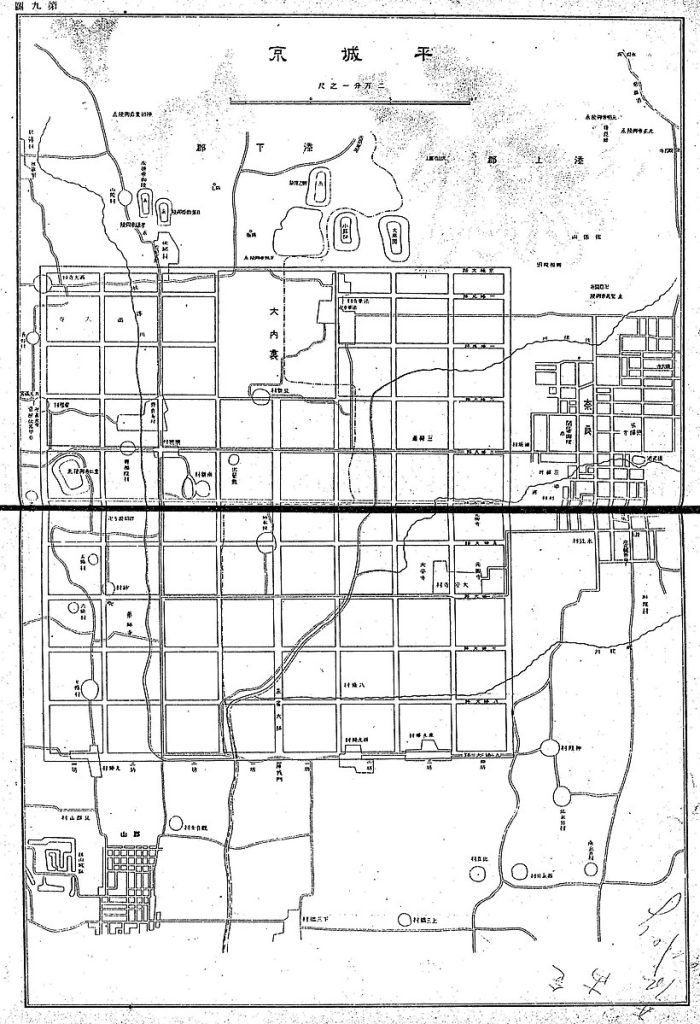
Nara is regarded as the first permanent capital in Japan. Before that time the capital was relocated at the demise of each ruler based on taboos involving pollution of the living site by death. Following the Chinese model of a permanent seat of government, Nara was modeled on the capital of Tang China, Chang’an (today’s Xian).
The city was on a much smaller scale than Chang’an and was not surrounded by a wall. Its earliest part was based on a rectangle of eight squares built on a north-to-south axis with streets running through them in a neat grid pattern. The city was divided into two halves: the Left Capital and the Right Capital. The new palace was placed to the north. A major causeway, called Scarlet Phoenix Avenue, ran down the middle of the city, leading to the palace.
After its establishment in 710 CE, Nara would become a city that is renowned even today for its architecture and tradition of Buddhist art. Although the structures remaining in Nara today were built in later centuries, many are constructed on sites dating to the earliest years of the kingdom. Some of the best descriptions of these early sites come from a huge tourist guidebook compiled by a poet and printed in 1681.
Much of what is known about life in the Nara period centers on the lifestyles of the elite in the capital cities. The use of classical Chinese as a literary language increased throughout the Nara period. While government documents and literature in classical Chinese were produced, this was also the first flowering of native Japanese literature. The most important example of this is the first collection of Japanese poems, known as the Collection of Ten Thousand Leaves, or Manyoshu. Buddhism became an important force in the capital and was patronized by the government. Statues of Buddha were commissioned, 48 temples built within Nara and many more throughout the land, and Buddhist scriptures were mass-produced and spread everywhere. A scandal late in the period involved a powerful Buddhist monk who manipulated a ruling empress and nearly took control of the throne. Although several women had ruled in Japan (usually after the death of their husbands), this custom was ended because of that scandal.

Although the capital city and other upper-class echelons were developed under the influence of imported Chinese culture, the rural villages and farmsteads were much more conservative. Farmers in some areas lived in pit houses partially underground and did wet-rice farming. Dry land fields were still cleared by agricultural techniques that involved burning off brushy and forested areas and planting in the ash-rich soil.
The Nara period was characterized by continued importation of Chinese culture and the spread of Buddhism. In the next period, the Heian period, the Chinese influences would be “remade” with Japanese characteristics, in some cases preserving aspects of Chinese culture that were long out of fashion in China. However, this was also the time when the cultural modes were developed that would influence Japan for the next thousand years.
Heian Period 794-1185 CE
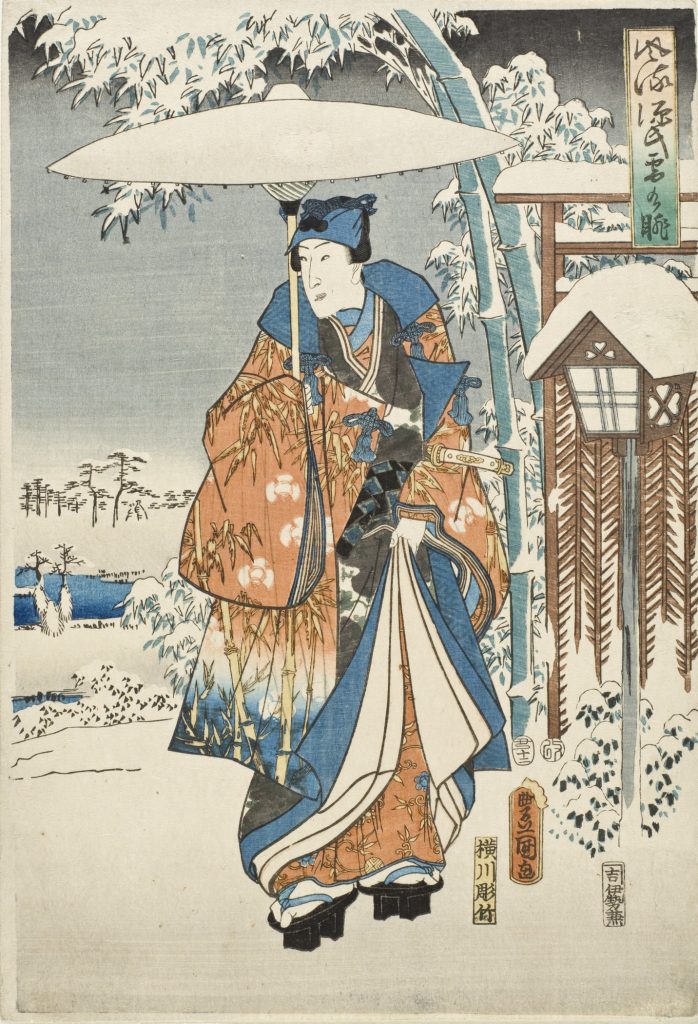
In 794 CE a new capital was founded at Heian, the site of present-day Kyoto. The Heian period would prove to be the height of ancient Japanese classical culture. The samurai of later ages would look back to the Heian period as a source of patterns of elite culture, which they wove into their more militaristic outlook. Again, taking the Tang dynasty capital as a model, the new city was one third of the size of Chang’an and had a low wall. Heian is the age of the “Shining Lord”—the age of Hikaru Genji, the major character in Murasaki Shibuku’s Tale of Genji. Based on accounts of Japanese and Western visitors, the scholar Ivan Morris gives a description of the setting of the capital in this pre-industrialized era:
The capital itself was situated in beautiful country, encircled on three sides by thickly forested hills and mountains, often delicately wreathed with trails of mist; in the autumn evenings one could hear the deer’s cry in the distance and the desolate call of the wild geese overhead; the landscape abounded in streams and waterfalls and lakes; and into its green slopes and valleys the countless shrines and monasteries blended as if they too had become a part of nature. (Morris: p. 34)
Life at the courts became insulated from the rest of the world and the relative peace of most of the era allowed for a flowering of culture. New forms of writing called kana were created that easily reflected the sounds of the Japanese language. Although kana were much easier to learn than classical Chinese, scholars and bureaucrats preferred Chinese and its elite associations, while the new written language was soon used by court women as a new medium for writing prose.
Court women such as Sei Shonagon and Murasaki Shikibu contributed to the creation of a “women’s” literature that rivaled any prose writings in the world of at the time—though it was entirely unknown outside of a tiny audience in Japan. One of the aesthetic principles reflected in the literature of the period was that of miyabi, or “courtly elegance.” The term appears hundreds of times in the Tale of Genji and refers to the gentle, sensitive and often ritualized manners cultivated by the elite of the time. Another important aesthetic element that evolved further with the introduction of Zen Buddhism in later centuries is the concept of mono no aware, or “sensitivity to things.” Enhanced by the natural beauty of Japan, the aesthetic was based on the idea that the heart/soul is stimulated by images of the sublime in nature. Thus, a falling cherry blossom or an autumn leaf circling in a pool creates subtle and indescribable feelings that can only be expressed by poetry or other arts. The Tale of Genji is a long, complicated narrative covering several generations. Often called “the world’s first novel,” Murasaki Shikibu’s work continues to influence Japanese culture to this day. Sei Shonagon’s collection of essays, The Pillow Book (Makura no Soshi ) was another important work. It details the personal and political lives of the most powerful Court figures of the day. The “Collection of Japanese Poems New and Old” (Kokinwakashu) was the most important collection of poetry in the Heian era. It would also influence and inspire Japanese culture for the next thousand years.
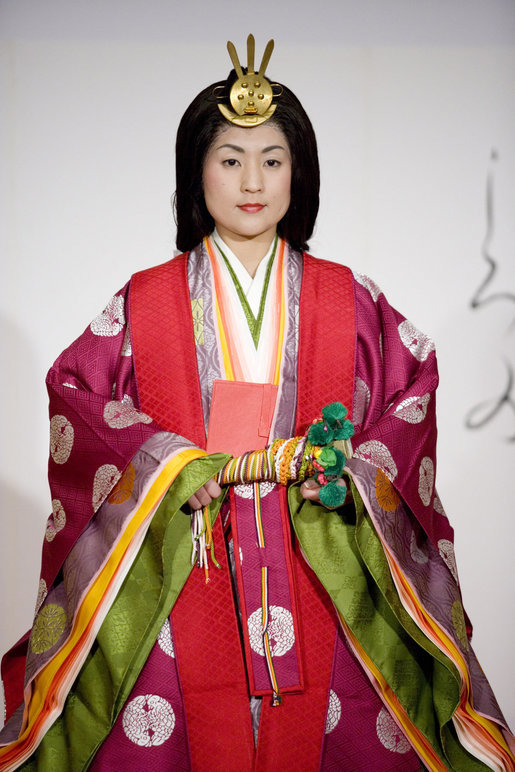
Courtly refinement and aesthetic sensitivity were reflected in the daily dress and manners of the elite. Both men and women’s clothing and adornment were subject to conventions of the day. Women wore an elaborate costume of up to twelve inner and outer layers of cloth. Natural white teeth were colored black with a solution of iron and powdered gallnut soaked in vinegar (temporary teeth blackening remains part of the process of becoming a geisha entertainer in Kyoto today). Hair was decorated with ornaments at the start of the Heian period, but this eventually went out of fashion. Aristocratic women wore their hair as long as possible—even to the ground. White powder was applied to the face and neck and light rouge on the cheeks. Eyebrows were plucked and misty dark blotches were painted high upon the forehead. Lips were painted red like tiny flower buds. Like the standards for Tang dynasty women, Heian women cultivated full figures, although bodies were not displayed in public, but hidden beneath the mounds of cloth. Aristocratic women were also hidden behind an elaborate system of blinds and screens, described at length in the literature of the time.
Elite women were educated in calligraphy, poetry, music, and customs such as incense preparation, which allowed them some intellectual parity with men of their class with similar training. Although most upper-class women spent their days in secluded leisure at home, possibly engaging in embroidery and dyeing cloth, women of the court like Sei Shonagon, had somewhat more public lives. Interactions between the sexes (other than close family members and lovers) were rarely direct. Communication, when necessary, was often through carefully crafted letters delivered by go-betweens or servants. Elite men led much more public lives, involved in politics and the running of their estates. Although the power of Buddhism was not allowed to increase to the point it had in Nara, a new form of Buddhism that offered salvation to all believers was imported from China by a monk named Saicho (767-822 CE). The new Tendai (Tiantai) beliefs soon became widespread among the nobles and the populace. Esoteric Buddhism also gained a strong hold in Japanese culture at this time. The Shingon (“True Word”) sect of esoteric Buddhism was founded by the great monk Kukai (774-835 CE.) One of the great geniuses of Japanese history, Kukai studied for many years in China under famous Buddhist scholars. Kukai’s own teachings and doctrines are some of the most complex and profound in all of Buddhism. Many great temples and monasteries of several sects of Buddhism remain in Kyoto today, as living testaments of the great Buddhist tradition in Japan.
During the Heian period, the experiments with centralized Chinese rule and taxation gradually faded into the situation of a weak central government ruled by an emperor who was increasingly a figurehead. This was due to monopolization of Imperial Court power by the Fujiwara family. A large family with roots in the noble uji of the past, the Fujiwara gained control through marriage politics. Fujiwara daughters became the mothers of emperors. Their maternal grandfather would then act as regent, effectively controlling the central government. The most powerful of these men was Fujiwara no Michinaga (996-1027 CE) Michinaga became the de facto power over all of Japan and the most powerful non-military ruler in Japanese history. However, toward the end of the 12th century the power of the Fujiwara was in decline. Large warrior clan families like the Minamoto, and Taira increased their power and holdings and came into conflict with each other and other families over control of the realm.
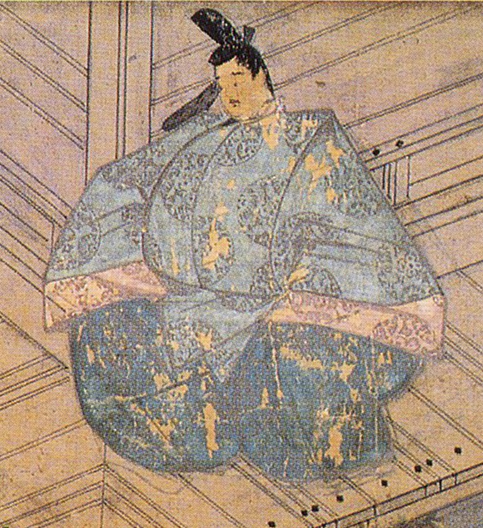
PART 4: FEUDAL ERA IN JAPAN
Kamakura Period 1185-1333 CE
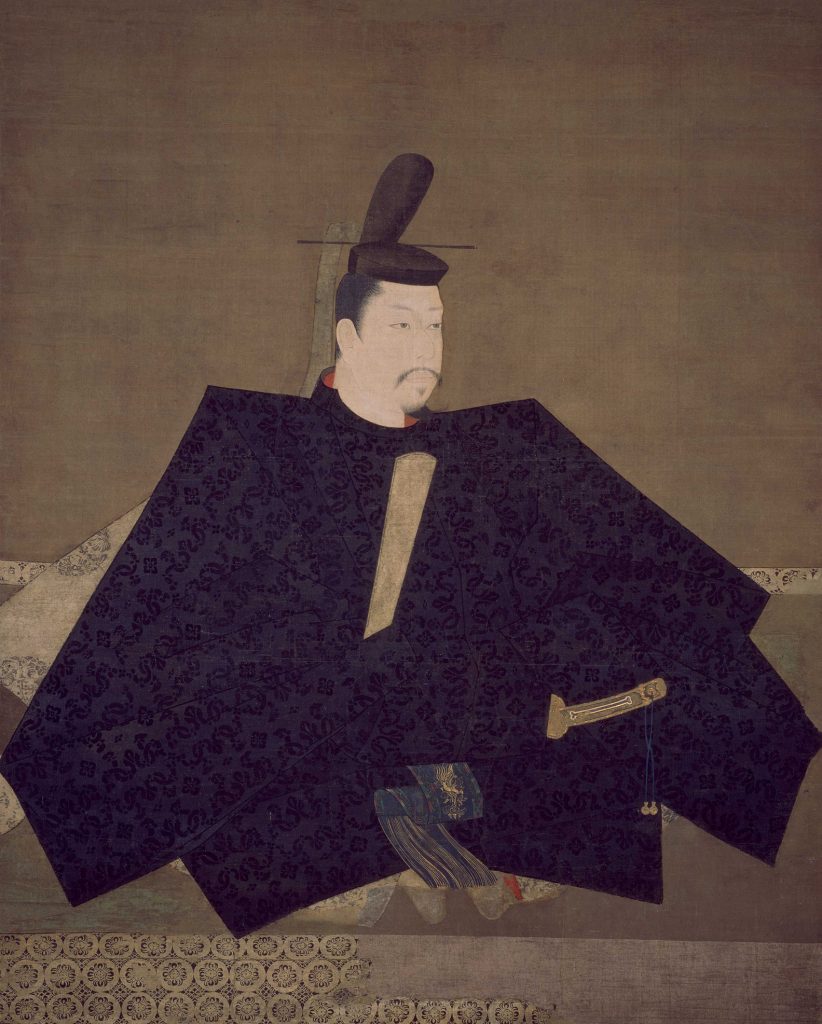
The turmoil of the Kamakura period contrasts sharply with the refined atmosphere associated with the classic age of Heian culture. During this period, attempts were made to rule Japan through a centralized Imperial Chinese model, backed by civil codes, that evolved into a system similar in spirit and substance to feudalism in Europe. In this epoch, the warrior class known as the samurai took the stage, and militancy became the social and political norm. The role of the emperor became almost wholly ceremonial, as the military side of the government, under the leadership of the shogun (the generalissimo of the Imperial Army), took actual control of policy and implementation. By the end of the era, Japan would become an island nation filled with warring armies associated with rival family domains struggling for political and military dominance.

With the power of the Fujiwara in decline, the powerful warrior families of the Minamoto and the Taira fought for control of Japan in the Gempei War of the late 12th century. A new era began with the rise of the first shogun. The winner in the prolonged struggle of the Gempei War, a general named Minamoto Yoritomo (1147-1199 CE) set up a new government in the Kanto plain, quite close to present-day Tokyo. At this moment, real power shifted from the western Kansai region around Heian-kyo (Kyoto) to Yoritomo’s military government at Kamakura. The new government was called bakufu or “tent government,” suggesting a military encampment. Although the emperor continued to exist in Kyoto, and was acknowledged by Yoritomo and succeeding shoguns, from this point on (with one brief exception), the role of the emperor would be minimal until the Meiji Restoration in 1867. Yoritomo simplified government processes and instituted a basic legal code, although the court in Kyoto retained much of its form and administrative function. Large family domains retained varying numbers of samurai—professional military men something like the knights of Europe. Common people tilled the land, much as they had always done. While control of the bakufu shifted to the Hojo family after Yoritomo’s death, the system of government that he established was to be the basic model for control of Japan until the modern era.
The greatest threat to Japanese sovereignty before the great changes of the 19th and 20th centuries came during the Kamakura period with the attempts by the Mongols of Kubilai Khan to invade Japan. Two major attempts came seven years apart in the late 13th century. They were launched from the Korean peninsula. The Mongols commandeered thousands of ships, boats and crews from Korea and China in the invasions. The samurai warriors who still used one-on-one battle tactics based on horseback archery, then swords (once on the ground), put up a stiff resistance against the Mongol forces, but ultimately would have been overmatched by the coordinated military tactics of massed archers, fire-bombs, and siege weapons in the Mongol military arsenal. The Mongols, however, seem to have been no match for the protective kami (local gods) of Japan, who sent ravaging typhoons (the “divine winds” or kamikaze) that twice sunk the Mongol fleets before full-scale invasions could take place. The lingering fear of Mongol attacks only strengthened military culture in Japan, which continued to develop in the ensuing centuries of unrest. While Japan was saved from invasion by the Mongols, the unrest caused by the threat of Mongol invasion weakened the bakufu in Kamakura.


Kemmu Restoration 1333-1336 CE
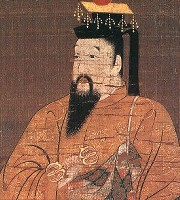
A very short period in Japanese history marked the transition between the Kamakura and Muromachi Periods. This era is known as the Kemmu Restoration and is the last time a Japanese emperor attempted by force to take control of Japan. This occurred in 1333, when Emperor Go-Daigo attempted to re-institute direct imperial rule by amassing forces against the bakufu government of the prevailing shogun. Emperor Go-Daigo sent his troops under the leadership of General Ashikaga Takauji to route the resisting factions. During these actions Go-Daigo gave support to some of Ashikaga’s rivals, which in turn stimulated Ashikaga to turn the tables. Returning to Kyoto, he drove Go-Daigo into the hills, and managed to place a new emperor (from another imperial line) on the throne. Nevertheless, Go-Daigo set up a government in exile in Yoshino, a site in present-day Nara. The division of the Imperial Court in Japan lasted for several decades. This event ushered in an era of almost constant martial strife between the regional domains in Japan, as local lords contested for the position of shogun and the hierarchical feudal system further developed.
Ashikaga Period 1336-1573 CE
Although fate intervened to save Japan from the Mongols, the Mongol invasions brought instability to the emerging Japanese feudal system, which eventually descended into a state of turmoil and incessant fighting between local warlords. No one leader managed to gain firm control over the entire realm at this time. Though Kyoto continued as a grand capital, the bases of military power were scattered throughout the land.
During this period, feudalism developed further. The emperor, dwelling in Kyoto, was the divine leader of the land, though in actuality functioned more as a figurehead who gave legitimacy to the rule of the shogun. The Ashikaga shoguns controlled the area around the city of Kyoto, however the rule did not extend throughout Japan. At this time powerful regional lords calling themselves “daimyo” (meaning “great name”) held large tracts of land. Daimyo were constantly fighting with each other and the Ashikaga government for control of territory. These regional lords all employed armies of samurai, and below them were the townspeople and peasant farmers. The samurai code of service demanded loyalty to lord and one’s family name as well as self-discipline and perfection in the martial arts. Dishonor was the occasion for ritual suicide by sword.
During this period a new literature emerged. Unsurprisingly, it often centered on martial themes. The aesthetic of such works is that of sabi, which reflected a deep melancholy or sadness over the brevity of existence. A related concept is that of wabi, the effect of construed naturalness exhibited in an artwork such as the cracks or irregularities in the glaze on a tea bowl that reflect the effects of primitive firing techniques. These aesthetics are also part of the appreciation of Japanese garden architecture. They were developed in the growing culture of Zen Buddhism, brought to Japan by the monk Eisai (who also introduced the tea ritual) in 1191, that was favored by the warrior class because of its stress on the exacting discipline of the meditation process. Cultivation of these aesthetics, linked with Zen meditation, became an important dimension of the warrior samurai culture in later eras of Japanese history. The Tale of Heike (Heike Monogatari) although it existed in other oral forms before this time, is the best-known of these martial works and epitomizes this era. A samurai might contemplate the beauty of a meadow flower in one instant, and in the next engage in mortal combat (as exemplified in a famous scene in Akira Kurosawa’s celebrated film, Seven Samurai).
Noh theater was also developed at this time. Originally called sarugaku (monkey music), noh is a form of minimalist masked drama that places great importance on dance and chant. The actor-playwright Kannami (1333-1384 CE), followed by his son Zeami (1363-1443 CE) were the two most important figures in the rise of noh. Zeami especially is credited with innovation of the tradition into a highly complex form of drama. Zeami’s aesthetics of noh are now seen as the artistic standards of this era.
Forms of Buddhism, such as the Pure Land (Jodo) and Nichiren sects, that were less austere than Zen were spread throughout the populace.

The time of the Onin Wars (1467-77 CE) was the most bloody and chaotic moment of the period, and destruction was widespread. Kyoto was largely destroyed in the feuds between two great families that spilled into other parts of the realm. The devastating war signaled the beginning of over a hundred years of chaos and strife. Due to a breakdown in what central control there was, social mobility increased between classes and regional overlords competed for soldiers and labor to further their interests. Armies of foot soldiers amassed from the peasantry were now used in warfare. At first armed with spears and pikes, by the end of the era, massed contingents of foot soldiers with firearms were used decisively in battle.
The latter period of the era (1568-1600 CE) is known as the Age of Reunification. During this period the number of local lords decreased, though those remaining in the struggles grew in power. The three great daimyo in the final decades were Oda Nobunaga (1534-82 CE), the commoner Hideyoshi (1536-98 CE), and a somewhat younger leader in Oda Nobunaga’s retinue named Tokugawa Ieyasu (1543-1616 CE). All three men attempted to unify Japan by creating (or forcing) alliances among the powerful daimyo of the land.
Oda Nobunaga was known as a fierce and relentless warrior whose armies were equipped with matchlock firearms that had been introduced by shipwrecked Portuguese sailors around 1543 CE. Oda managed to extend his rule over several of the contending daimyo until his assassination at the hands of a rival whom he light-heartedly struck on the head with a fan at a banquet.

Known as the namban (“southern barbarians”), the Portuguese were later followed by the Spanish. The newcomers had similar goals: trade and conversion of souls to Christianity—an attitude different from the Dutch and British who wanted only trade and plunder. Jesuit priests from Portugal and Spain soon brought Christianity to Japan where it had a mixed reception. Although at one point a following of an estimated two million was gained, unlike Buddhism the new faith demanded forsaking all other beliefs and required allegiance to a foreign and far-away leader in the Vatican. Some Japanese leaders like Oda Nobunaga attempted to use Christianity as a political force (in his case, against the rich Buddhist factions), while others like Tokugawa Ieyasu saw it as a destabilizing force. The new religion was virtually eliminated from Japan in a series of intense purges around 1630 when thousands of leaders and followers were literally crucified. Some aspects of the contradictions between these competing foreign and native forces were included in the plot of James Clavell’s novel Shogun, and the film of the same name.
Hideyoshi was a former peasant and vassal of Oda Nobunaga who managed to consolidate an even greater number of daimyo than his former lord. As part of his bid for control of Japan, he decreed that townspeople were to remain in towns and peasants were to remain in rural areas, lessening mobility between classes. Class divisions were starkly re-emphasized by a great “sword hunt” in which arms were collected from the common people and melted into Buddhist statues. The superior status of the samurai warriors (even lower-level ones) was demonstrated by allowing them to continue wearing two swords in public (one long and one short). As a reflection of the times, it is recorded that Oda Nobunaga hired an African (exact origin unclear) as a retainer in his retinue. Called “Yasuke” in Japanese, he came to Japan in the company of an Italian Jesuit priest on a Portuguese ship. He is thought to have learned Japanese and was one of the earliest Africans in Japan.

To display his power, in the late 1500s Hideyoshi twice sent forces up the Korean peninsula in attempts to conquer the declining Ming dynasty in China which had been constantly pestered by attacks from Japanese pirates. The Japanese fleet was devastated by the armored turtle boats of Korean General Yi Sun-sin and by the huge numbers of Chinese soldiers who were sent across the northern borders of Joseon Korea during the second attack. The mad plans to invade China ended (for the time being) with Hideyoshi’s sudden death in 1598. As the 16th century ended, a great battle between contending daimyo took place at in 1600 CE at Sekigahara on the southwest coast. The forces of the patient and methodological Tokugawa Ieyasu won the day, and he soon unified the regional lords and their realms under a new form of advanced centralized feudal government.
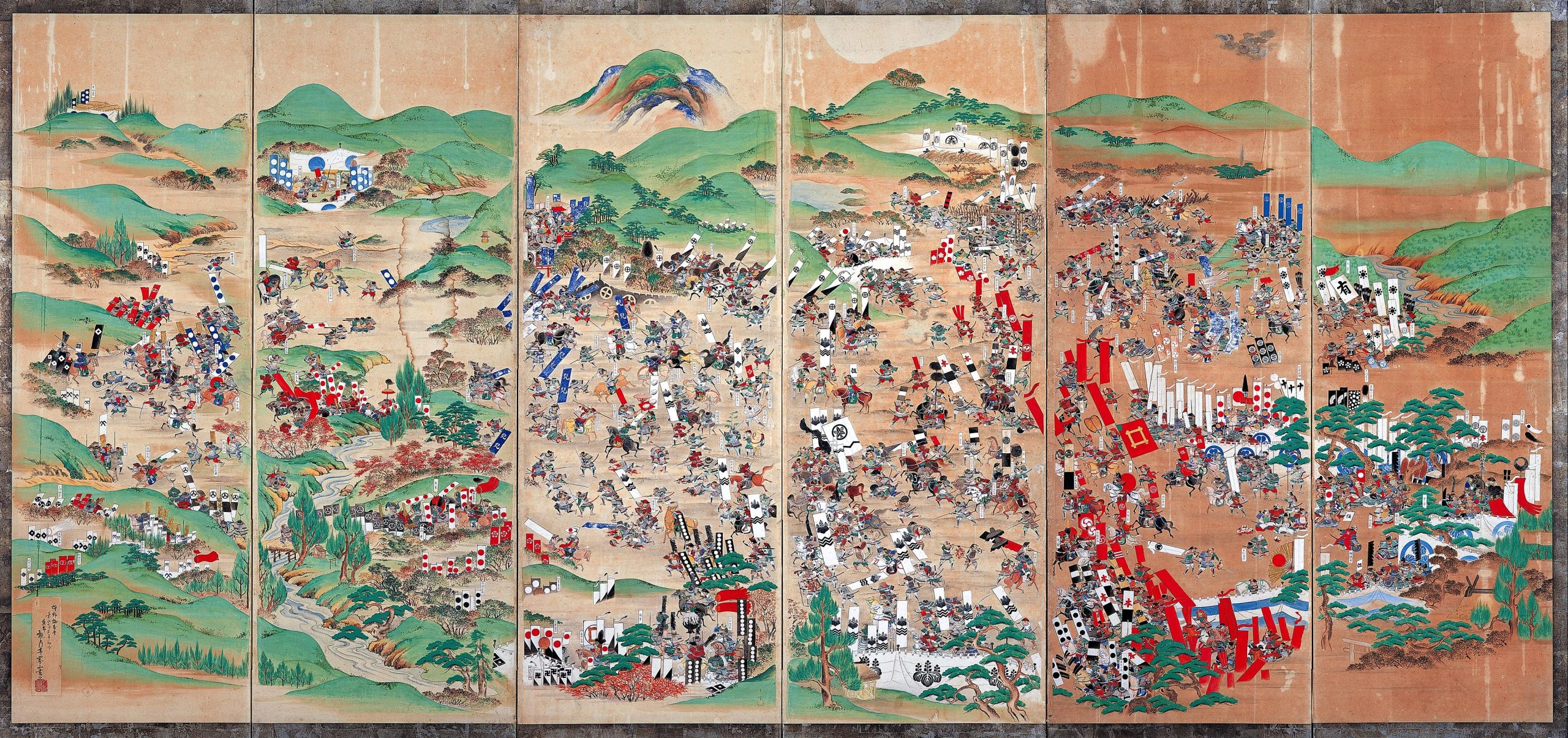
PART 5: TOKUGAWA (EDO) PERIOD 1600-1867 CE

Within a decade after the battle of Sekigahara, Tokugawa Ieyasu had established complete control over Japan. He established his shogunate in Edo, modern-day Tokyo, though the emperor continued to reside in Kyoto. The innovations that the new shogun put in place would eventually create the conditions for Japan’s swift entrance into the modern world in the mid-19th century.
In order to retain control over the realm, Tokugawa Ieyasu created a centralized bureaucracy, utilizing the new doctrine of Neo-Confucianism that was spreading throughout the mainland and including ministries to oversee the administration of the state. He also instituted several policies to control the daimyo, who had been given lands close to the capital (the inner daimyo) or on the fringes (the outer daimyo) in accordance with their allegiance (or lack of) during the wars of unification. These policies included regular service to the realm, the upkeep of local castles and other assets, and visits to the capital every other year. This policy was enforced by requiring the local daimyo to lodge their immediate families in Edo. Thus, there was a constant coming and going of great processions from the realms of the daimyo along the roadways linking parts of the islands. All this travel was good for the economy and service and supply industries arose along the routes to the capital to feed, lodge, and provide necessities such as footwear to the retinues.
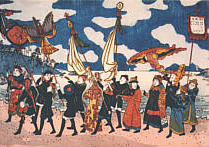
Another policy of control had to do with foreign relations. After the expulsion of foreigners (primarily Portuguese and Spanish) and the anti-Christian campaigns, the government followed a policy of seclusion. The fleets were allowed to fall into disuse (which coincidentally ended the problem of Japanese piracy that had plagued China and Korea) and trade was severely limited. No citizen, under threat of death, was allowed to freely leave Japan. The Dutch were eventually granted trading privileges at Dejima Island near Nagasaki. The knowledge of European advances in science, medicine, and technology brought by them was known as “Dutch learning.” Some trade was still carried on with the Chinese. Although not completely sealed off, for 250 years Japan remained for the most part peacefully cloistered from the rest of the world.
During the long period of peace during the Tokugawa period the position of the samurai gradually changed. Many filled the layers of central and local government. With no wars to fight, martial training became more ritualized and intermixed with revived aesthetics of the Heian period and Zen Buddhism. This is reflected in the samurai tastes for the austere Noh drama, the spartan tea ritual, flower arranging (ikebana), refined incense identification games (something like modern wine tasting), and haiku poetry. Economically, the samurai class, whose members were paid by the great landholders or government in rice, was in decline by the early 19th century.
The merchant class, which had been slowly rising since the end of the Ashikaga period, became economically dominant as a middle class composed of traders, shopkeepers, money-lenders, and transport agents. It arose in cities like Edo and Osaka. Enterprises combining production and distribution run by wealthy merchant families like Mitsui and Mitsubishi were precursors of modern multi-national companies. A strong money economy, (rooted in the Ashikaga period when coinage was imported from China), was supported by banking and lending institutions. Huge entertainment districts featured boisterous kabuki theater, lively bunraku puppet shows (with wooden puppets 2/3 life-size), and comic storytellers, as well as drinking and other diversions. The milieu of this “floating world” of entertainment was reflected in thematic painting and woodblock prints of the age.
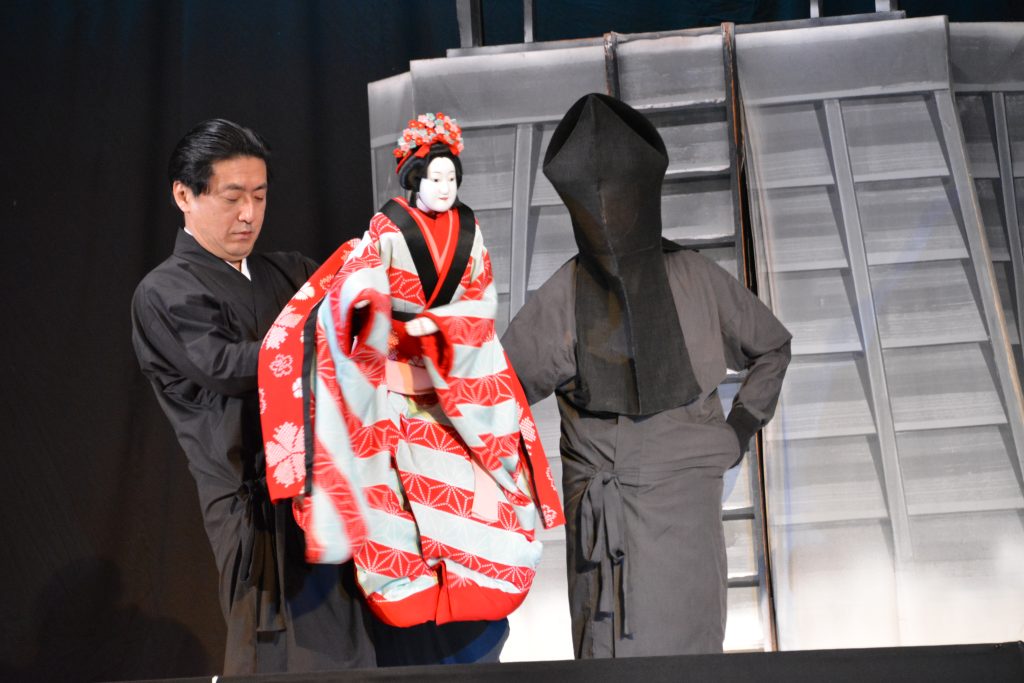 |
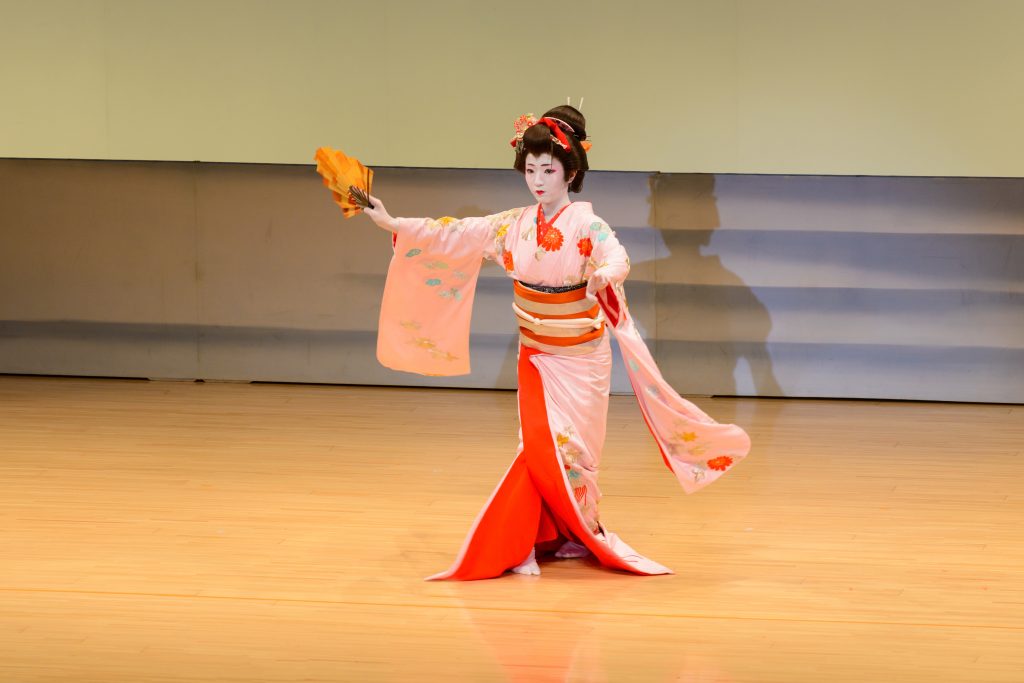 |
Education was also of great importance and the literacy rate in urban Japan was high due in part to government sponsorship of schools and also due to the ubiquity of printing technology, which was aided by earlier Korean advances in the development of moveable metal type. Neo-Confucianism found a following and was promoted by the Tokugawa government which found its secular principles useful in establishing its centralized bureaucracy. Such were the dynamics in a society that would meet its destiny with the industrializing West with the arrival of American gunboats in the mid-19th century.

PART 6: MODERN TO PRESENT JAPAN
Meiji Period 1868-1912CE to Early 21st Century
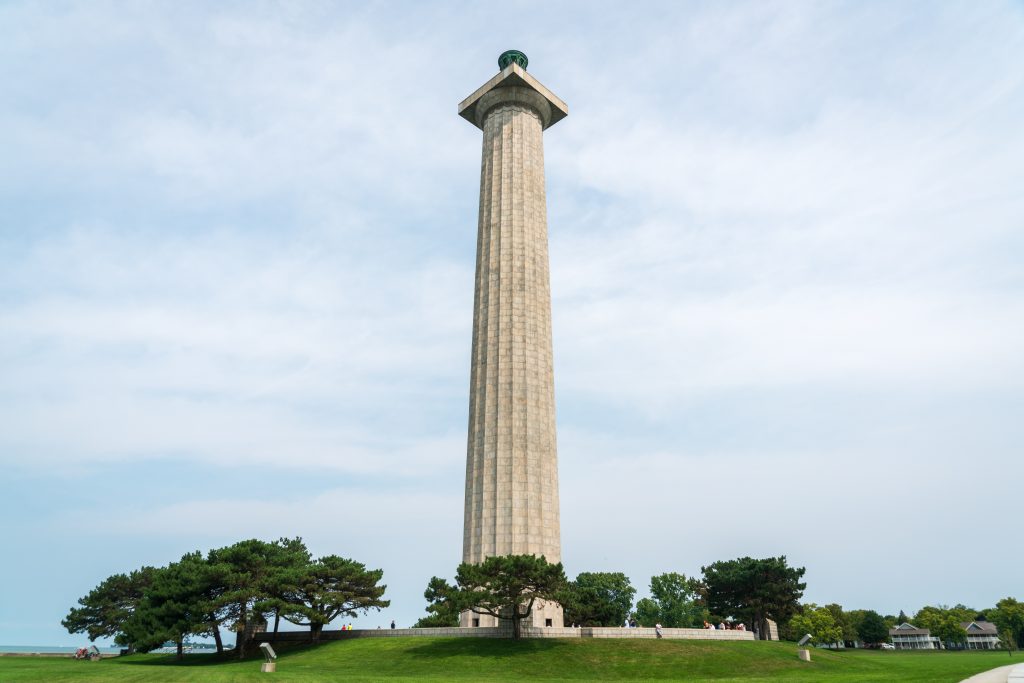
In 1853 Commodore Matthew C. Perry (grandson of Admiral Oliver Hazard Perry, the hero of the Battle of Lake Erie in 1812) sailed into Tokyo Bay with a small fleet of “black ships” and demanded that Japan open its ports to trade. Aware of the defeat of China at the hands of the British in the recent Opium War, Japan signed treaties with the United States of America in 1854, and a host of other countries including Great Britain, France, Holland, and Russia soon after. These treaties demanded clauses related to “most-favored nation,” which allowed any privileges extended by Japan to any one of the foreign powers to be extended to them all. Townshend Harris (played by John Wayne in the 1960s film “The Barbarian and the Geisha”), the first American diplomat to live on Japanese soil, gradually improved relations between the US and Japan. Nevertheless, as foreign legations were established throughout the land, humiliating incidents occurred, and a movement began to “Revere the Emperor; expel the barbarian!” Eventually an event involving the murder of a British merchant stimulated Britain to fire on a Japanese port. Seeing the power of British guns first-hand, the local daimyo befriended the British captain and Japan was on its way to imitating the British navy.
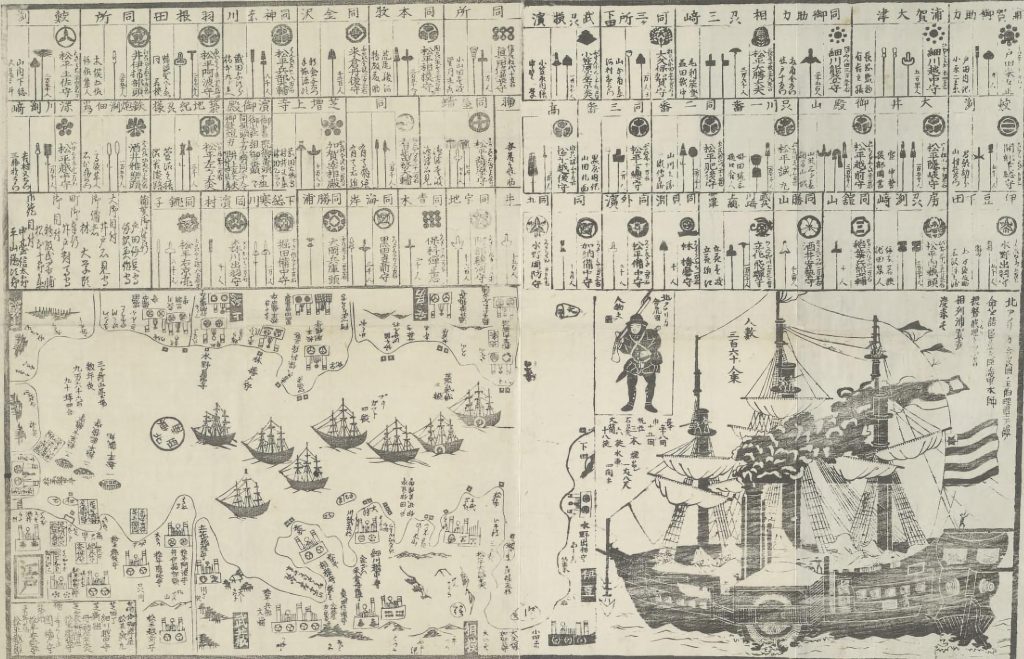
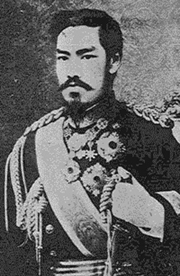
Ultimately, the Tokugawa shogunate was blamed for signing treaties with the foreigners, and a movement among the nobles—many of them descendants of the “outer” daimyo sent to the fringes by Tokugawa Ieyasu 250 years earlier—eventually swept the last shogun from power. In 1868, a young emperor, aged 16, was set on the throne and with a group of enlightened advisors set out to beat the foreigners at their own game. The new reign was called Meiji. From this time on, Japanese history would be divided into periods with dates based on the reigns of the individual emperors.
Within a few years, a Western-style navy (copying Britain), army (copying Prussia), industry, banking, legal, and parliamentary systems were eventually introduced. The government also moved to set up railroads, textile mills, and other industries which were in some cases later turned over to the private sector. These changes were largely financed by increasing the tax burden on peasants and merchants, rather than by accruing huge foreign loans. Though Neo-Confucianism was for a time influential in promoting the role of the emperor, Shinto was adopted as a state religion in that the emperor was literally seen as descending from the early kami.
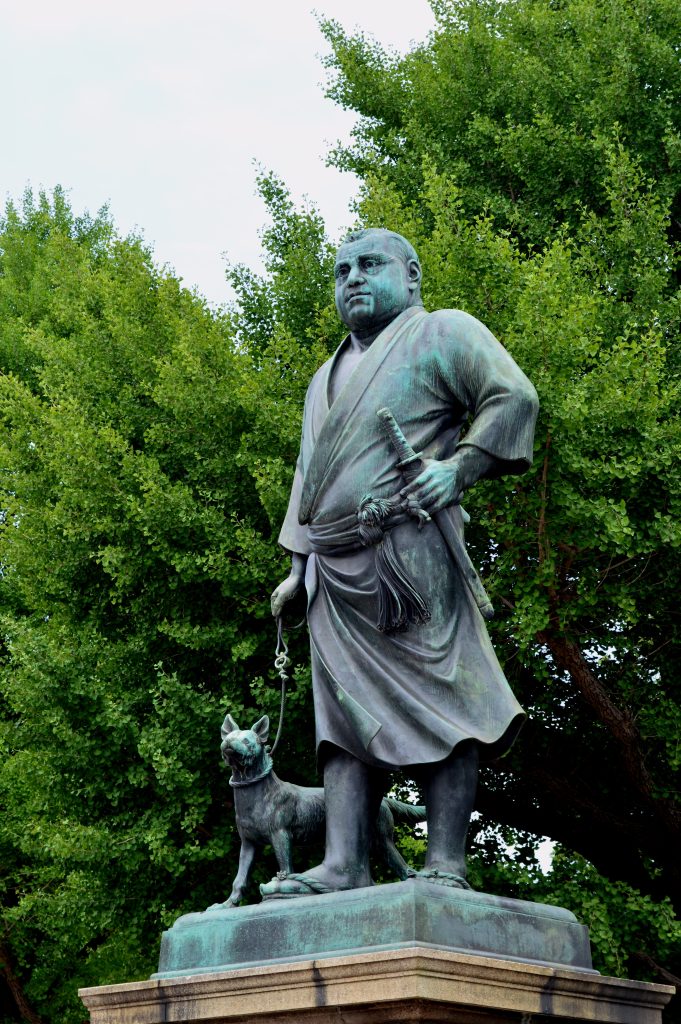
In a backlash to these sudden changes, a group of samurai staged the so-called Satsuma Rebellion in 1877. This rebellion was an attempt to save the faltering status of the samurai class, which was being made irrelevant by the new conscript army armed with its modern firearms and cannons. The Rebellion’s leader, Saigo Takamori, the once-loyal adviser to the emperor, committed suicide on the battlefield in a final fray between modern troops and mounted samurai warriors—an event similar to that depicted in Edward Zwick’s 2003 film, The Last Samurai.
By 1895 Japan had defeated China in a series of land and sea battles around the Korean peninsula known as the Sino-Japanese War. The victory allowed Japan to gain a foothold in Korea and influence on the nearby Liaodong Peninsula of China. In 1905, the Japanese won a major war against imperial Russia on the Liaodong Peninsula that was fought over a new railroad, timber, and seaports in Manchuria—a very strategic corner of East Asia. Casualties were extremely high on both sides—over 20,000 in some battles—due to mechanized firearms and mass, suicidal charges by Japanese troops still motivated by a samurai ethics that regarded surrender as dishonorable. Beginning with a surprise attack on the Russian navy, the deciding battle in the Tsushima straits, located between Korea and Japan, resulted in a crippling Russian loss of 33 out of 35 ships sunk—effectively neutering Russian naval influence in East Asia. In many ways this war was a harbinger for Japanese military actions up through the end of World War II. And, according to some, it may in part explain the Japanese miscalculation to attack Pearl Harbor in 1941.
As a result of their 1905 victory and the impending collapse of the Qing dynasty in China, Korea was colonized by the Japanese in 1910. Although a democratic, parliamentary society was being created in Japan in the early decades of the 20th century, with universal male suffrage established in 1925, the world-wide Great Depression in the early 1920s helped a radical wing of the Japanese military rise to power. Powerful government-supported companies called zaibatsu aided in creating an effective and modern war machine, unlike anything seen outside of Europe and the United States during World War I.
By the mid-1920s, imperial Japan had extended itself further into Manchuria. By the mid-1930s a full-scale Japanese invasion of China was underway. By the early 1940s the powerful Japanese navy, army, and air forces had enabled Japan to take control of most of the former European colonies in East Asia, Southeast Asia, and the Pacific Islands. Japan was also positioned to threaten Australia. Repeating a miscalculation reminiscent of Hideyoshi’s attempted invasions of China in the 16th century, Japan launched a surprise naval and aerial attack on the United States territory at Pearl Harbor, Hawaii in late 1941. The attack was triggered in response to US embargos over oil and the materials that fueled Japan’s war machine.
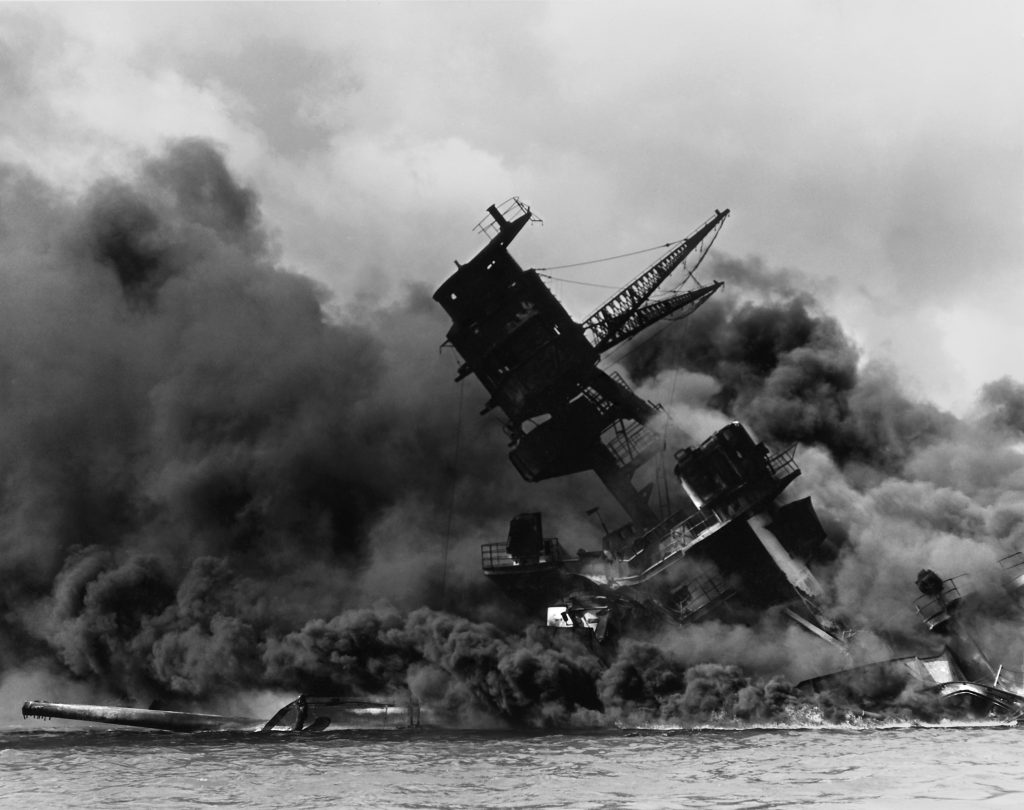
Though its naval forces were weakened by the Pearl Harbor attack, the US forces fought back with unexpected resolve across the Pacific islands. Despite fierce and bloody resistance from the Japanese military, which in its final stages employed masses of suicide airplane pilots known as kamikaze, Japan’s ambitions of empire ended in August 1945, with the US and the Soviet Union competing to accept the Japanese surrender in northeast East Asia. Japan’s ultimate surrender was hastened by the controversial use by the United States of the newly created atomic bomb on the cities of Nagasaki and Hiroshima, with massive civilian casualties.
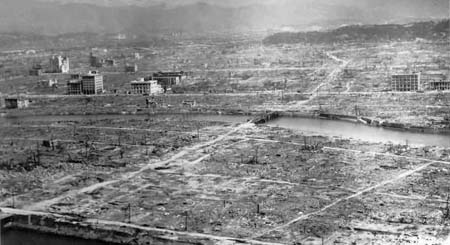
Post-War Japan was occupied for seven years, from 1945-1952, by Allied Forces under the leadership of the United States General Douglas MacArthur. During this period a new, democratic constitution was adopted that officially ended any Japanese military role in international affairs; businesses were reoriented to peacetime objectives; and the country rebuilt itself, like many other areas in East Asia, after the devastating war. In an interesting twist, the Japanese economy was stimulated by the Korean War, when US forces took out contracts in Japan for military goods. Also, at this time groups of Japanese engineers visited US companies in a systematic effort to modernize production, much as they had learned from China and the West in earlier periods.


Through hard work and determination, Japan reinvented itself in the latter half of the 20th century as a consumer-oriented producer and exporter. It took the lead early on in transistor electronics and innovative automobile design, which benefited from traditional Japanese aesthetics. By the late 1980s Japan was the largest creditor nation on earth, while the US was the largest debtor. With the spread of film, radio, computer games and other electronic devices produced in the country, Japanese popular culture has a worldwide influence.
Japan’s economic growth became a model and a stimulus for other countries such as Hong Kong, Taiwan, Singapore, South Korea, Southeast Asian nations, and eventually the People’s Republic of China (and possibly North Korea, in the future). Although old wounds sometimes still surfaced, a new age of growth and prosperity had arrived in East Asia by the late 1980s.
Japan has had a stagnant economy since the burst of the “economic bubble” in 1989, however, though in recent years the country has been making exciting advances in artificial intelligence and robotics, as well as digital technology and innovations regarding global climate-change issues. Demographically the country is facing the challenge of a “graying society” in which close to 30 percent of its people will soon be over age 65. This is coupled with a plunging birthrate. Under the leadership of conservative Prime Minister Shinzo Abe (served 2006-2007; 2012-2020), Japan has in recent years reasserted itself on the East Asian and global stage. Japan remains a unique and vibrant culture, now dealing with the dynamic cultures of China and Korea as the history of East Asia continues to unfold.
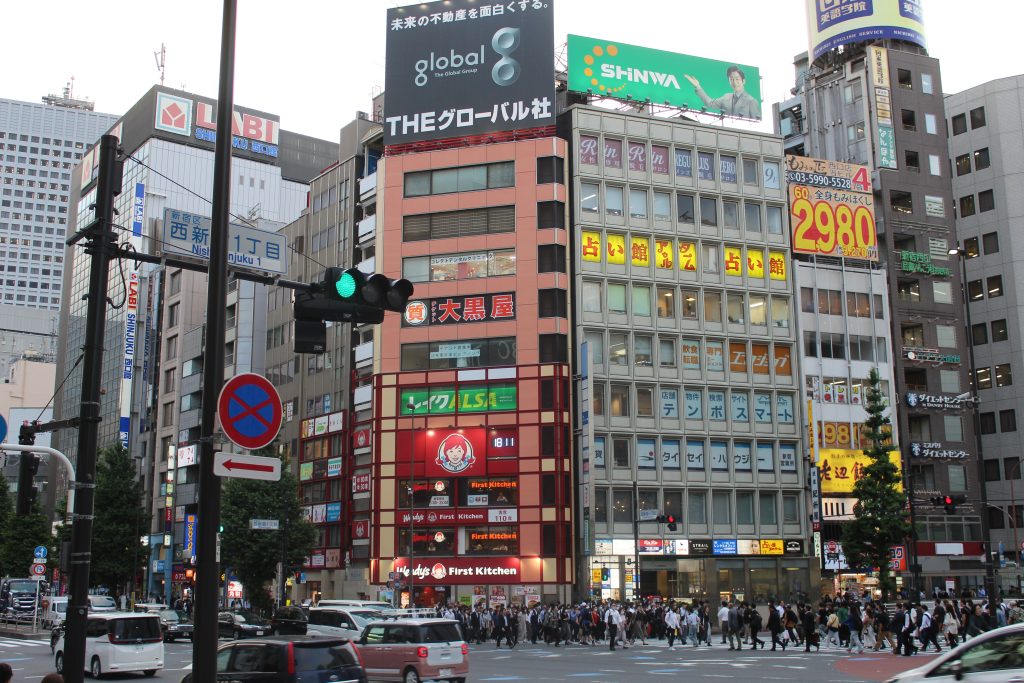

Additional Media Playlist
This Playlist contains links to videos and articles that will enhance your understanding of the written text and offer new insights on East Asian Humanities.
Additional Media Playlist
This Playlist contains links to videos and articles that will enhance your understanding of the written text and offer new insights on East Asian Humanities.
- General History
- Historical Figures
